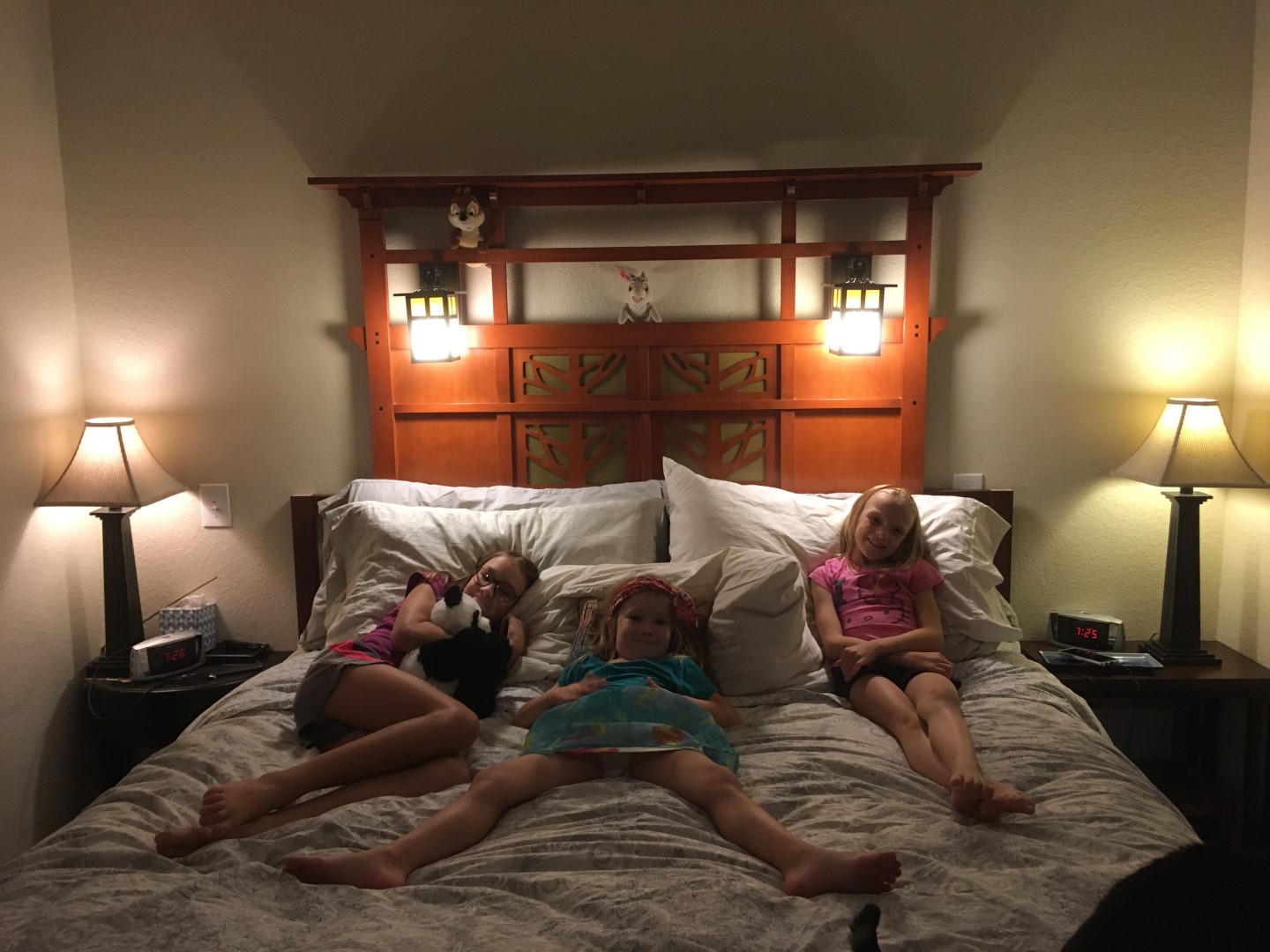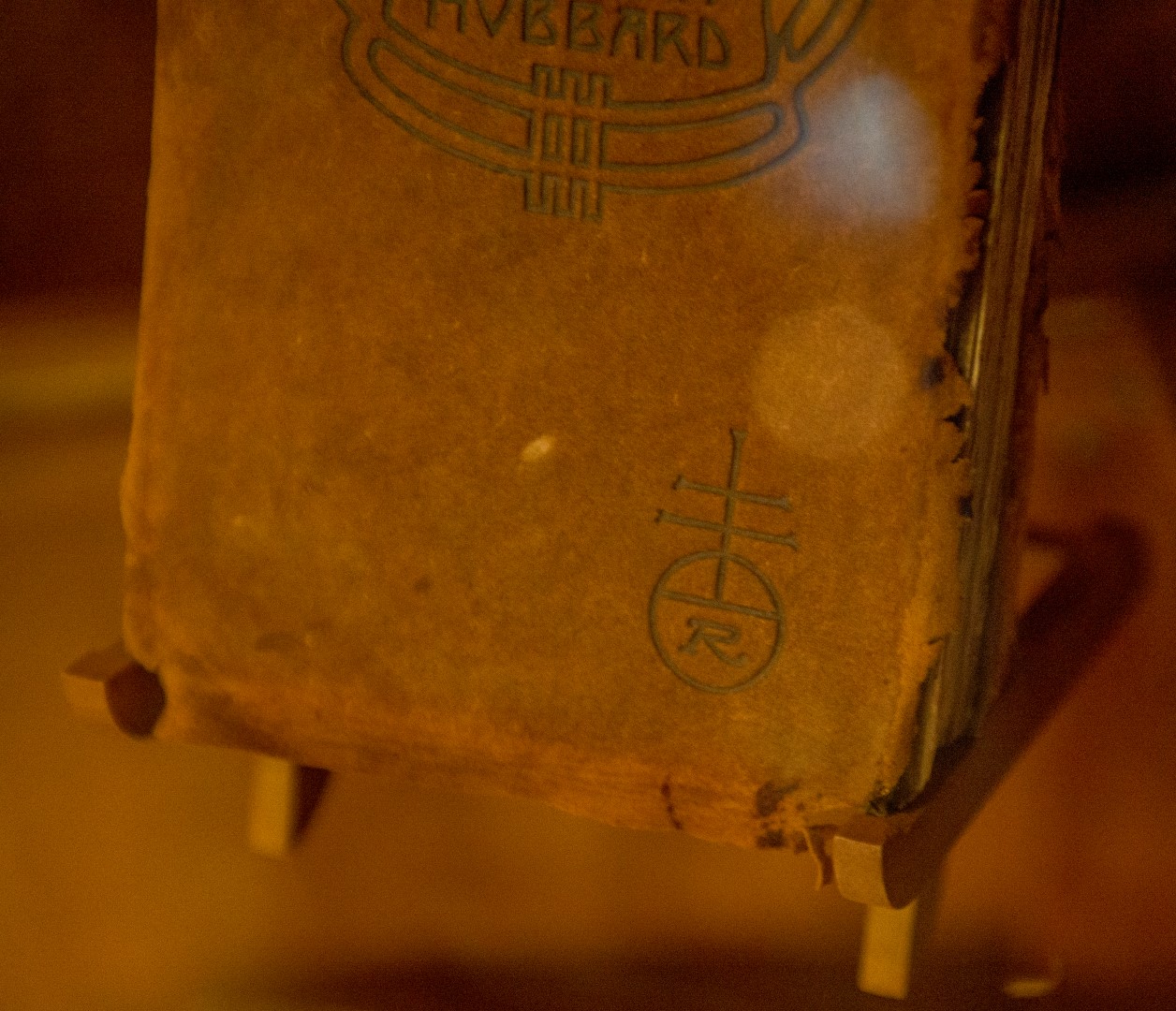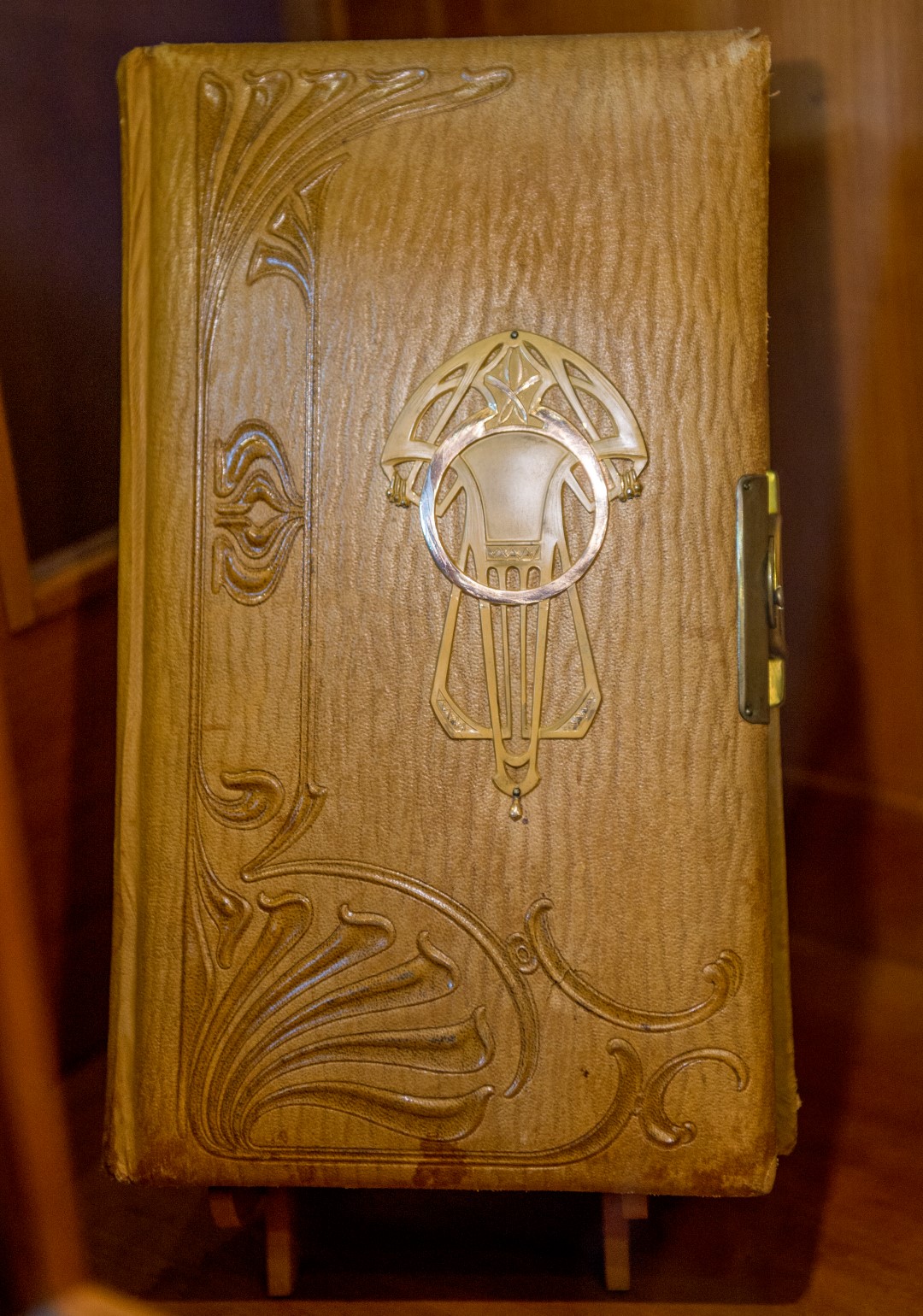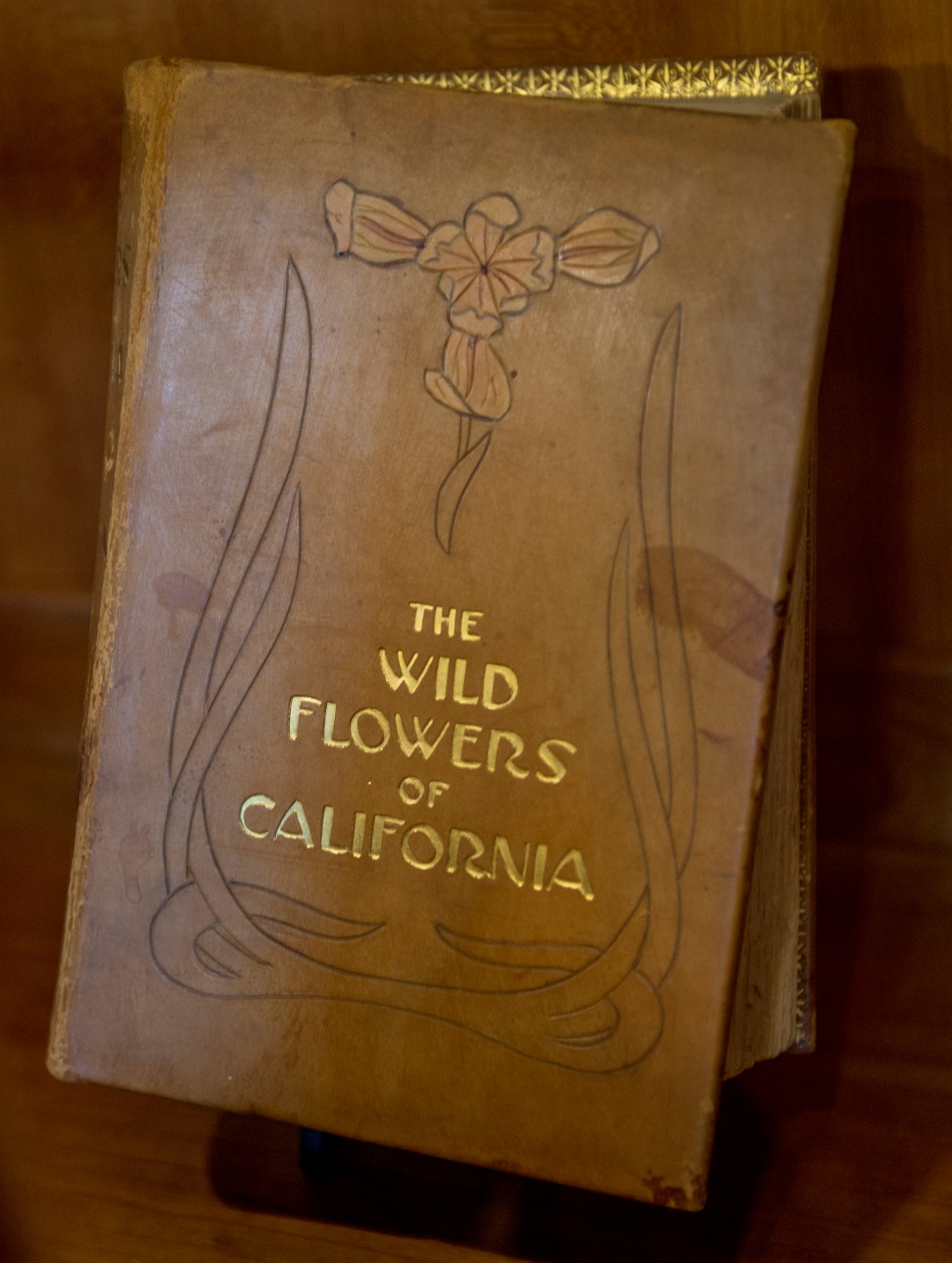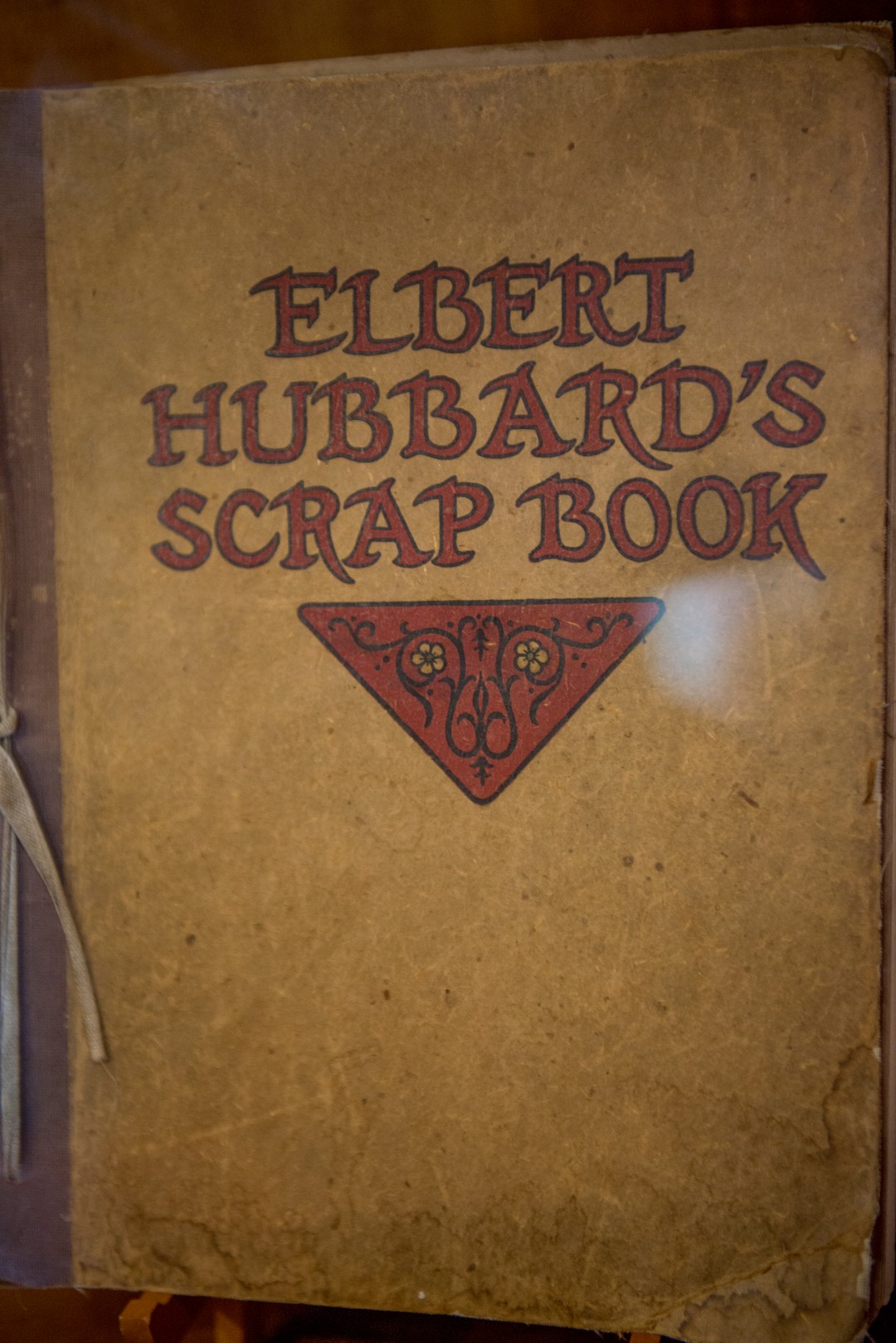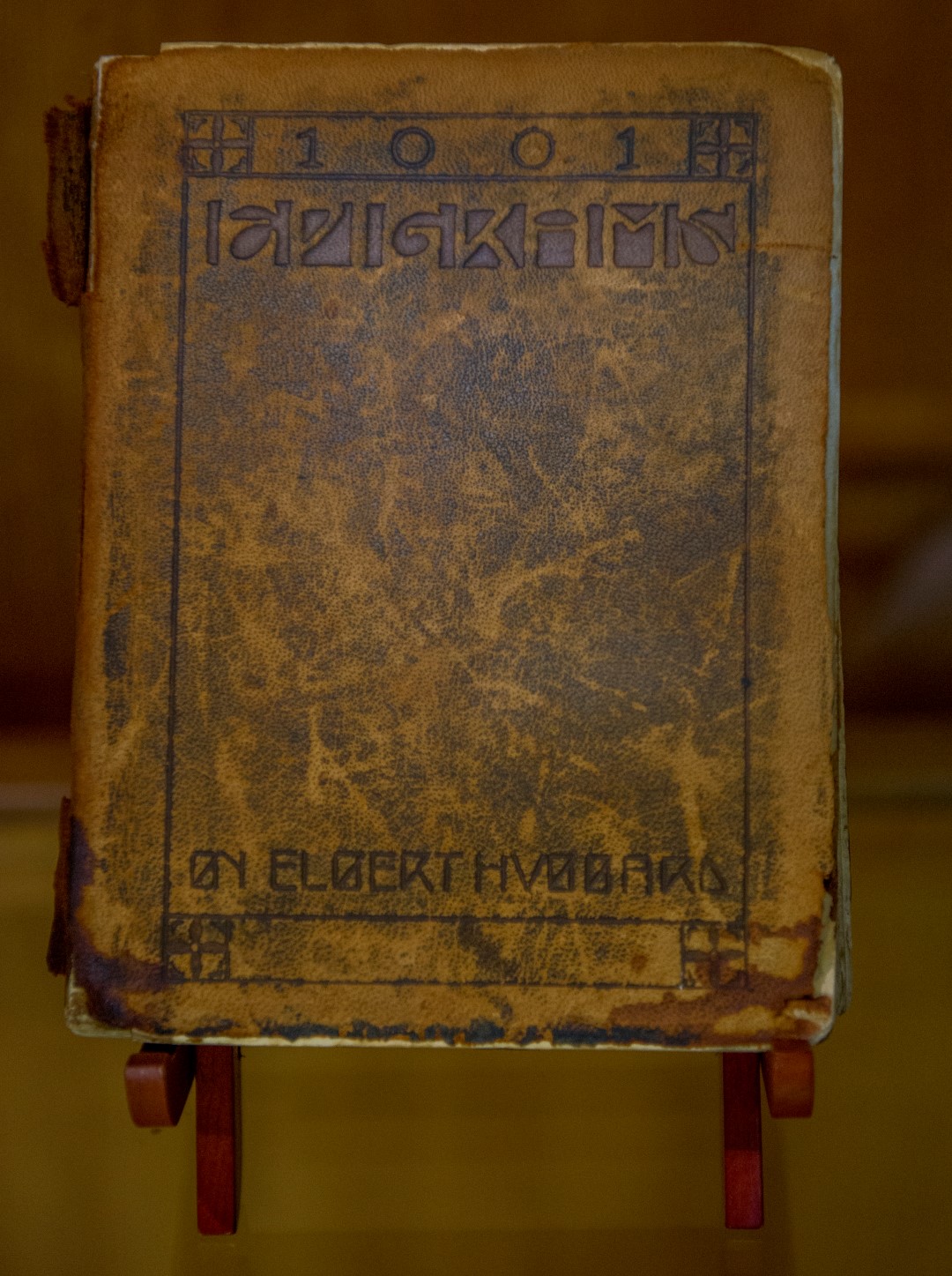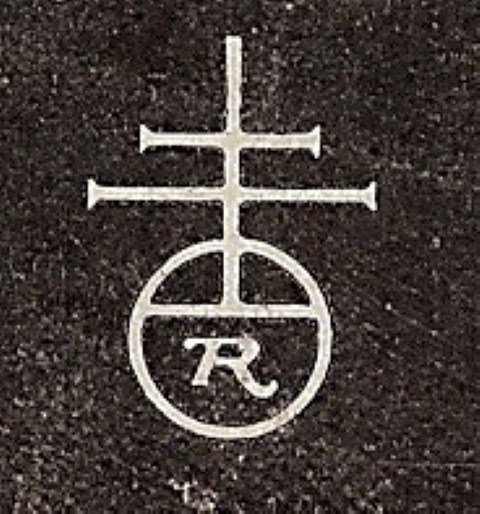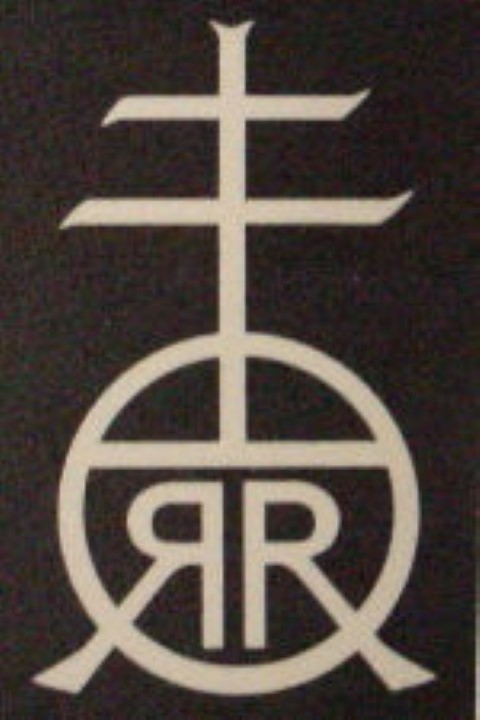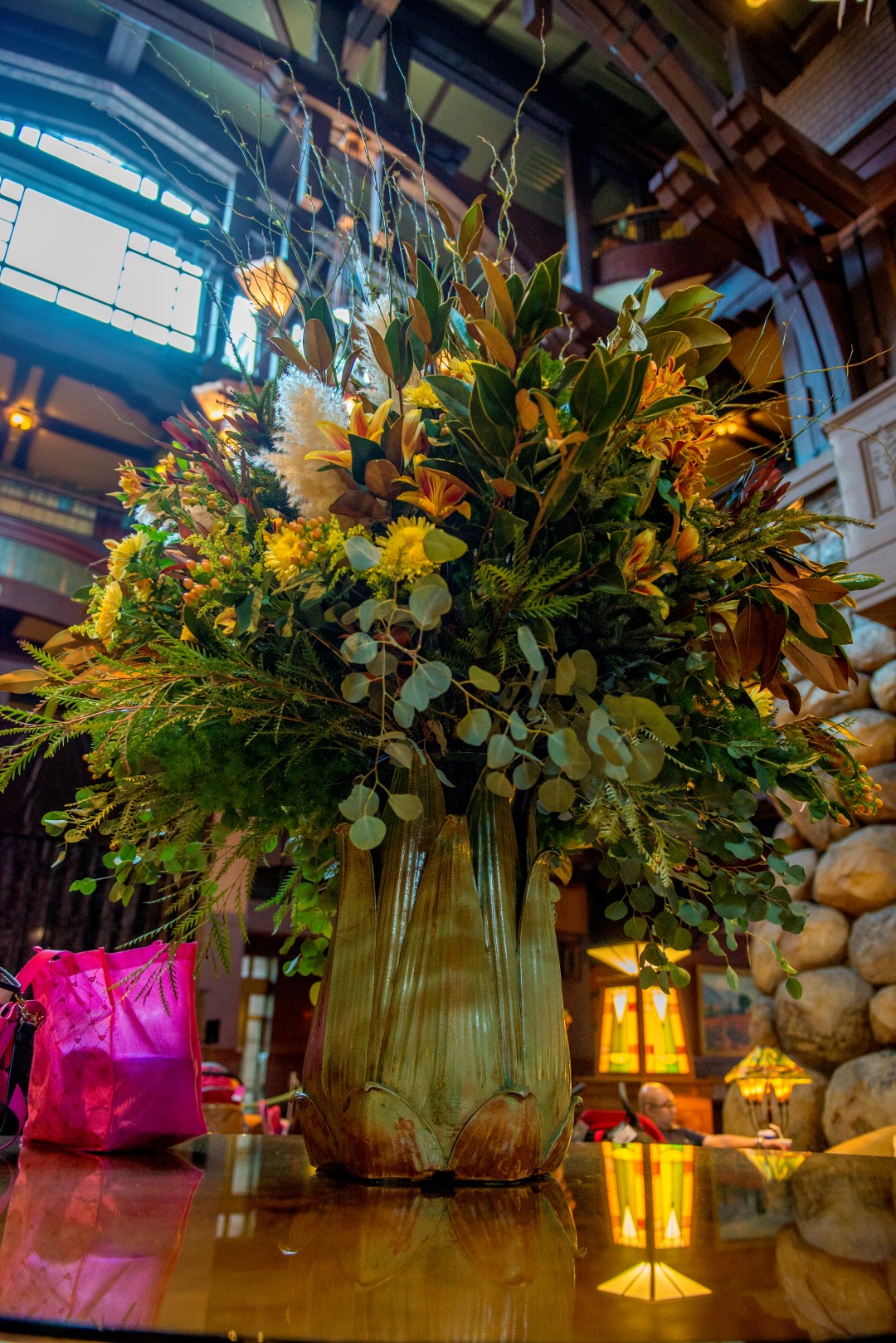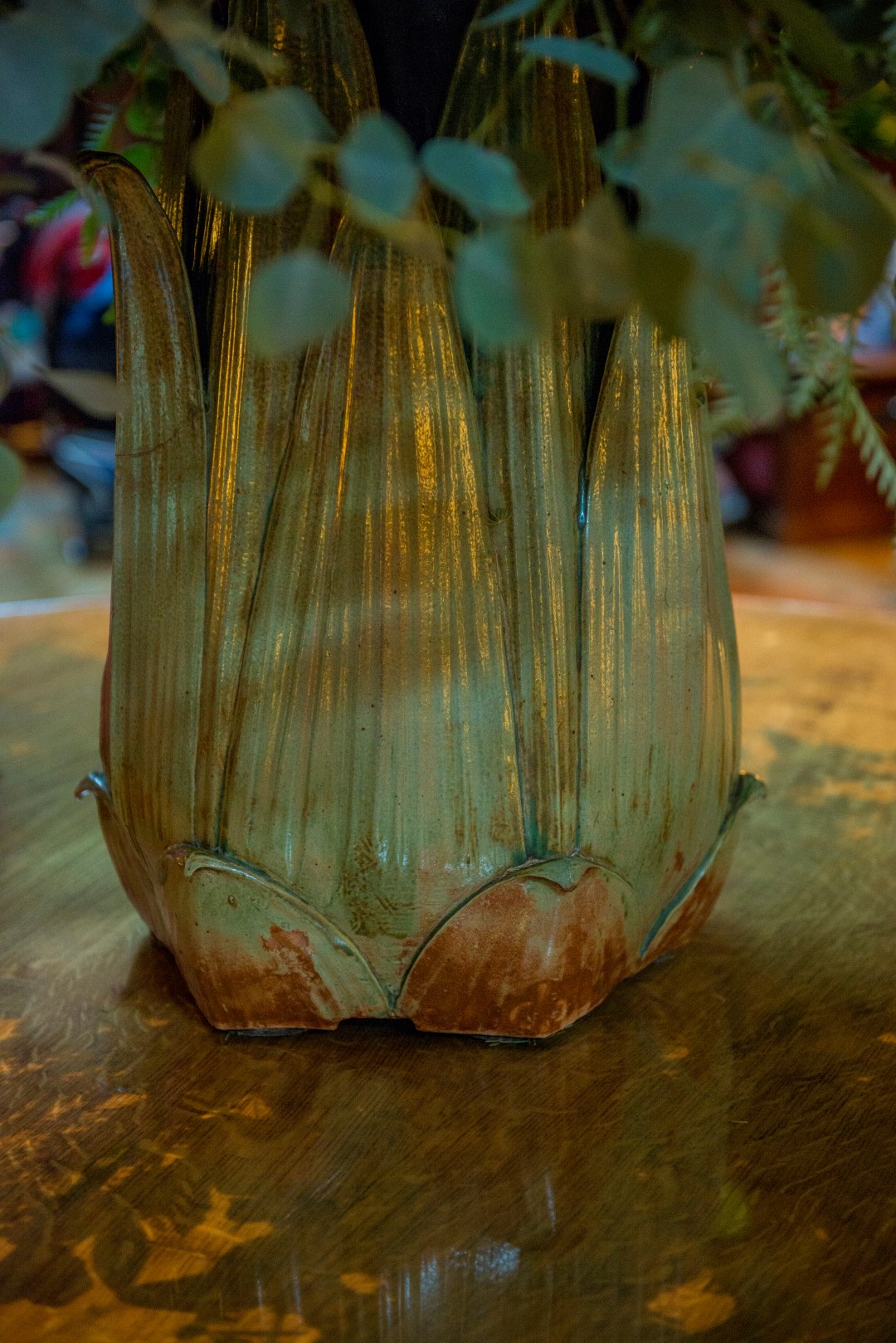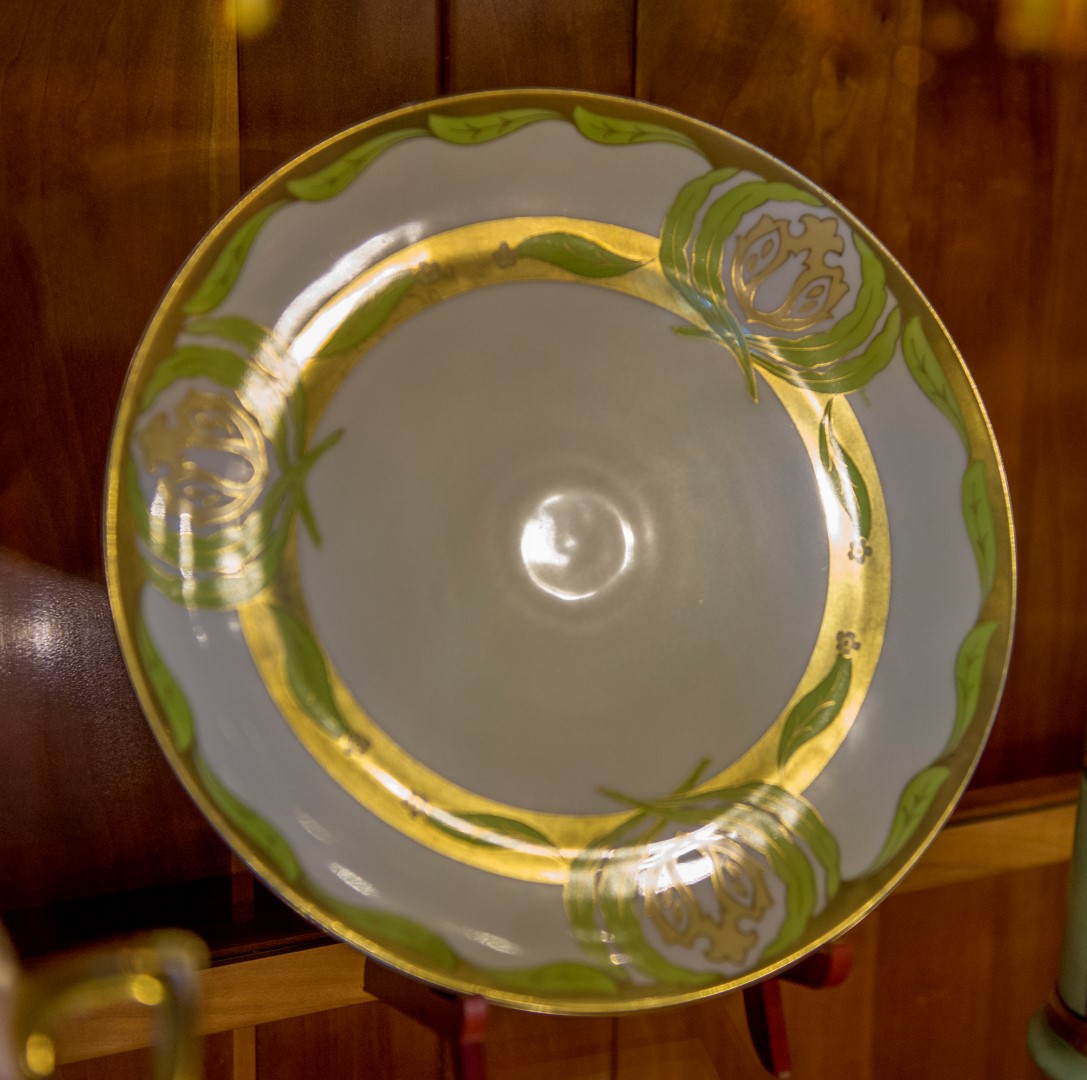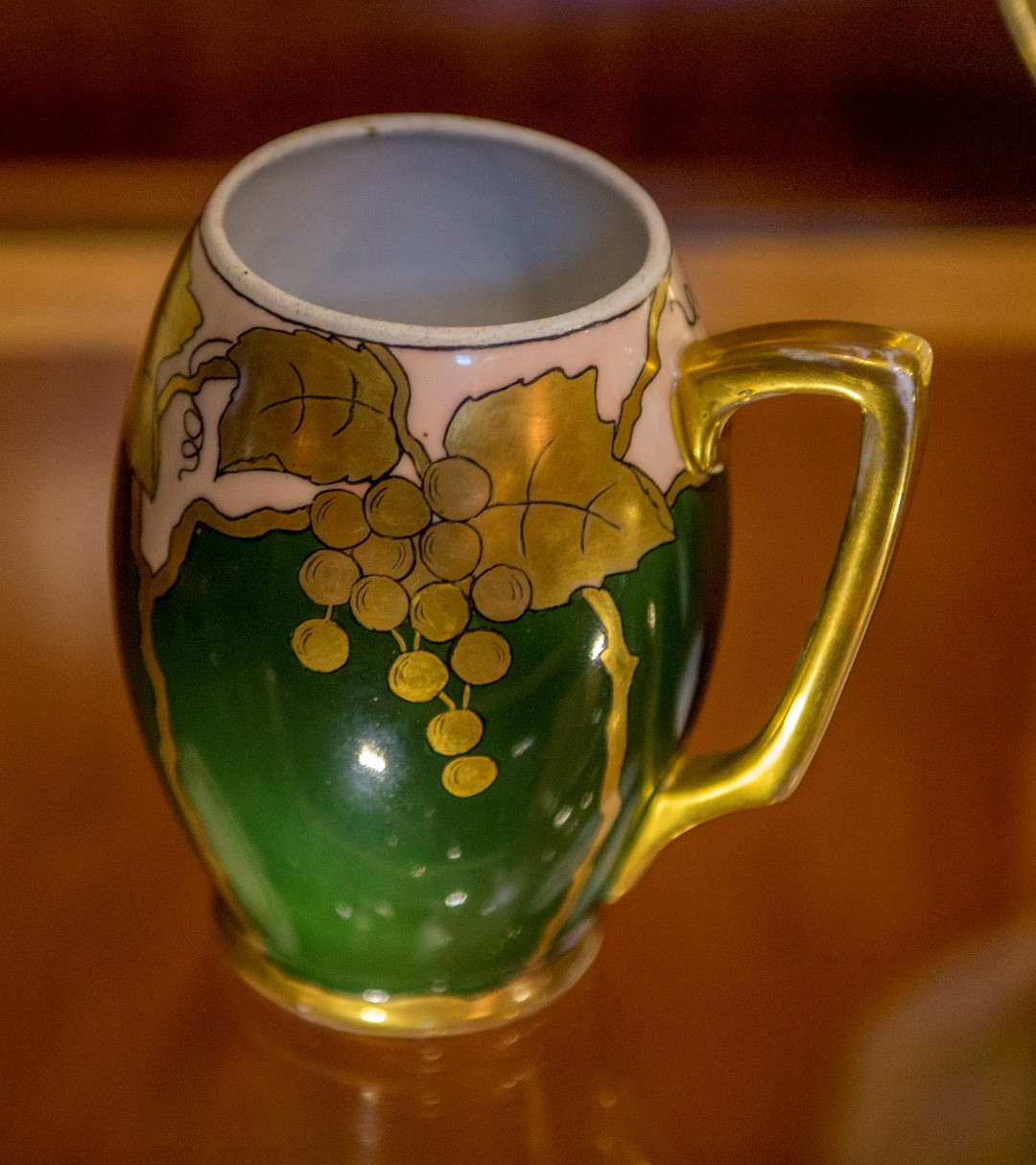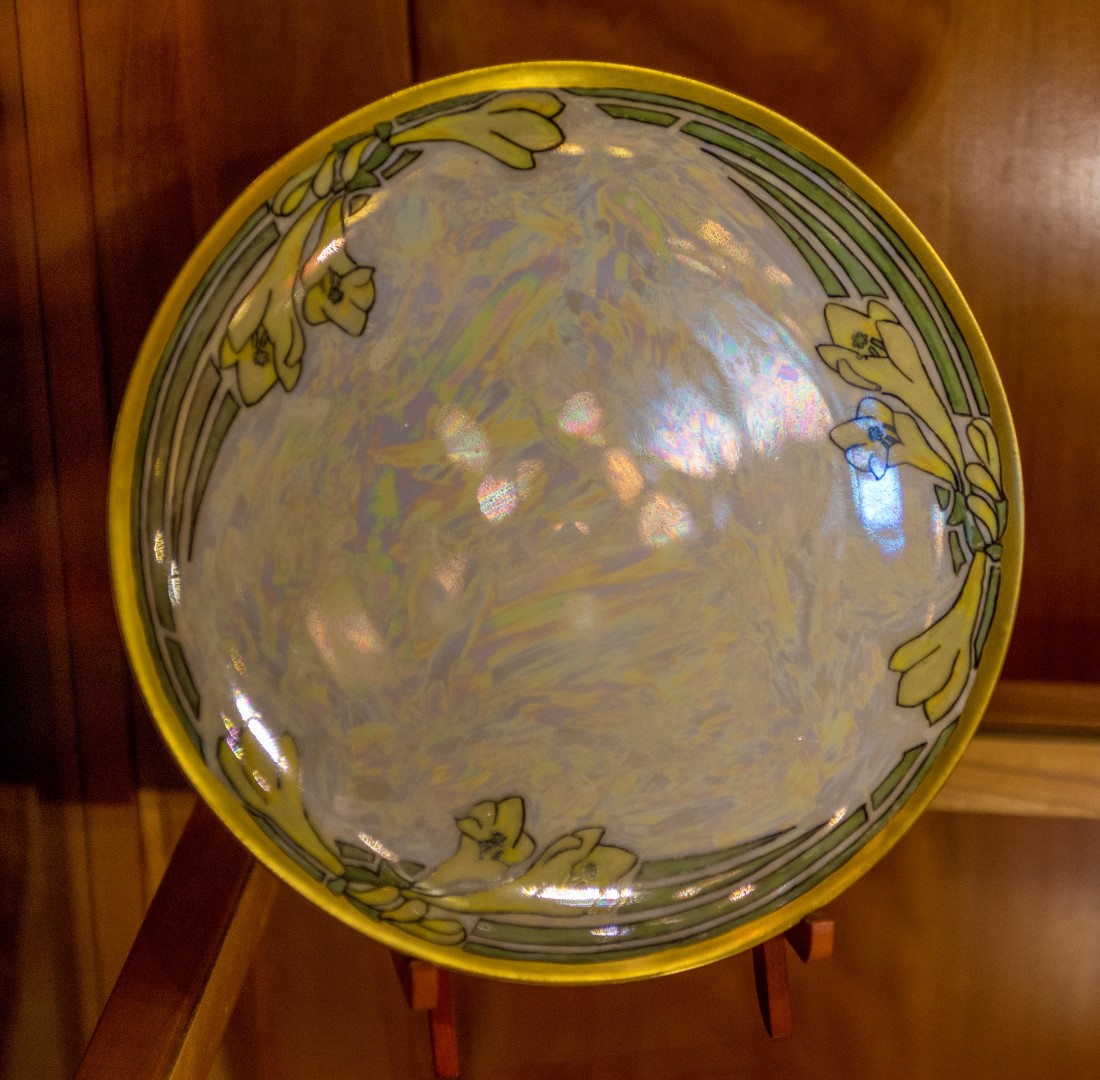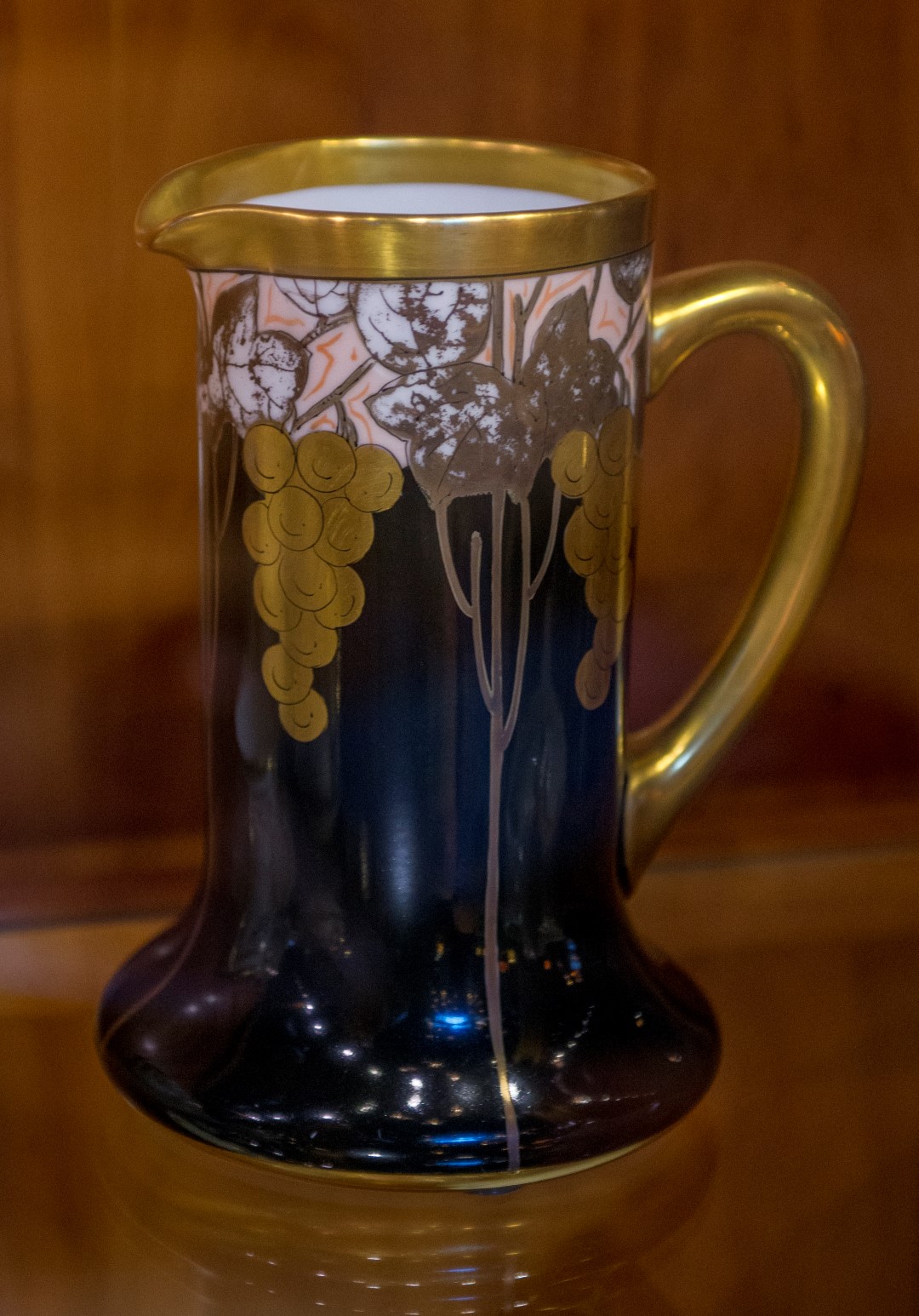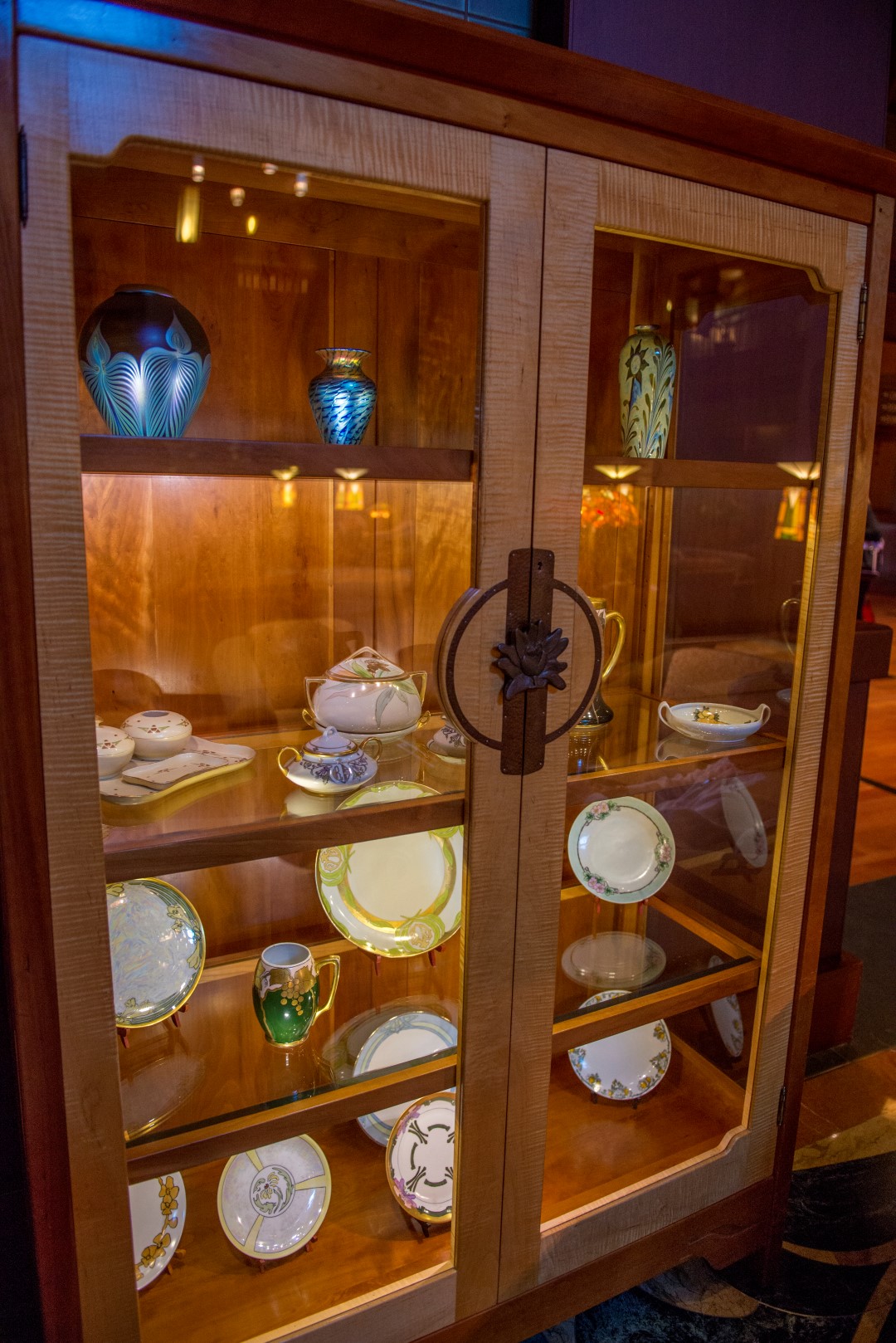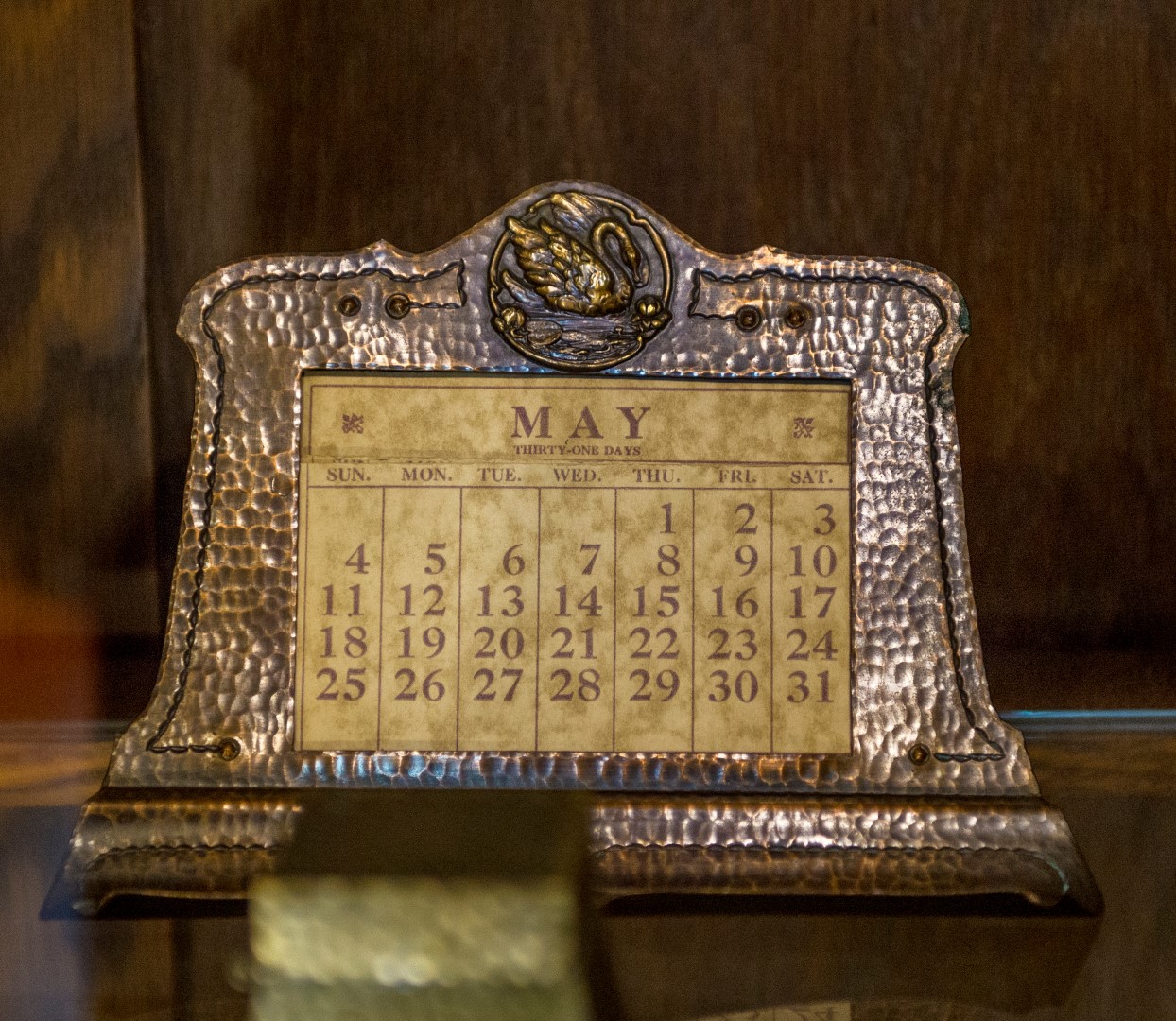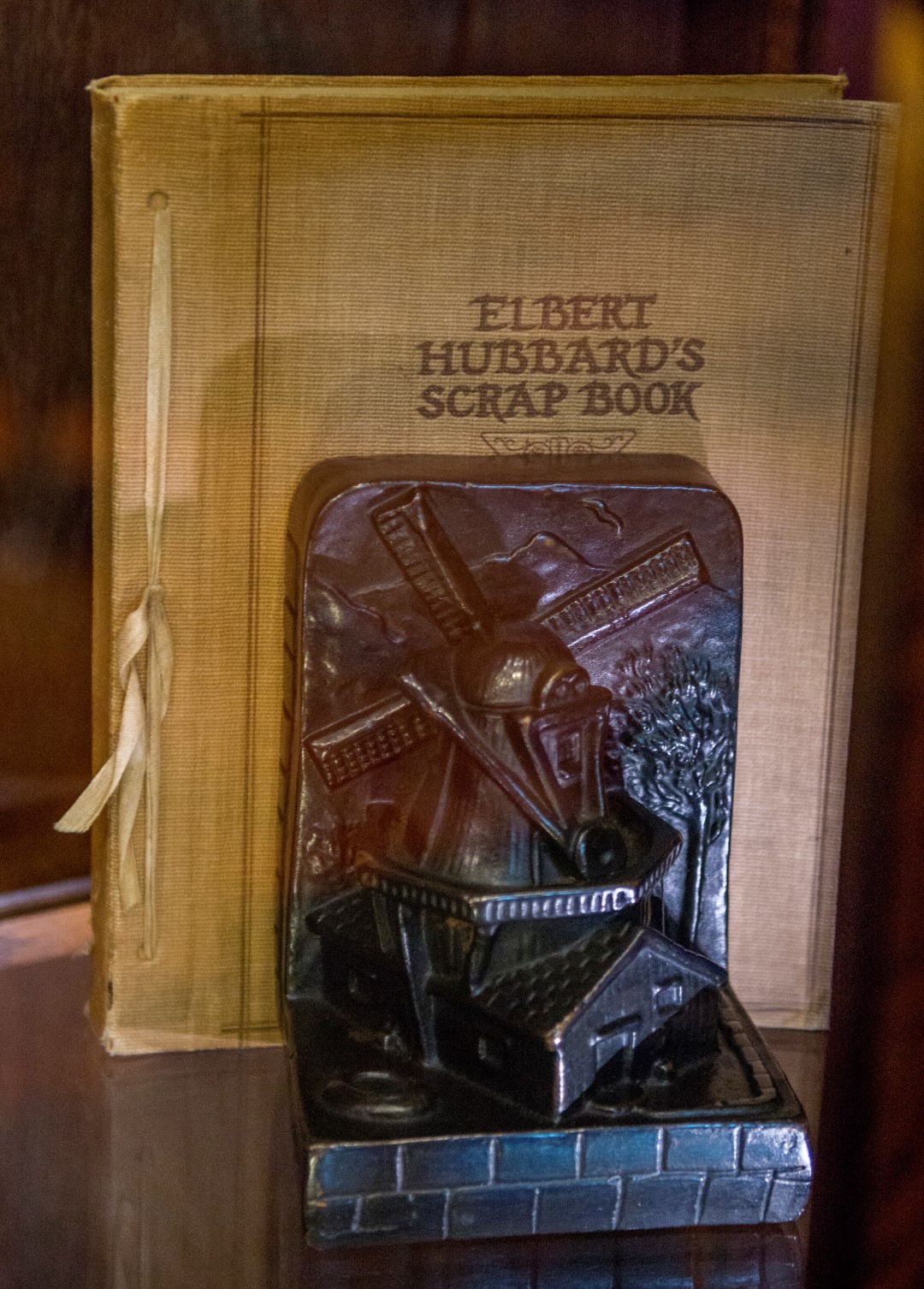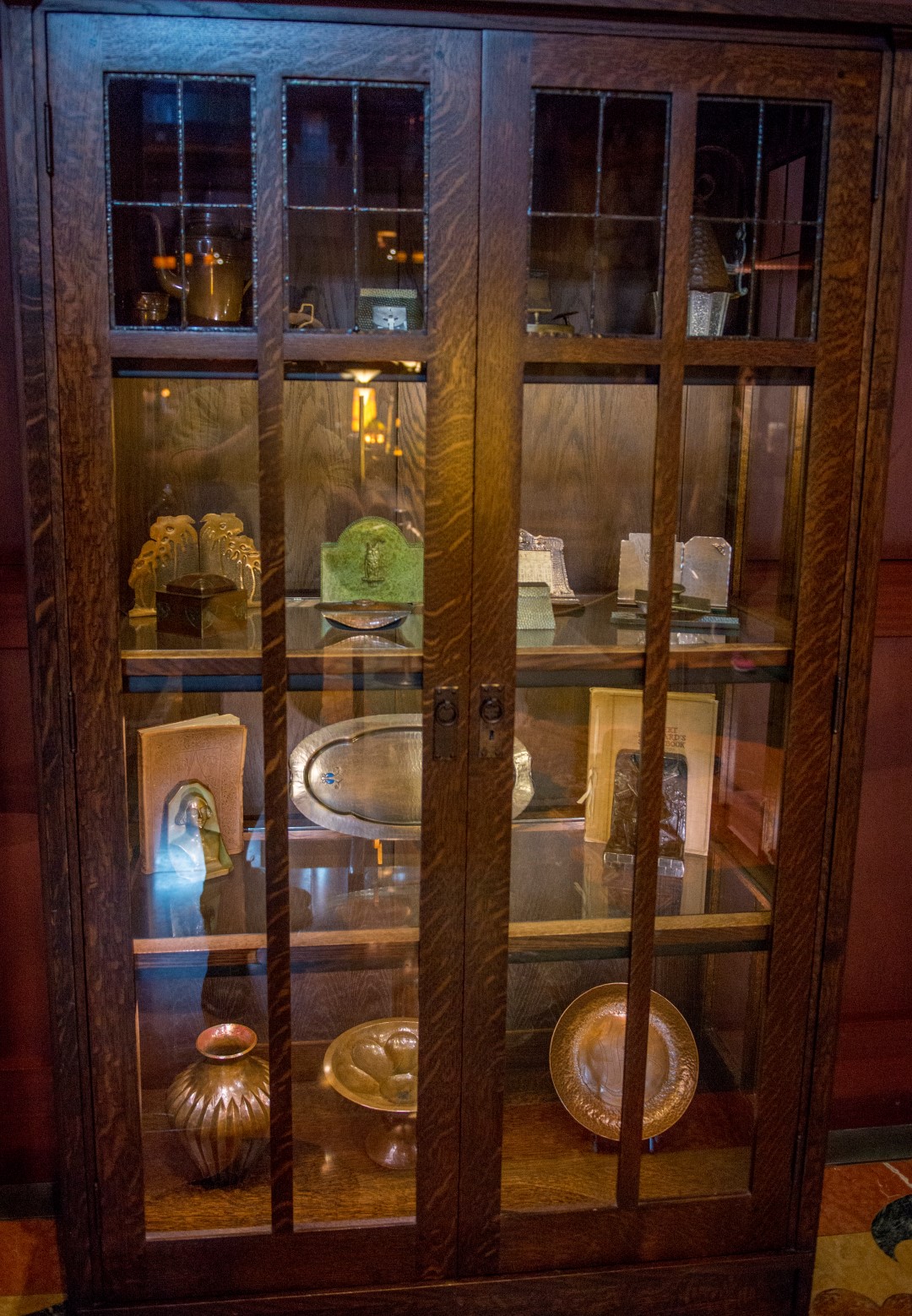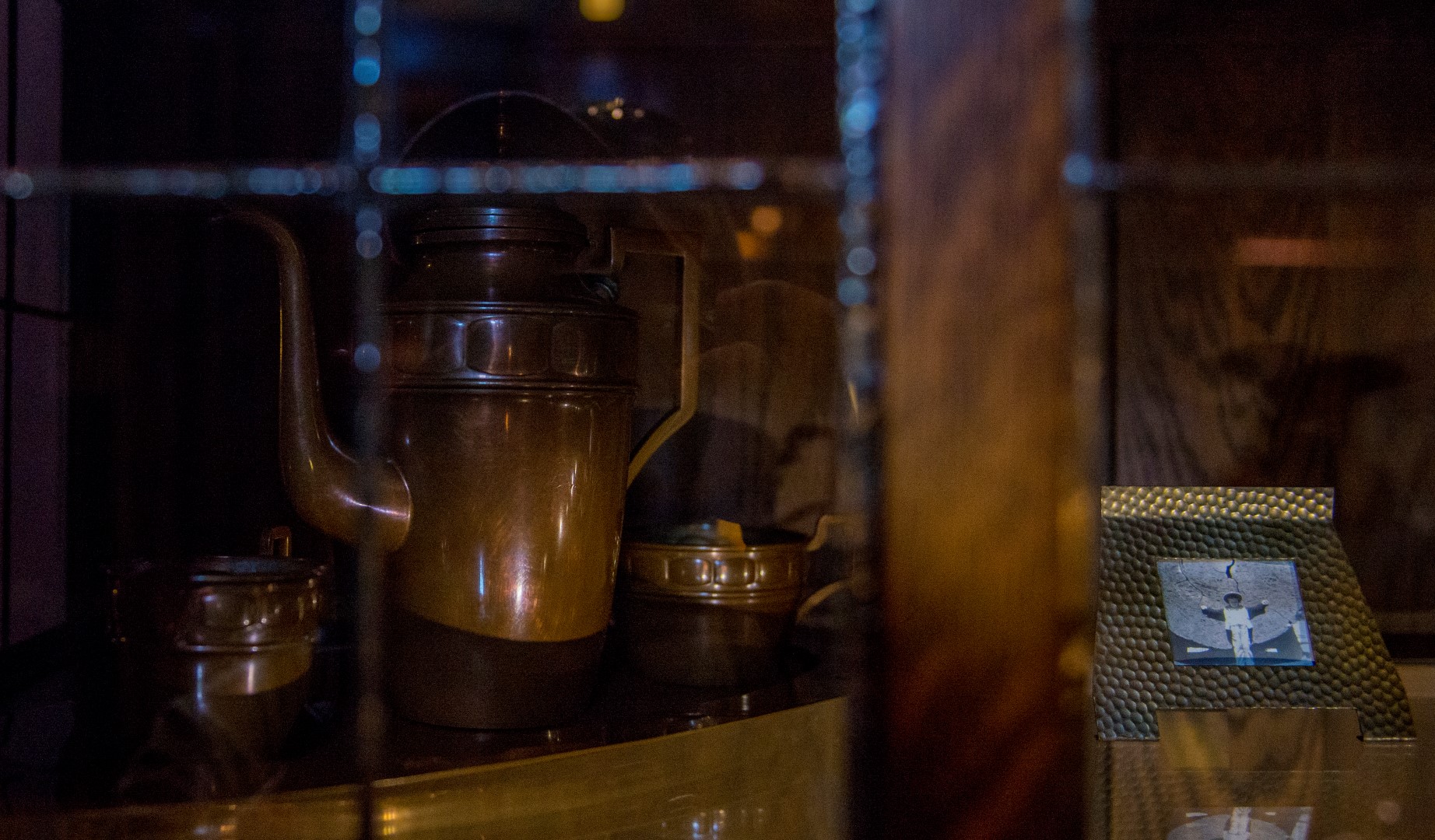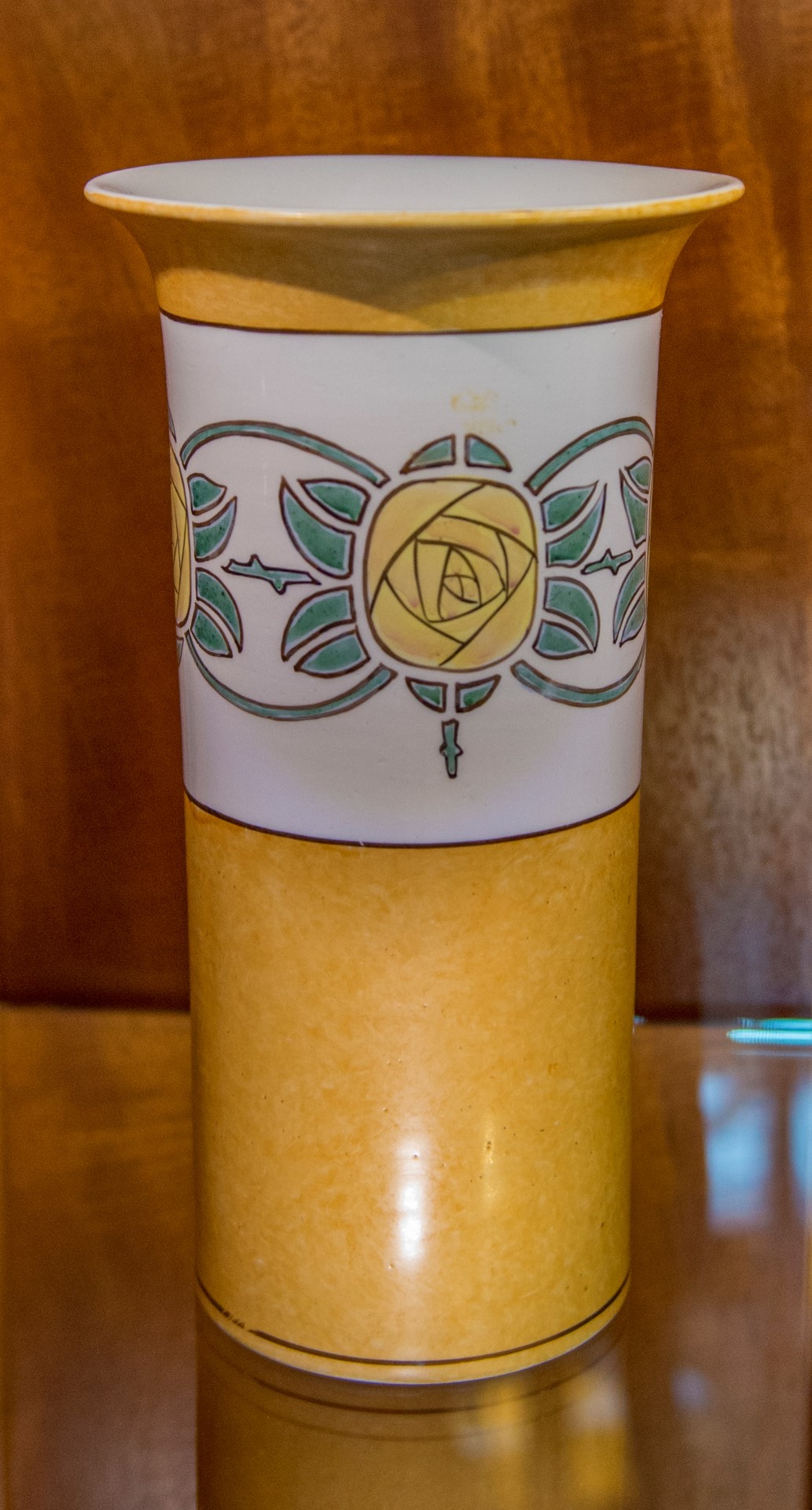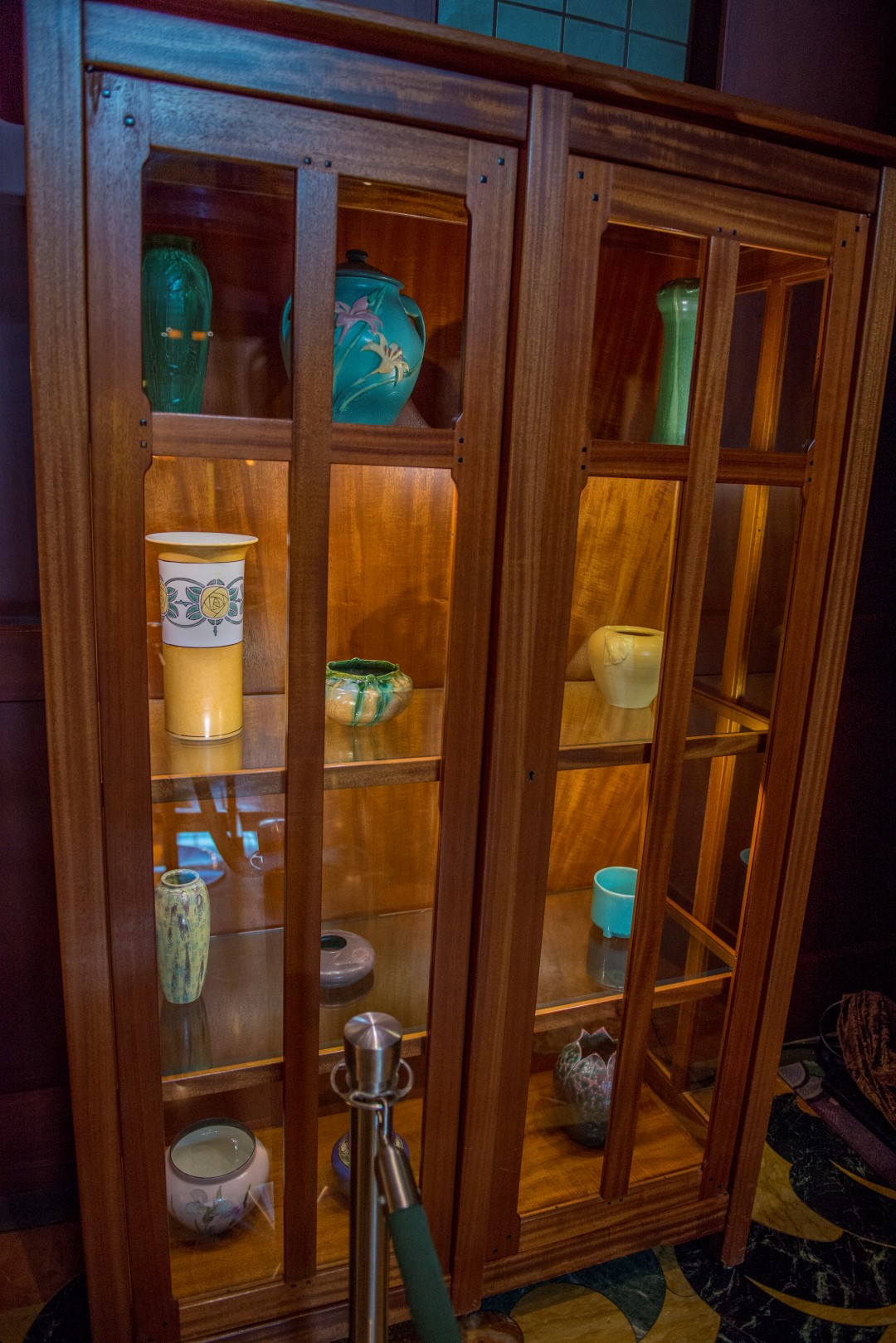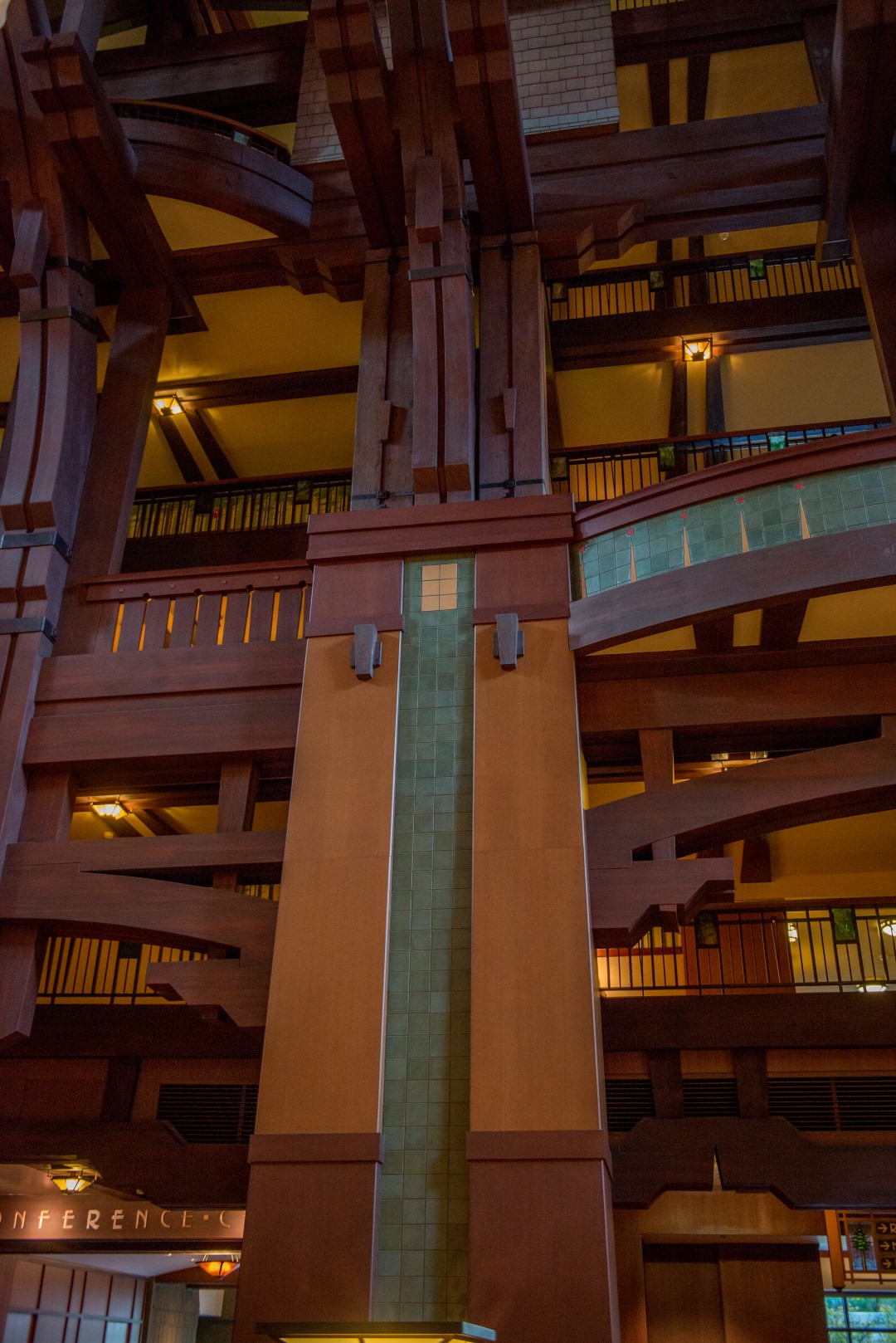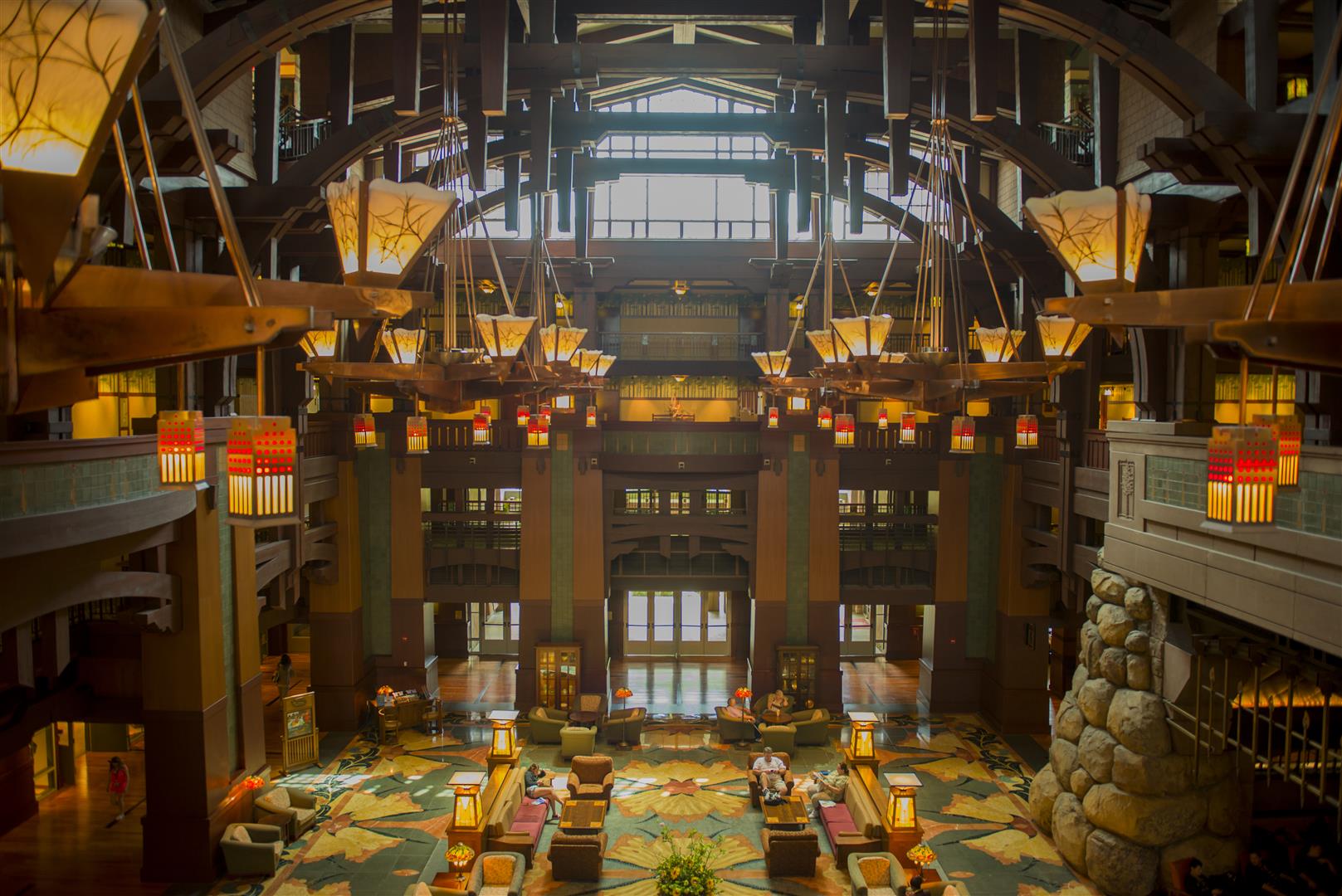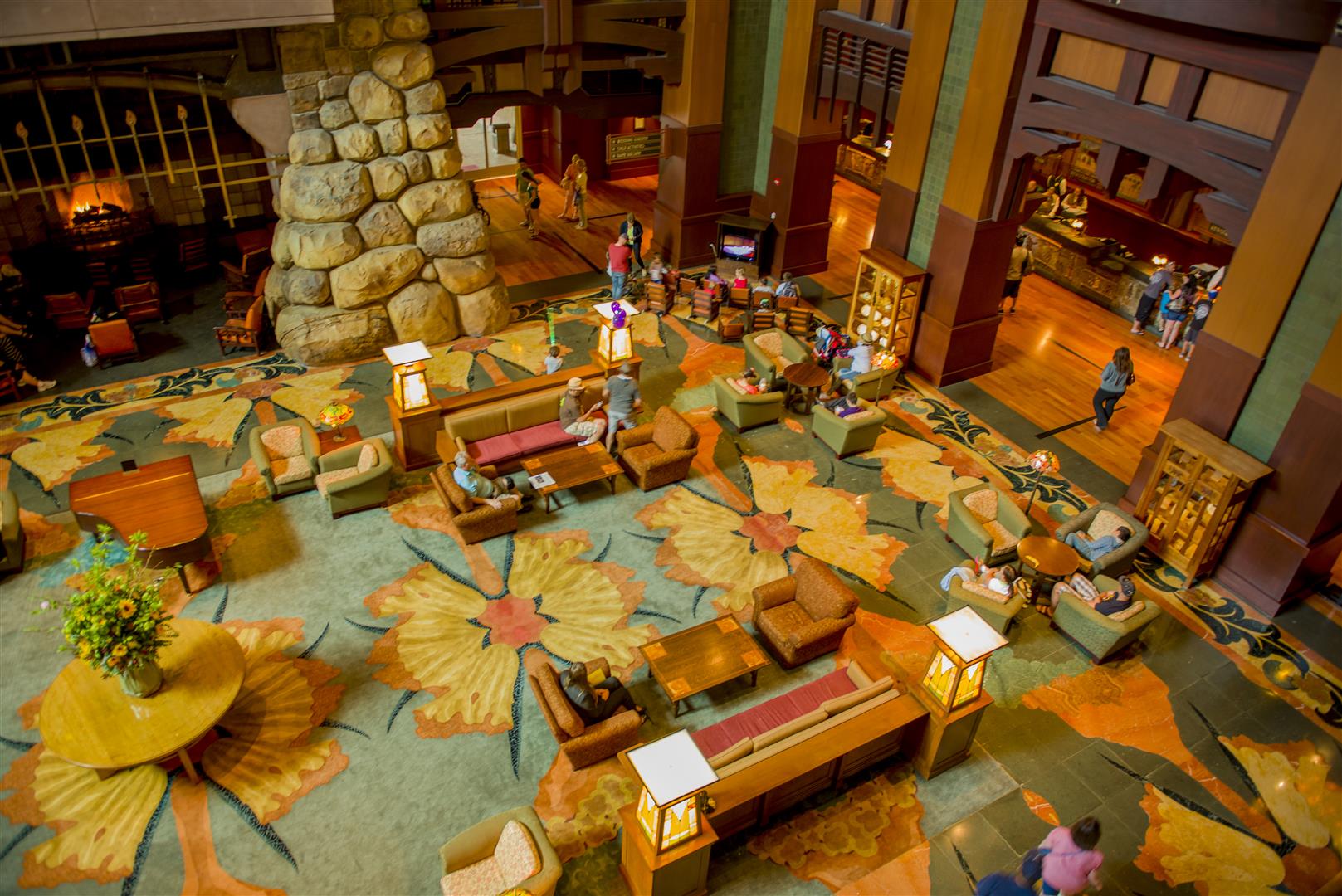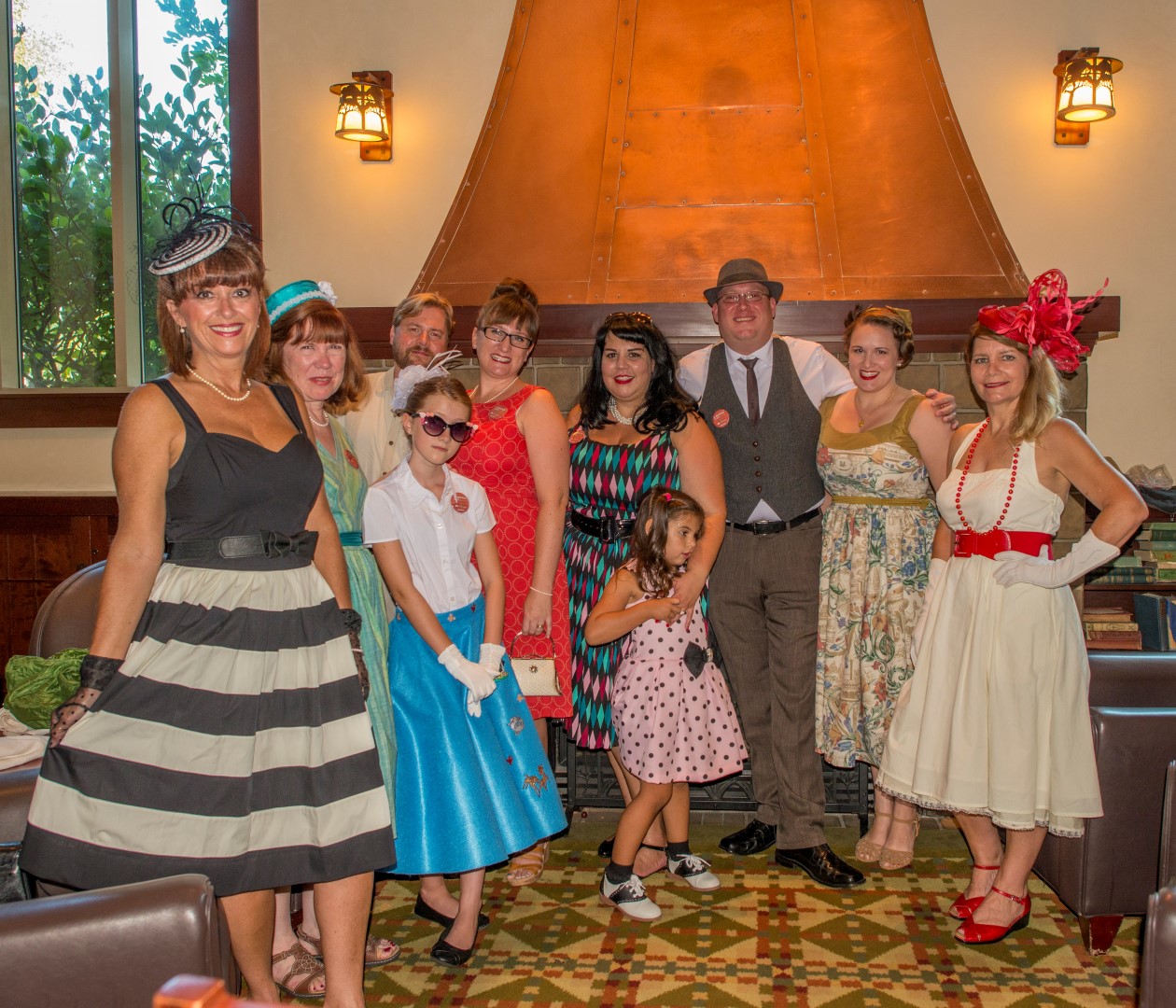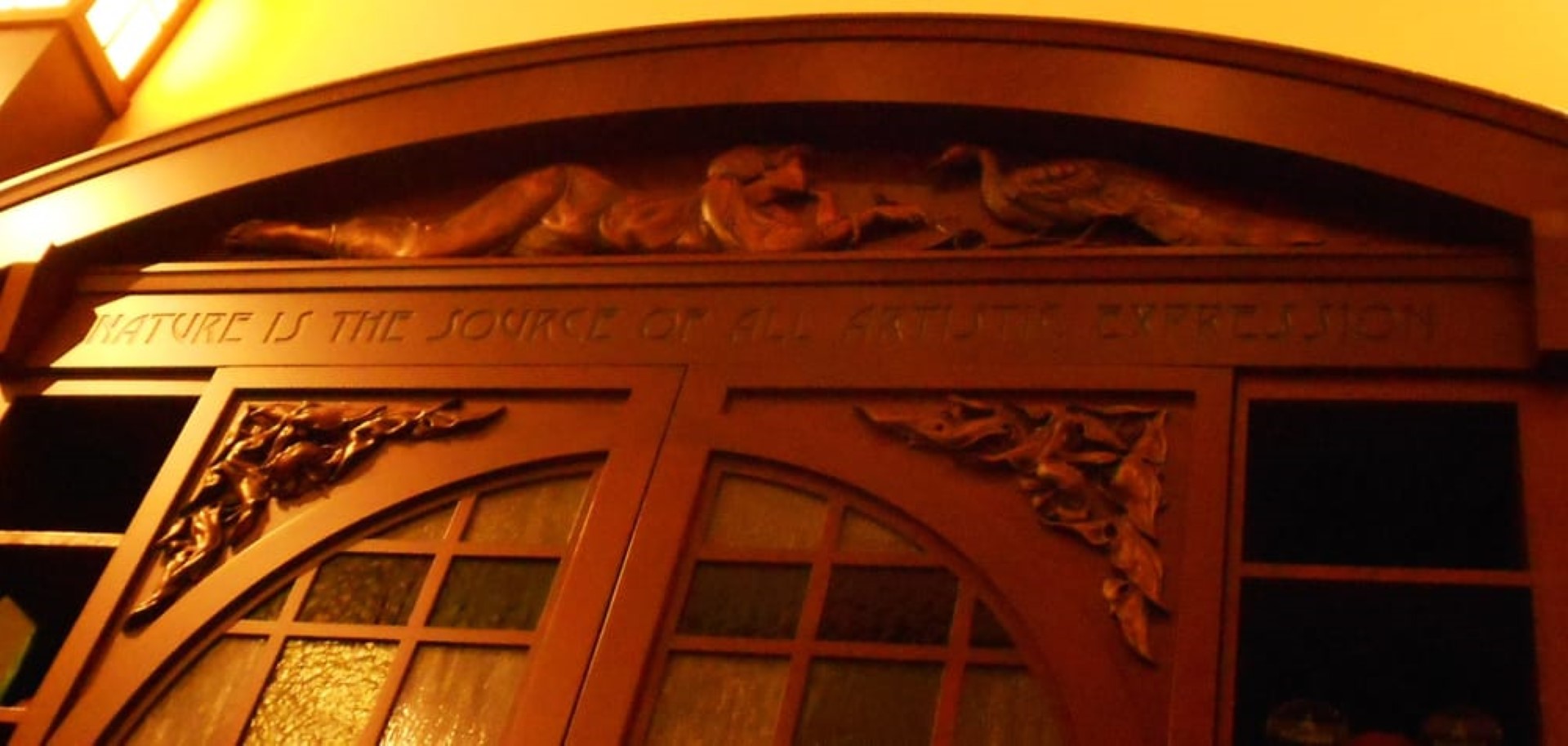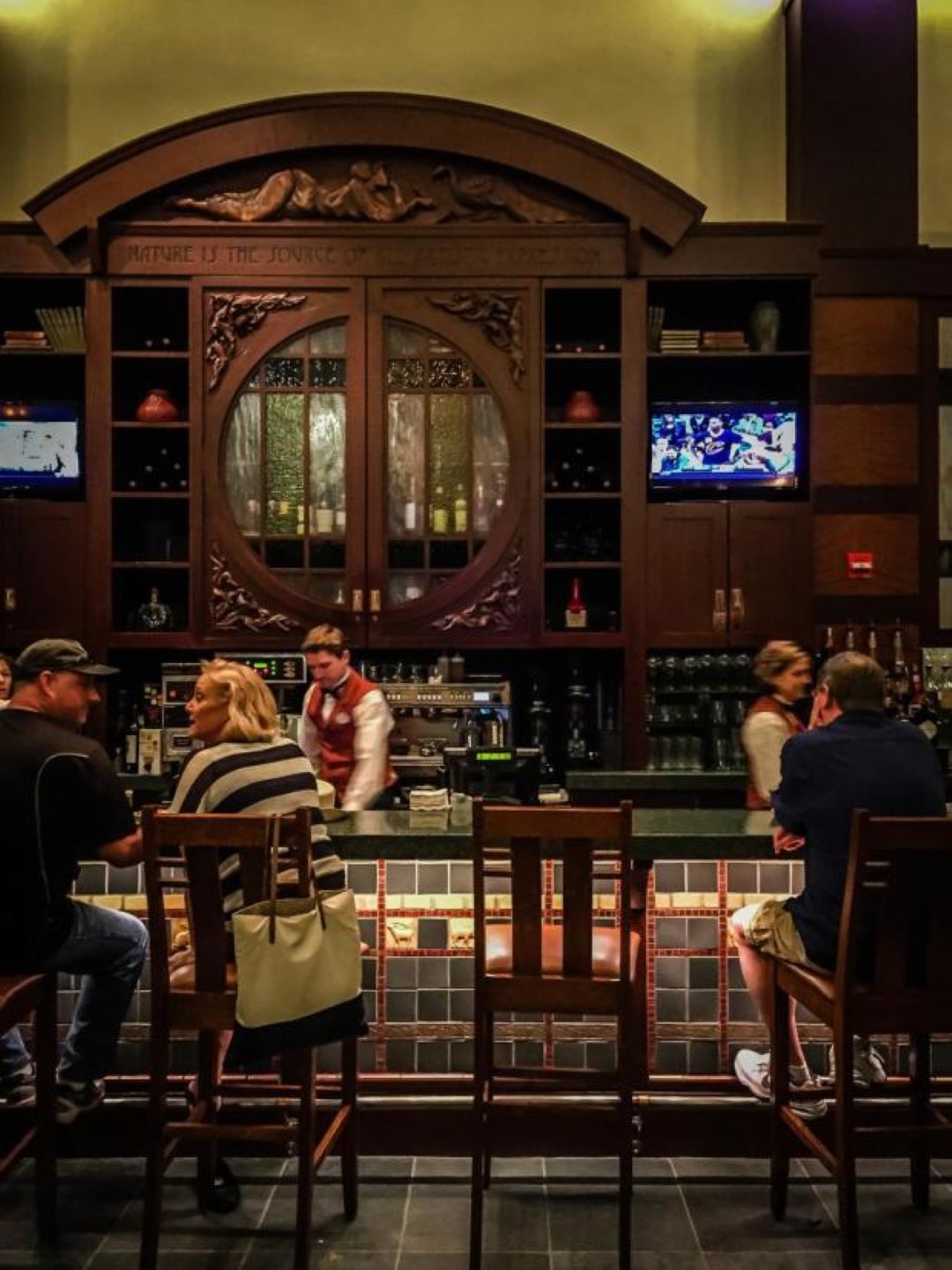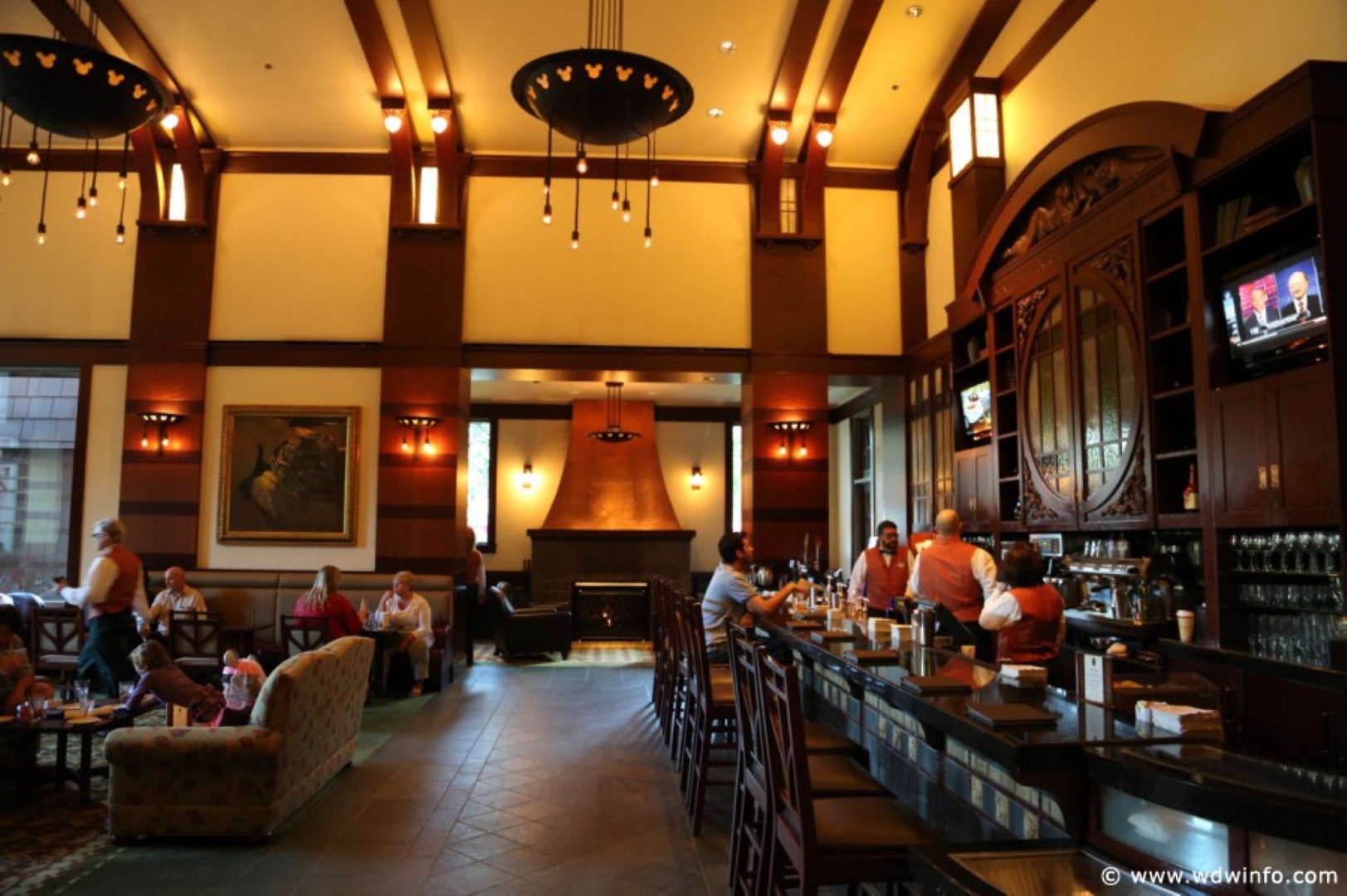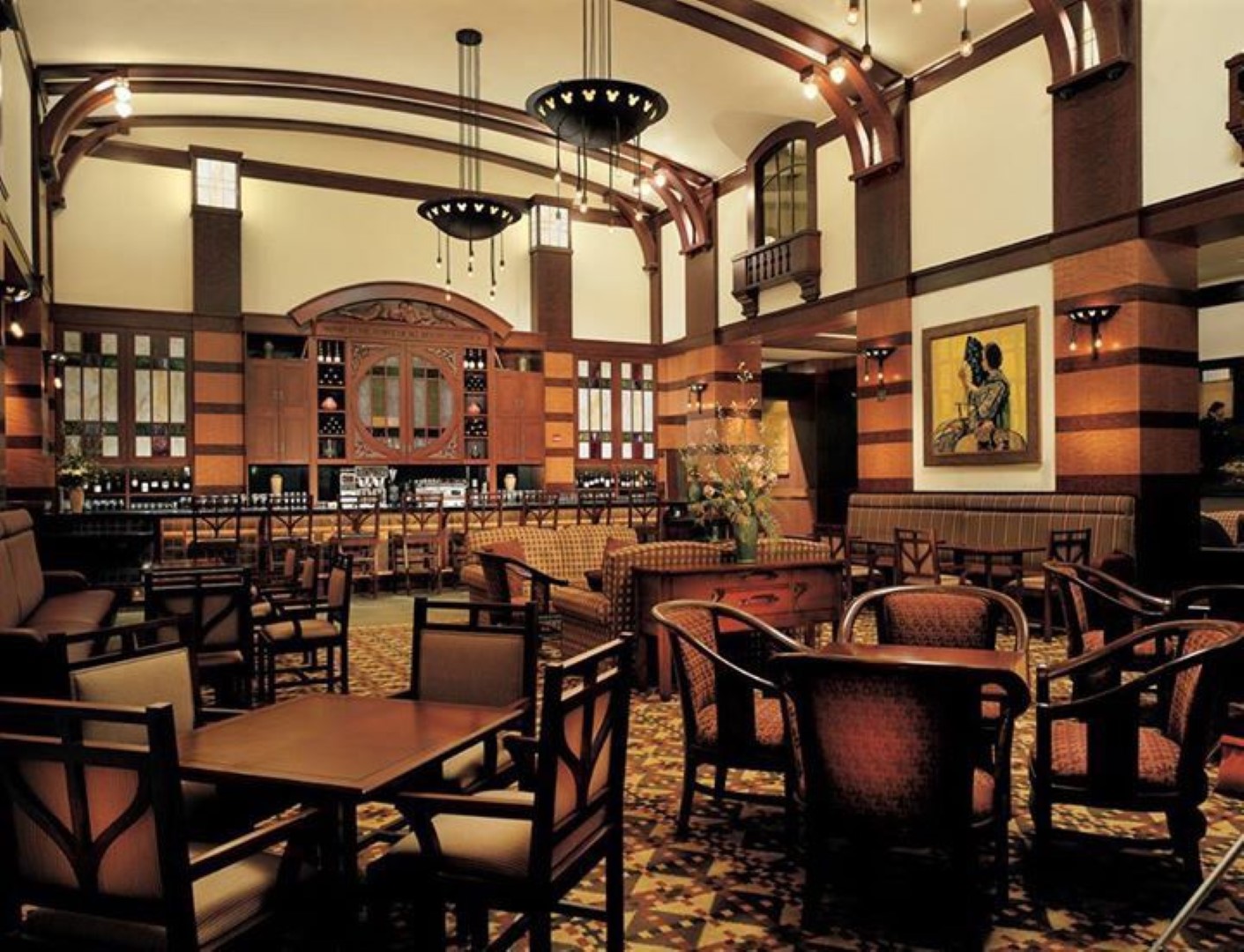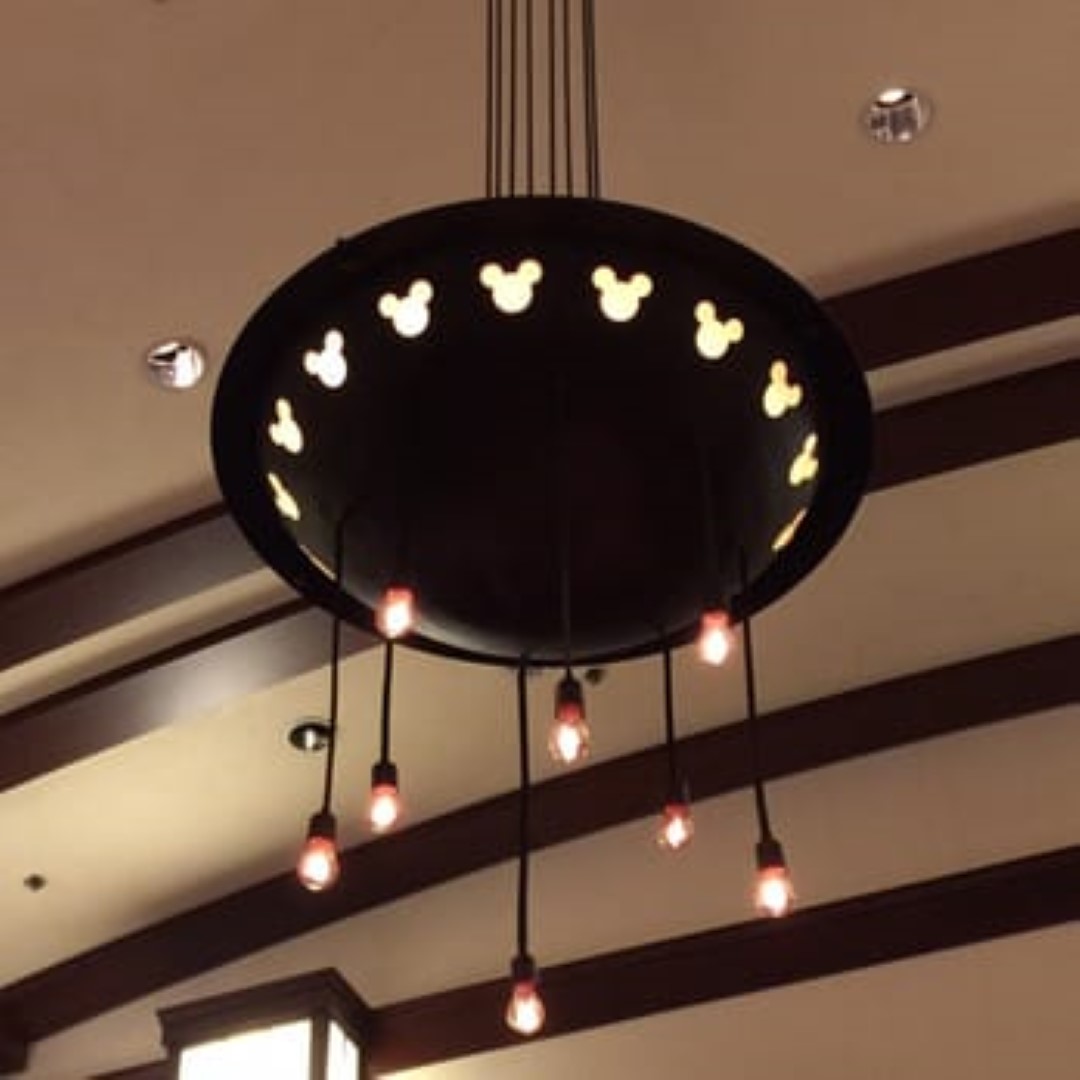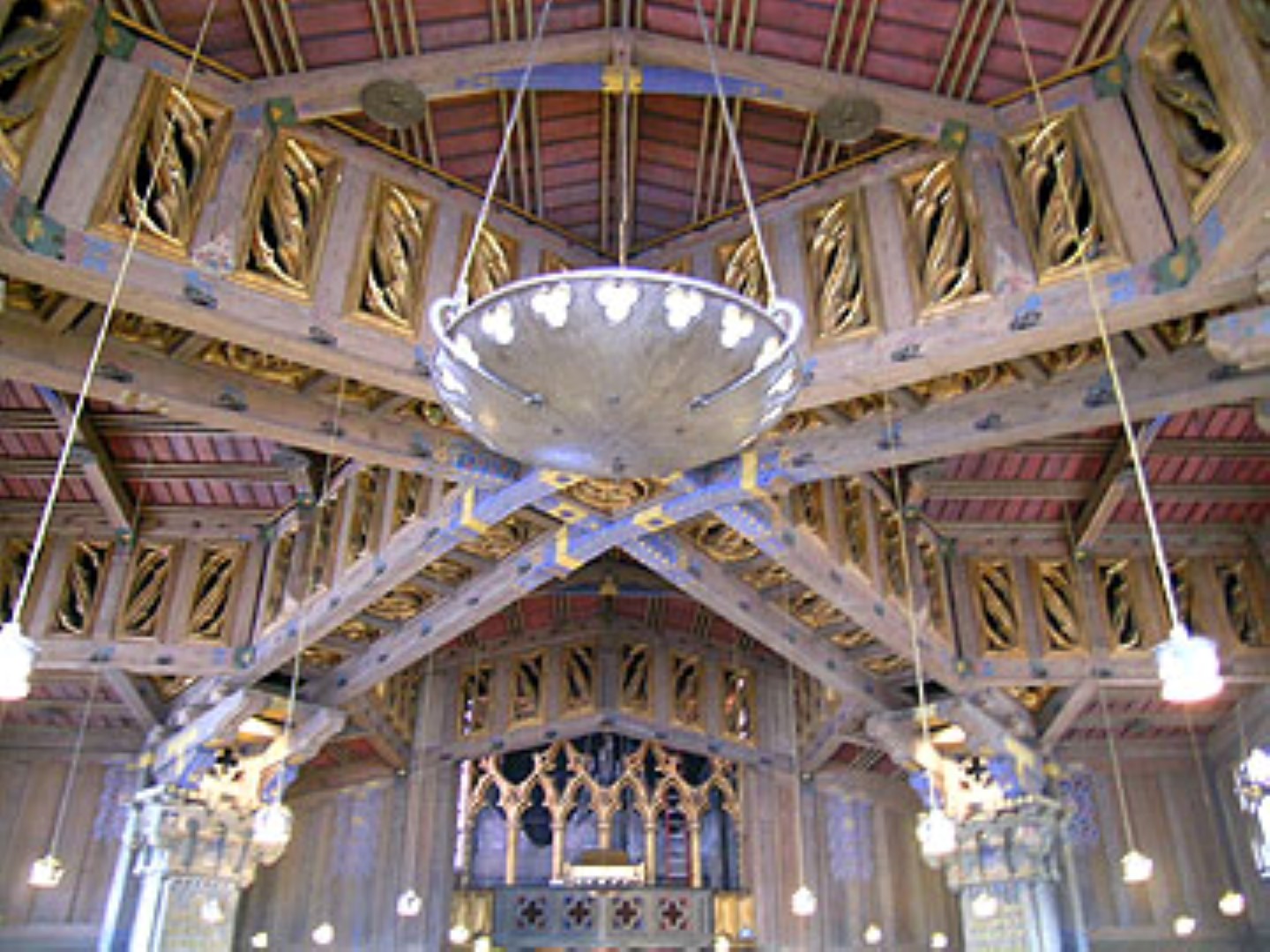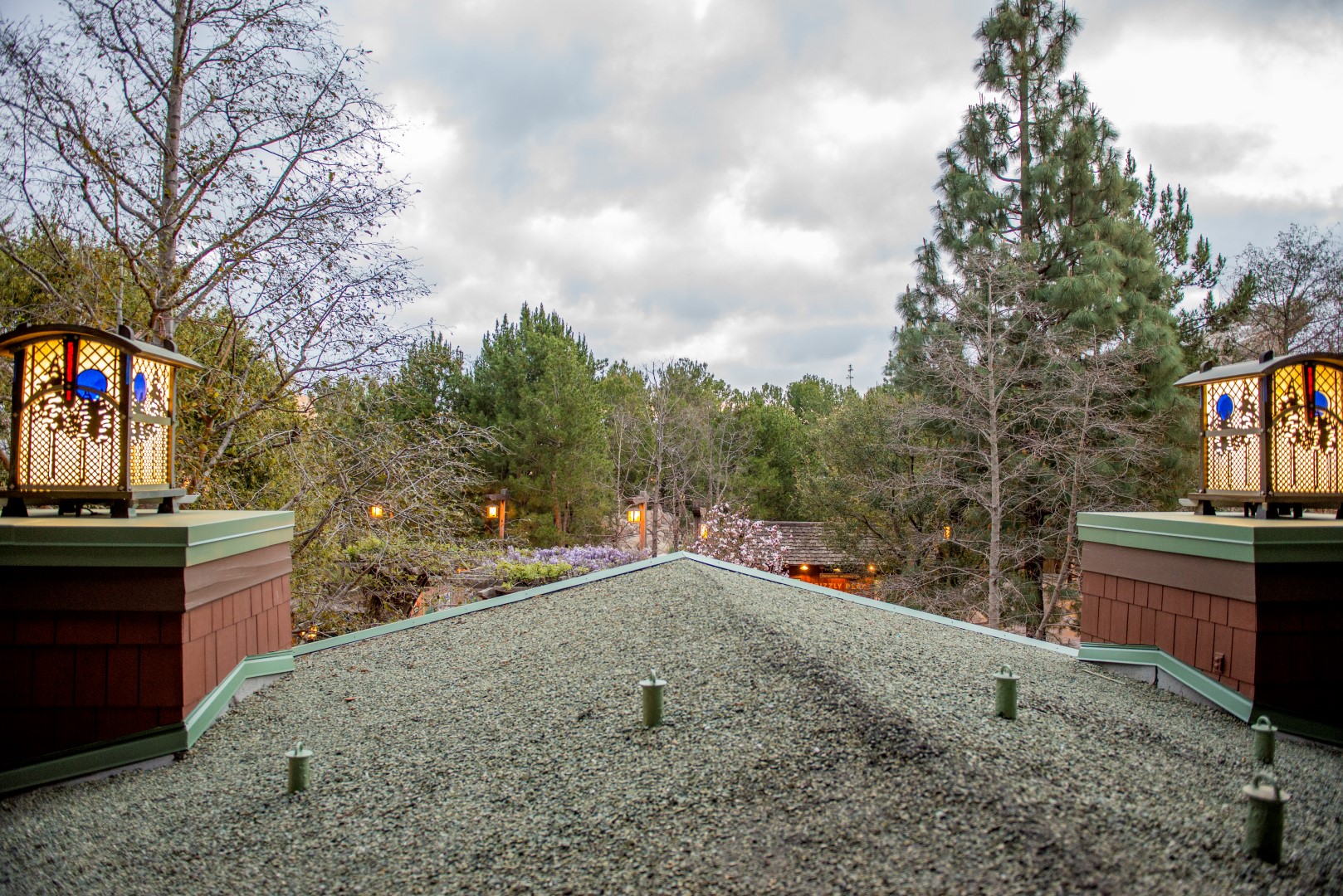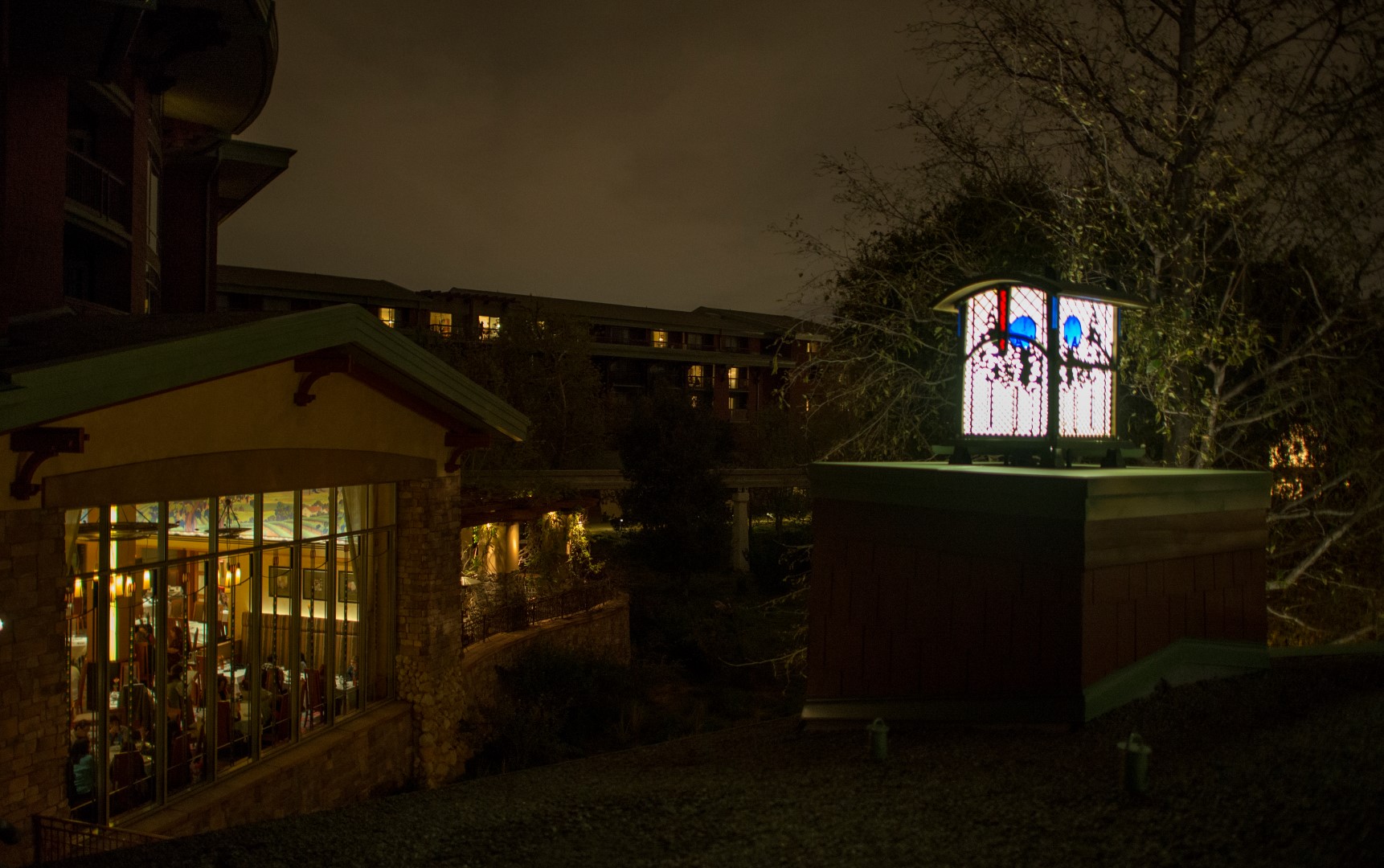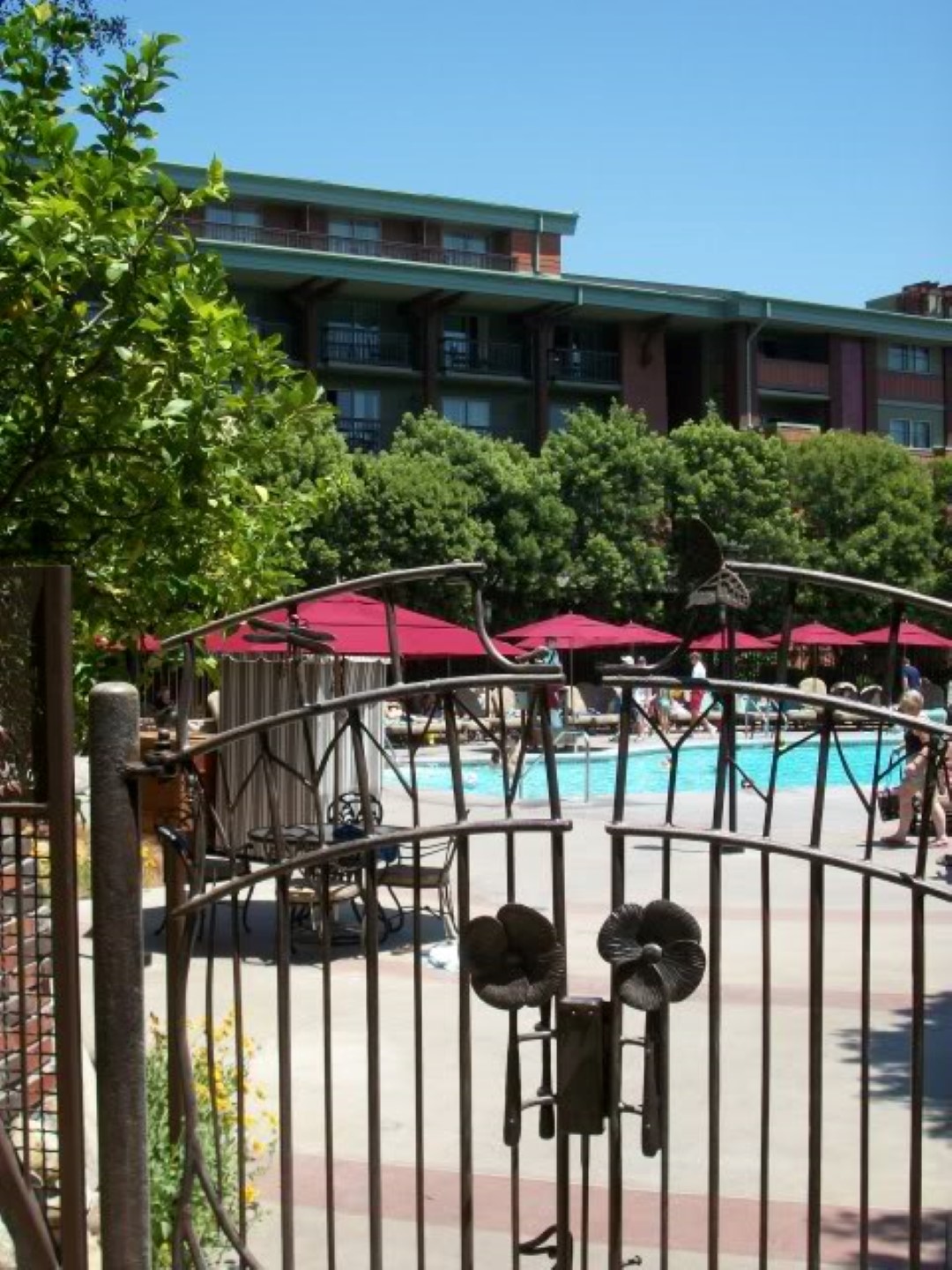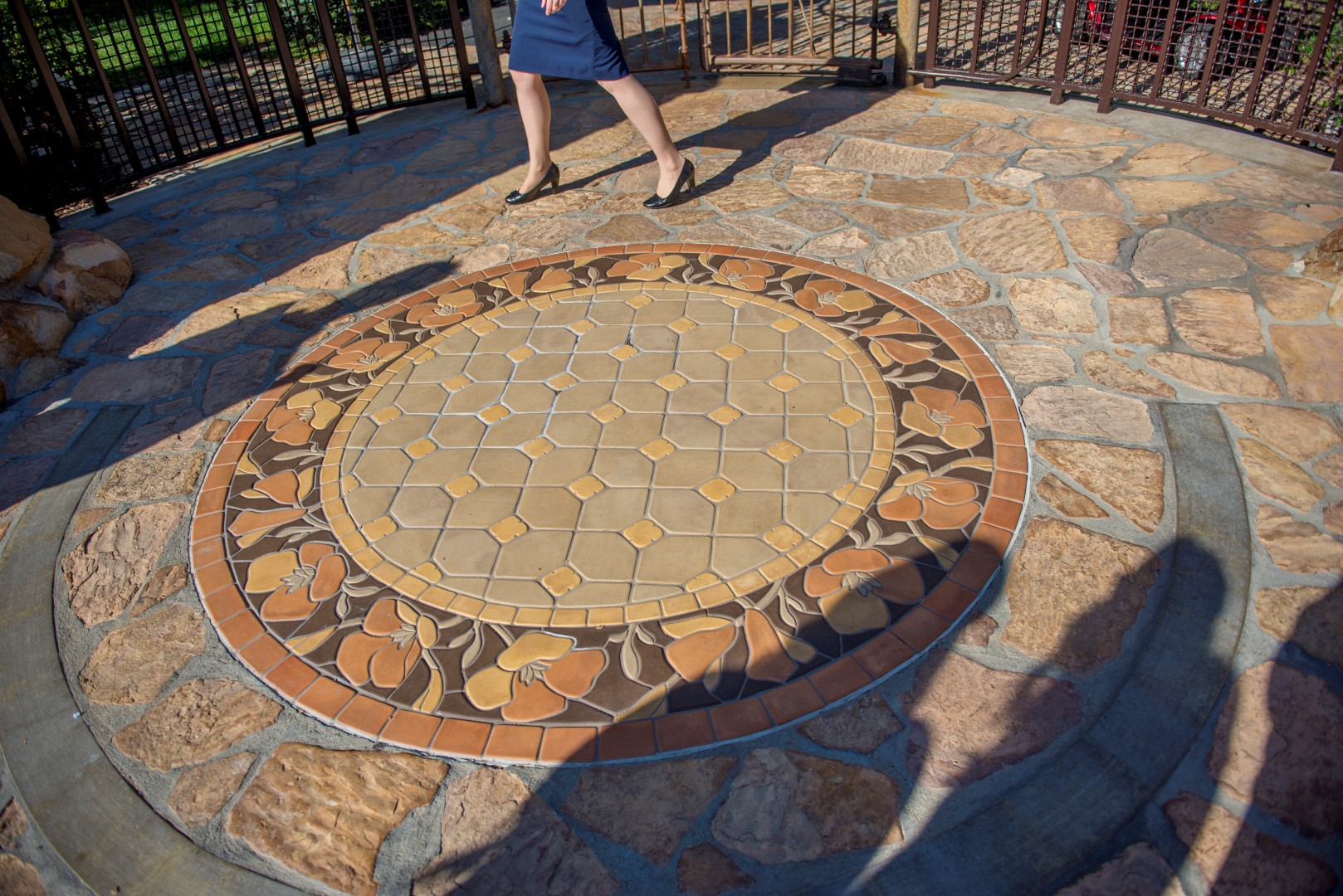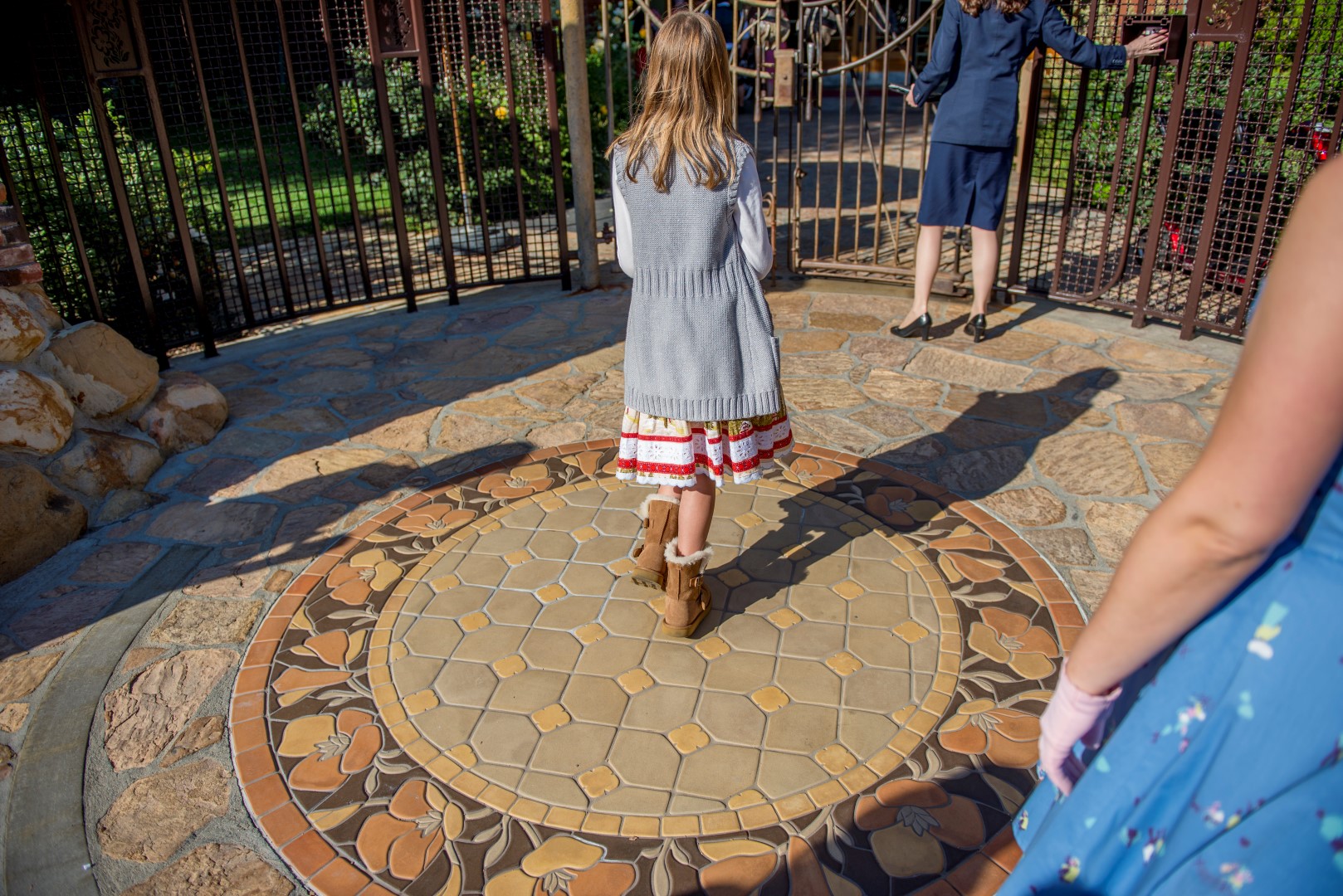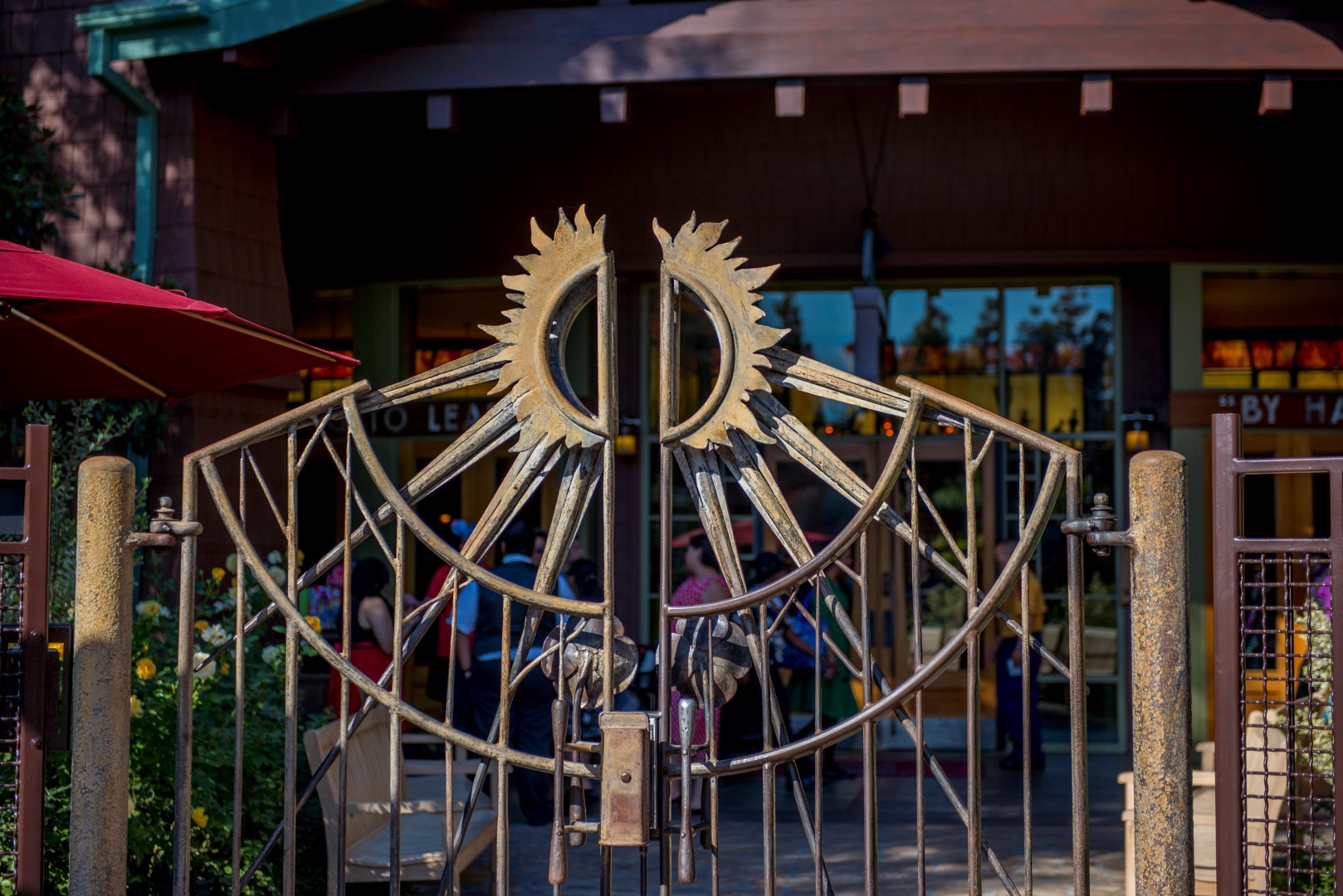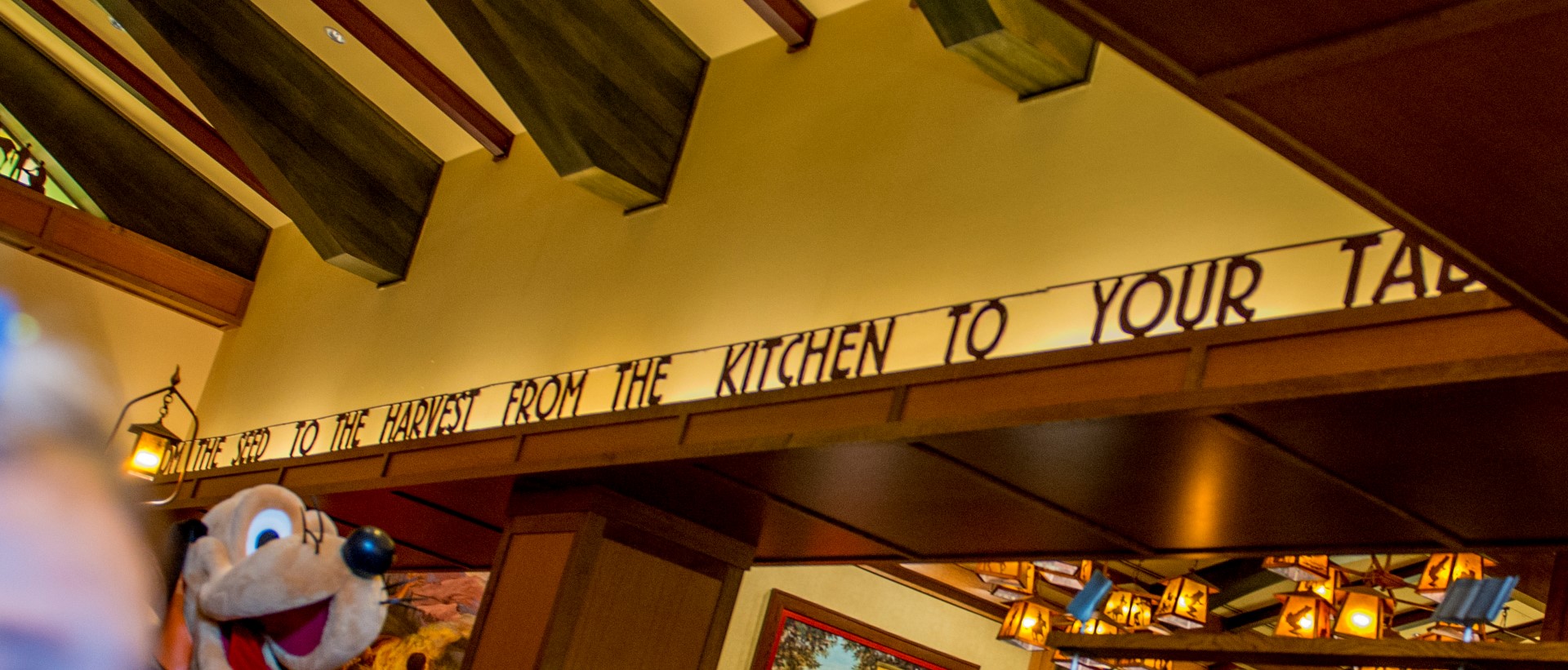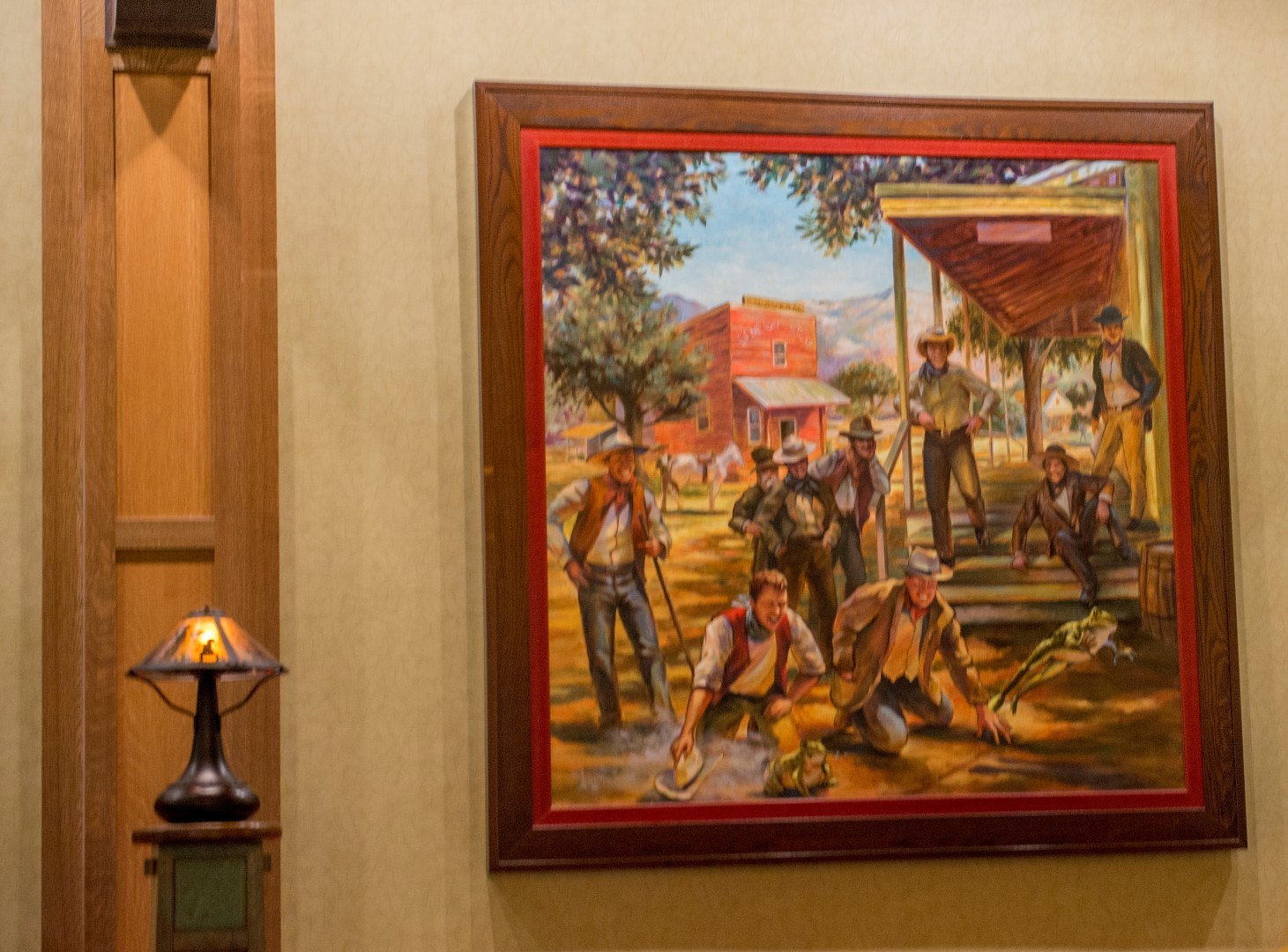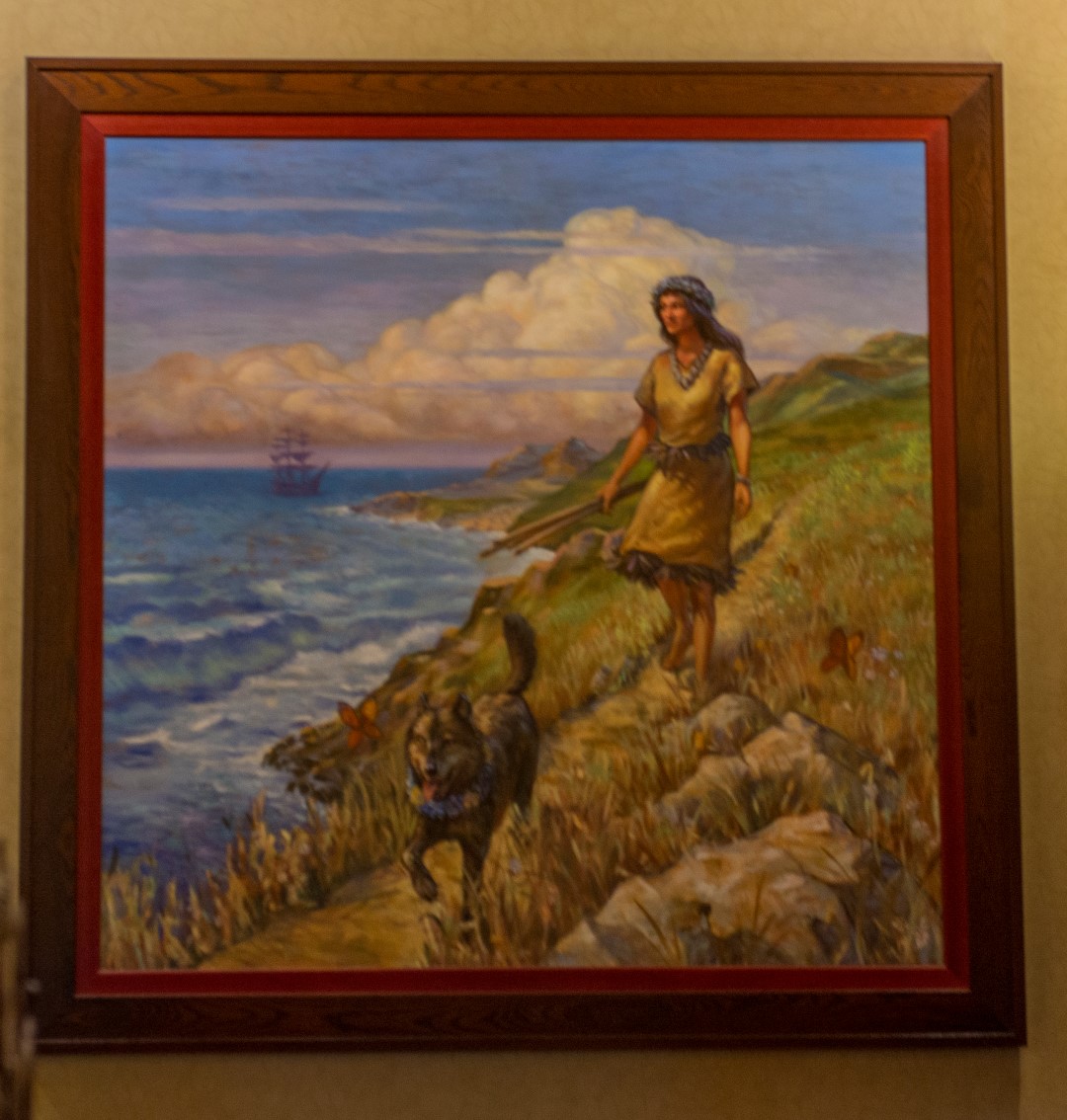whoever
DIS Veteran
- Joined
- Apr 7, 2013
This is a sub-report from my larger Fall, 2016 Dapper Day and Club 33 Trip Report found here:
https://www.disboards.com/threads/katherines-10th-birthday-trip-for-dapper-day-and-club-33.3560733/
And here we go......
We started in the far end of the Lobby. There were several pictures of people building Arts & Crafts resorts.
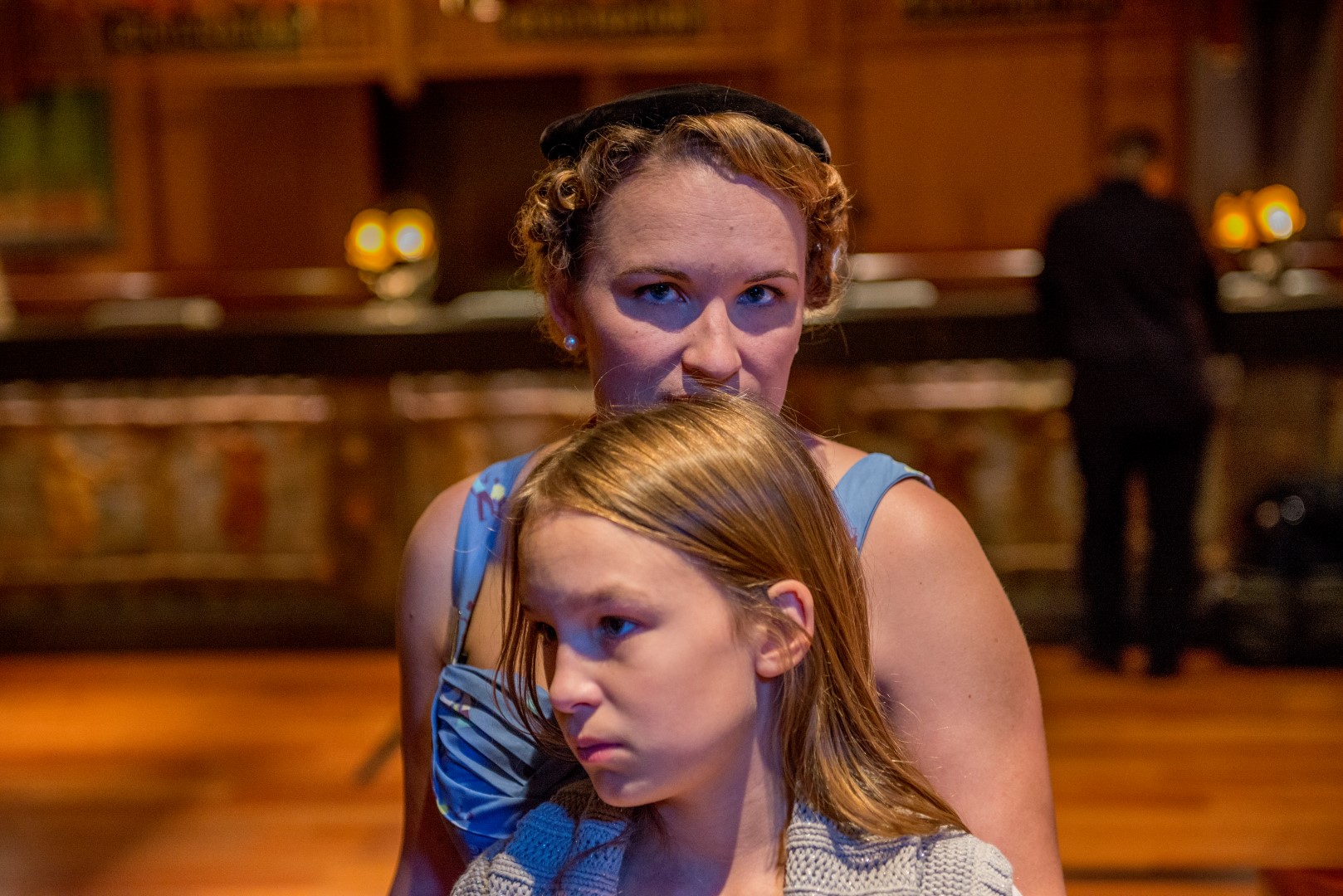
Our tour started with our guide reminding us that the ARTS AND CRAFTS movement started in the late 1800s, early 1900s and started over in Great Britain. It started in the time period where industrialization was coming about and machines were replacing entire shops... This upset the craftsmen because their jobs were being lost. That started John Ruskin to start writing about the movement featuring nature in design and the importance of craftsmanship. A fan of his writings, a gentleman by the name of William Morris. The Tapestries you see in the hotel were inspired by William Morris. The children's sized rocking chairs in front of the TV are Morris Chairs... He took John Ruskin's writing and put it to life. He had Morris & Company and hired a lot of those craftsman to build anything from tapestries to furniture. Here we fast forward to the United States...and talk about a gentleman named Bernard Maybeck who was considered the founding father of ARTS AND CRAFTS in California. She points to Maybeck in a picture hanging in the lobby...which is picturing Burbank California and playhouse he designed.
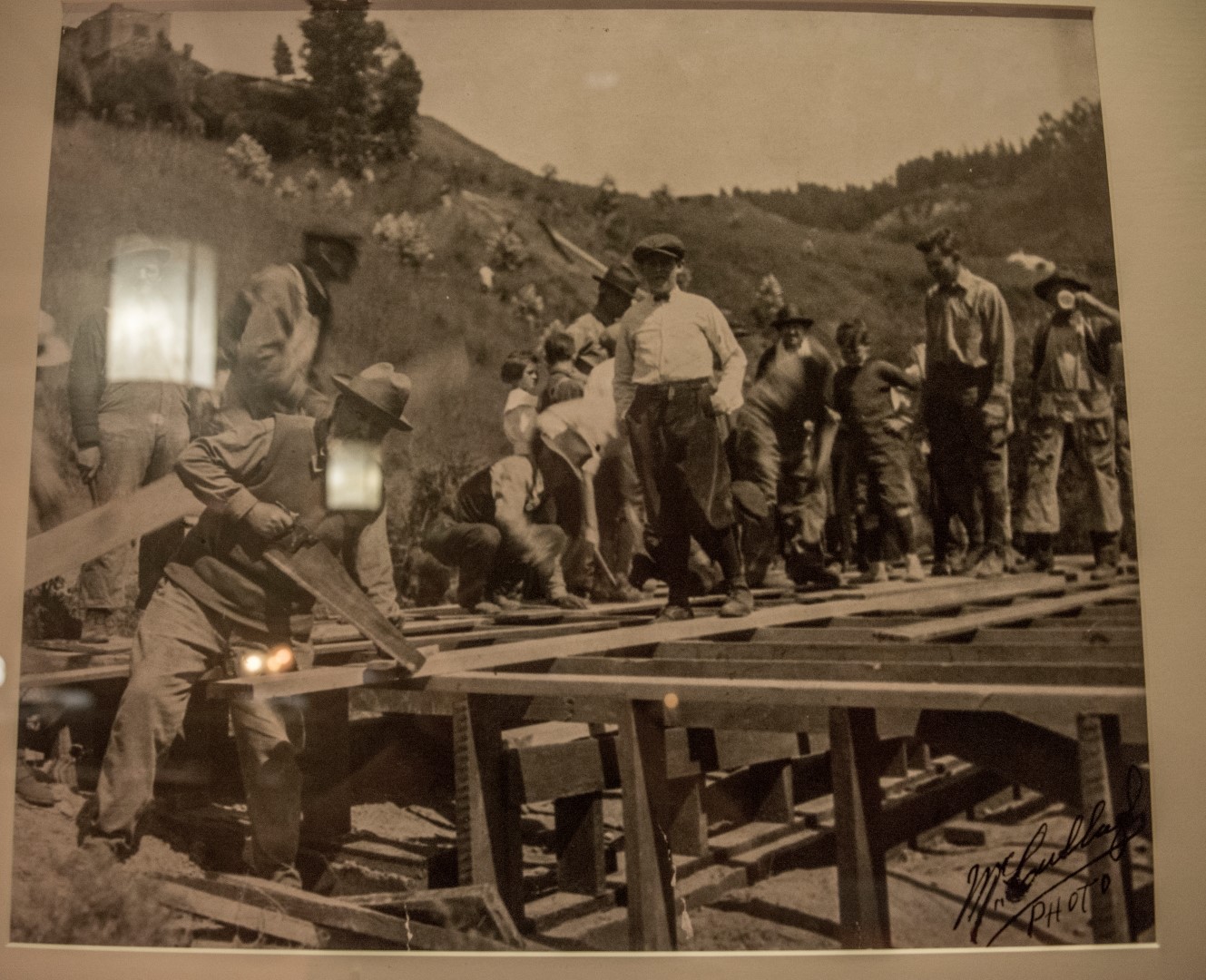
In another picture he was modeling one of the main ideas of the ARTS AND CRAFTS movement. Which was whoever designs it also builds it. The structure pictured was built in 1918. Unfortunately due to the fact that nobody did upkeep or maintenance, it was torn down in 1974. Frank Lloyd Wright - Falling Water in Bear Run, PA. The fun thing about the house is not only does it institute all the natural resources from the area, the sandstone was quarried from there, all the wood he utilized, but he also did a cantilevered design so half the house is hoisted over the river to show that merge between nature and design itself.
Pictured is this print of Falling Water Under Construction
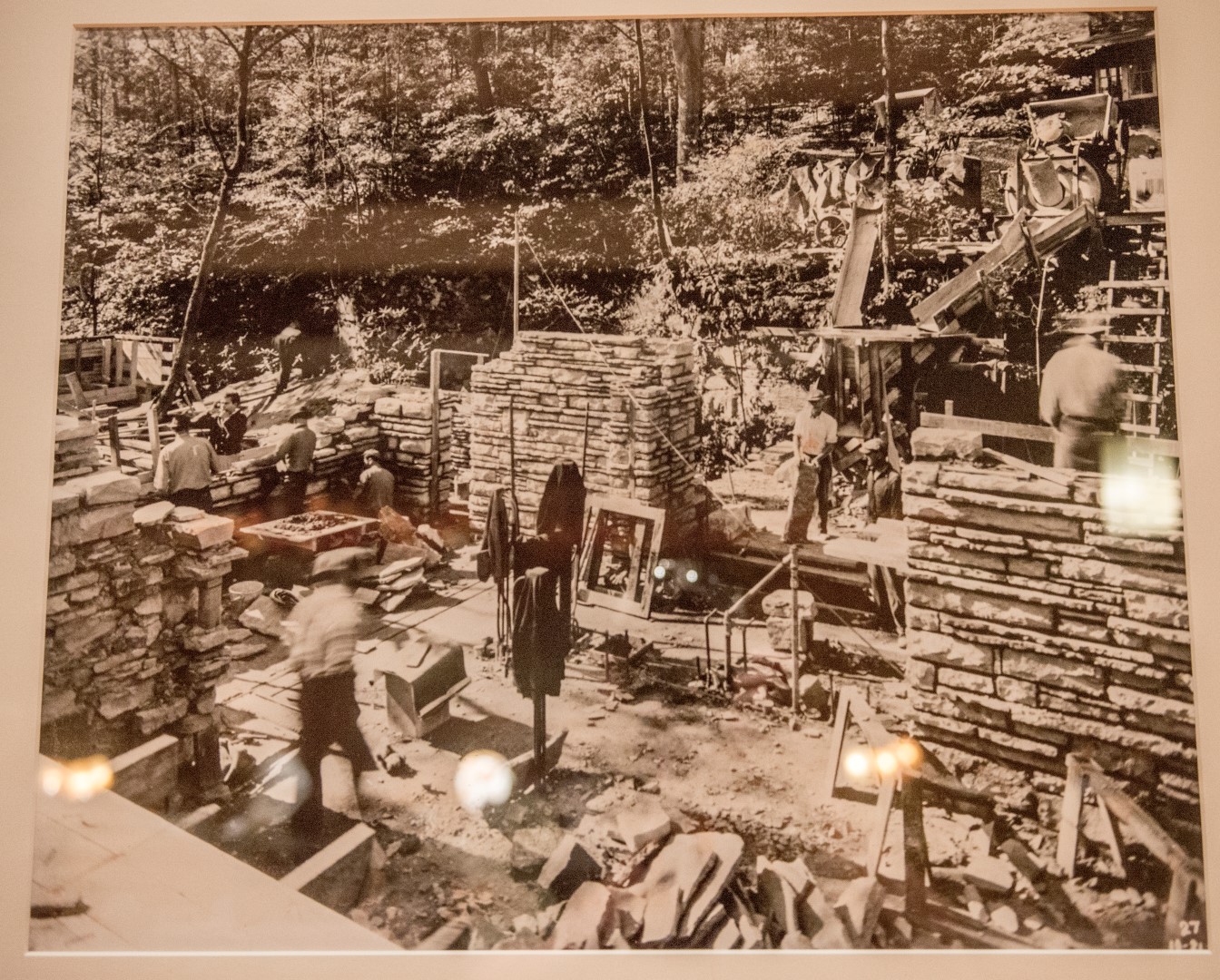
Inside our main hotel area they do not have very much FLW in it. Some of the lamps are in his style. This photo is the hosts all-time favorite ARTS AND CRAFTS structure... this hotel. Most of this hotel is modeled after the Charles and Henry Greene brother's structures. She asked if anybody was aware of the Gamble House. Charles and Henry were well known for that house and structure in their buffalo style and craftsman style. One of the main ideas of a craftsman home was called an ingelnook: you'd have a huge room with nooks and crannies you could sit in and enjoy the hustle and bustle of the main portion of the house and still be away. For example, the lobby is a huge room, but there are nooks and the fireplace area where you can still see what's going on but be out of the way.
The aforementioned picture of the Grand's Fireplace nook under construction..
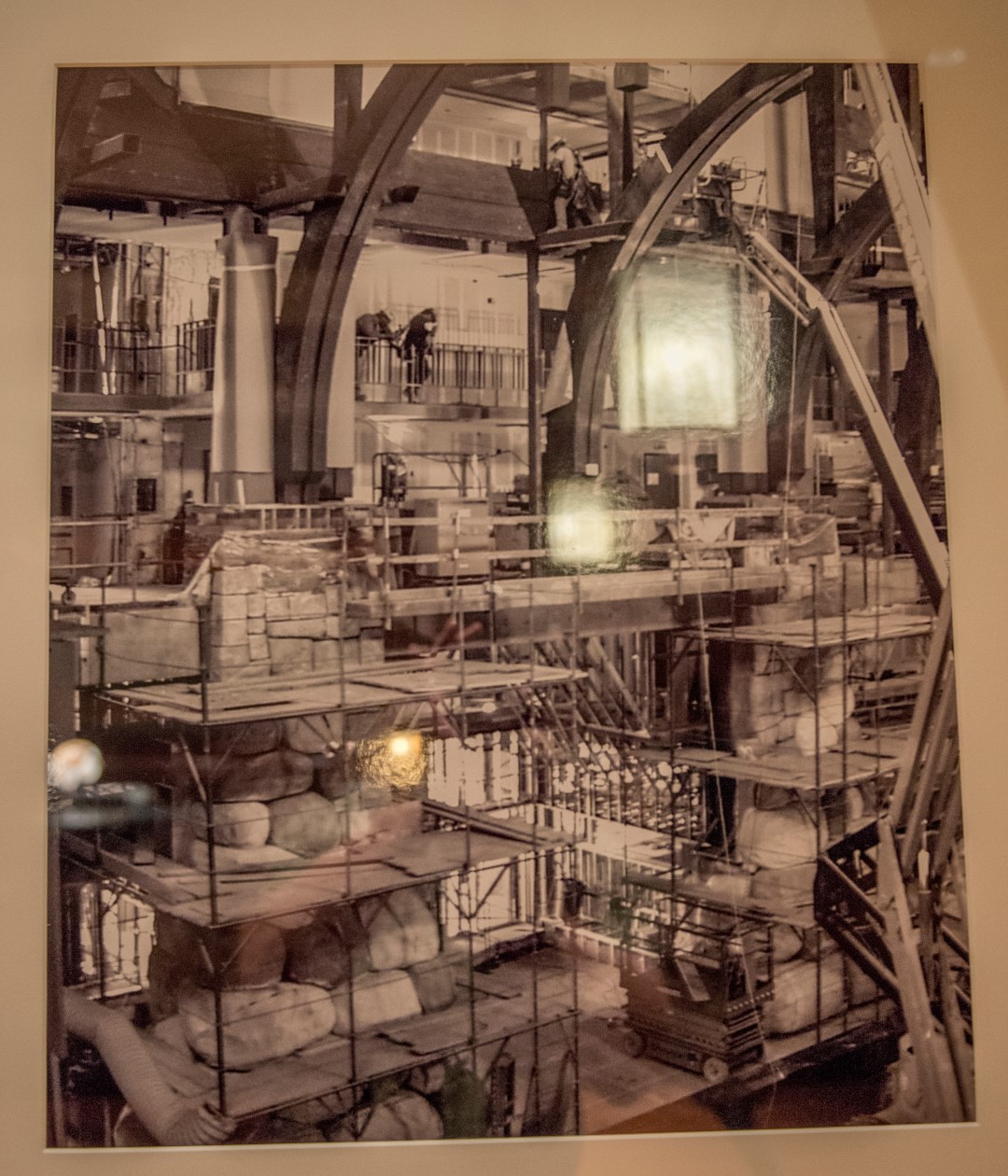
Peter Dominick was the designer for this hotel. Our guide asked if anybody had been to WDW. A few hands went up. She then inquired if we had seen the animal kingdom lodge or the wilderness lodge. Peter Dominick was also the designer of those as well. If it has Lodge in the name, he probably helped in some way, shape, or form. PD had the biggest challenge, which was taking a bungalow style home which is quaint and making it into a 745 room hotel. She asked who would want that challenge, to which only I raised my hand. She then proceeded to tell us how he did it and turned us around looking back down the reception area.
Before we proceed, let me apologize for the next few images. I didn't have any readily available, so these are the best I could source on short notice.. I promise to come back and rectify these shots after the next trip and any I did not shoot myself will be noted under them.
Behind the front desk you see three tapestries. On the far end you have one which looks like a garden.
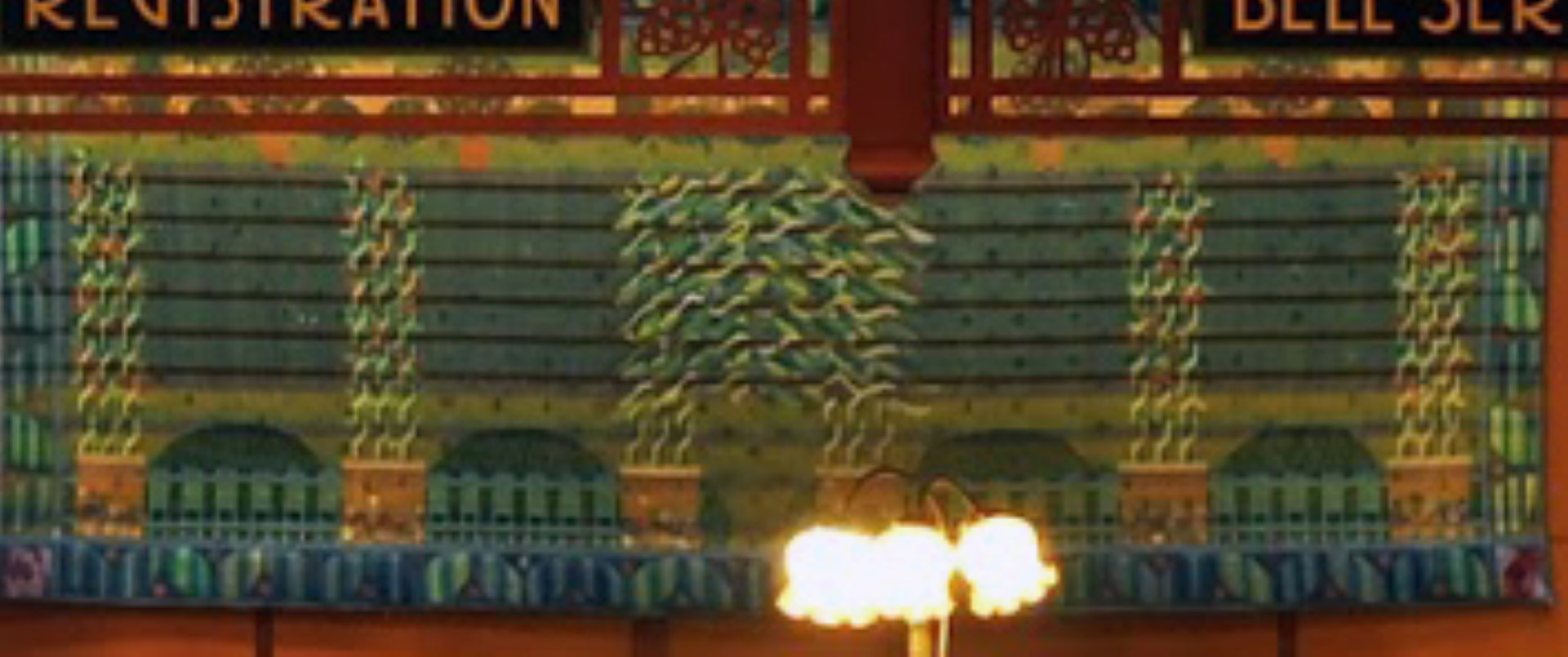
(Not my picture)
As she had previously mentioned, bungalow style homes are usually modeled after the gardens which surround them. What would be like a garden, just bigger? A forest and this is where this next tapestry comes in.
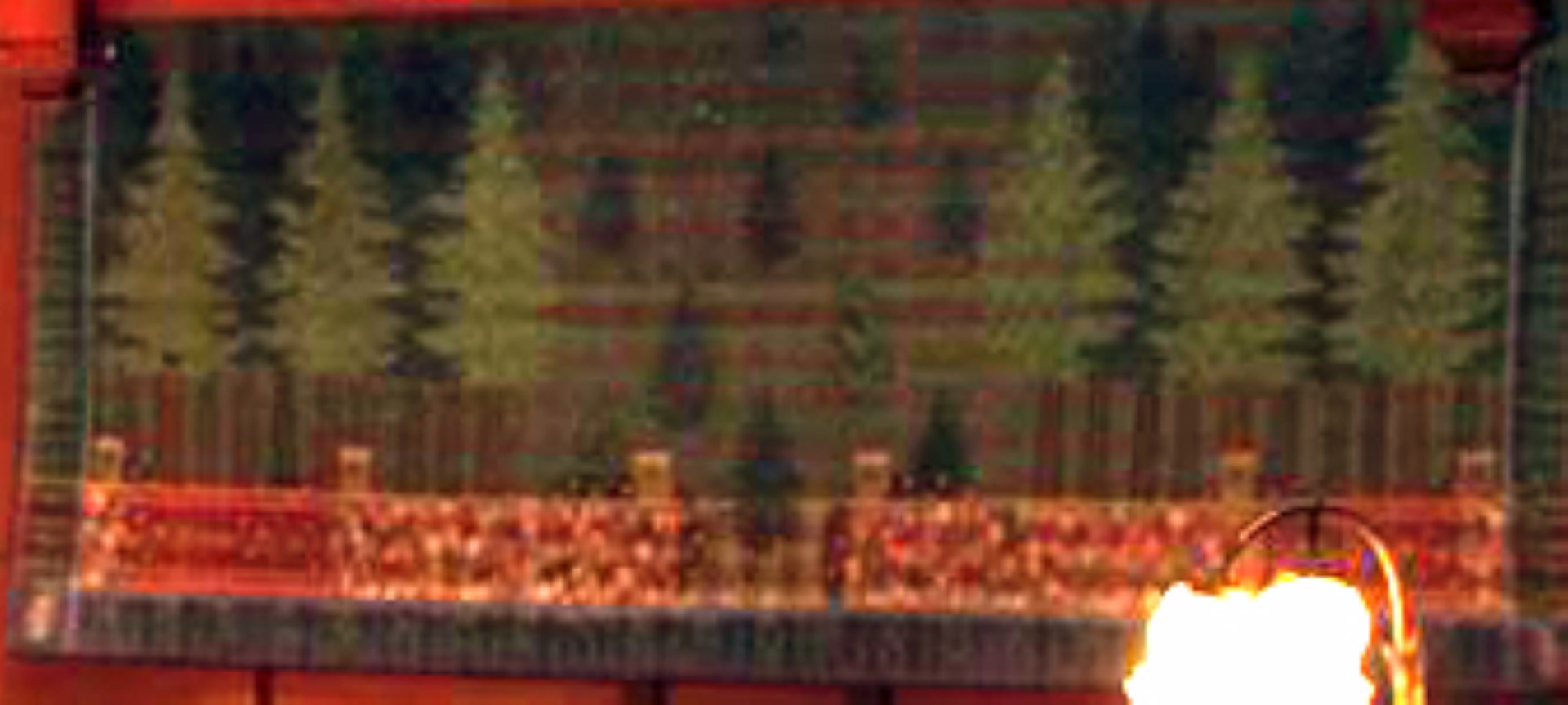
(Not my picture)
The entire hotel is modeled after forests and has a forest surrounding it. In the middle was a tapestry of the hotel itself.
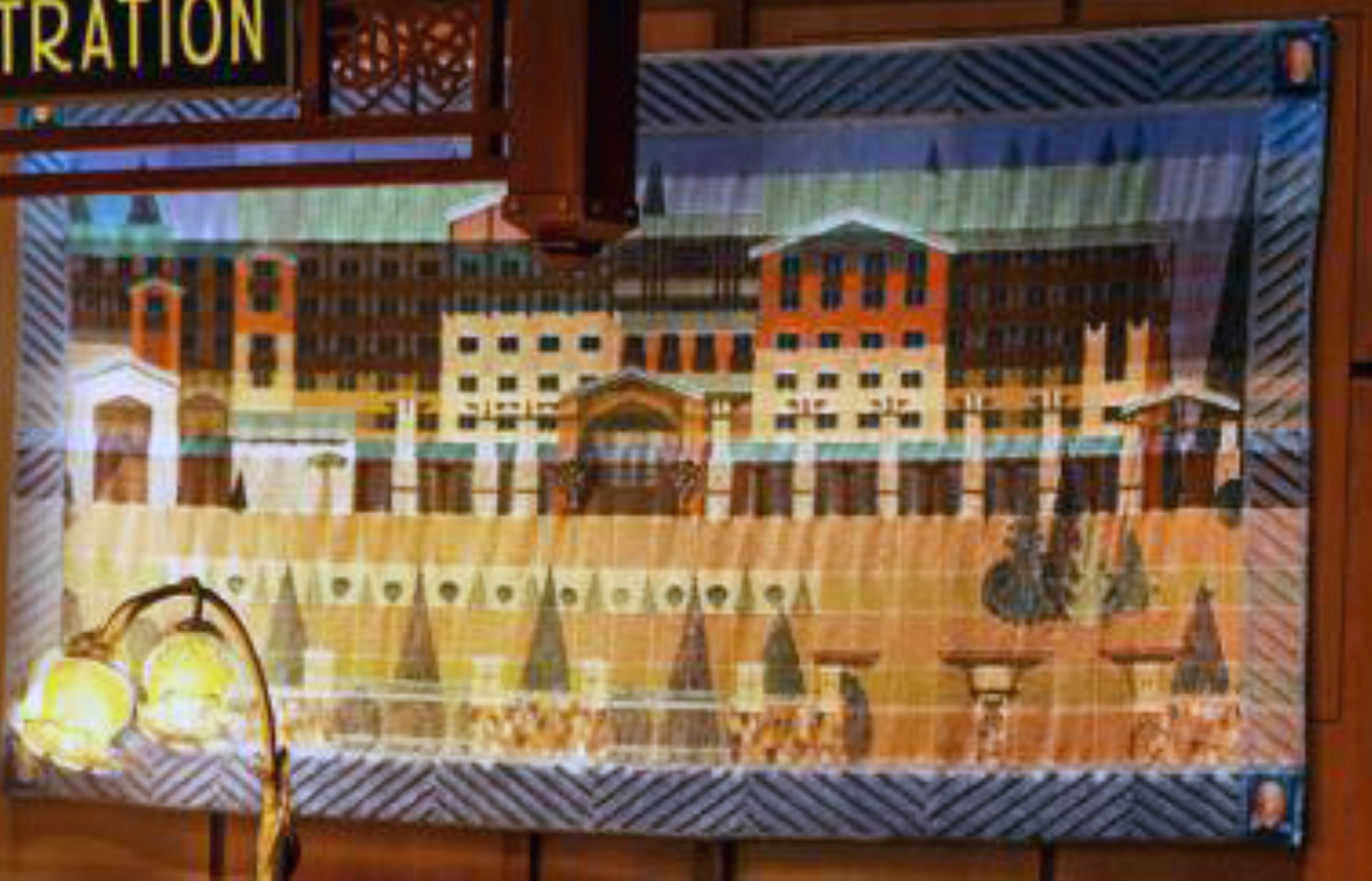
(Not my picture)
Down in front you have the lovely lamps which were made for the hotel by Dale Tiffany and feature four California critters. Quail, Salamander, Butterfly, and a Snail. Down below you have for the four seasons.
They have something called the artisan program. The artisan program is made up of 30 different individuals/companies who contributed to the bungalow-style craftsman-style hotel. These are three of them, the dancing bears through the four seasons is her personal favorite. They were done by a husband and wife team from the Berkeley area. The wife hand molds the tiles out of terracotta and the husband does the installation. They also did several other pieces of art for the hotel.
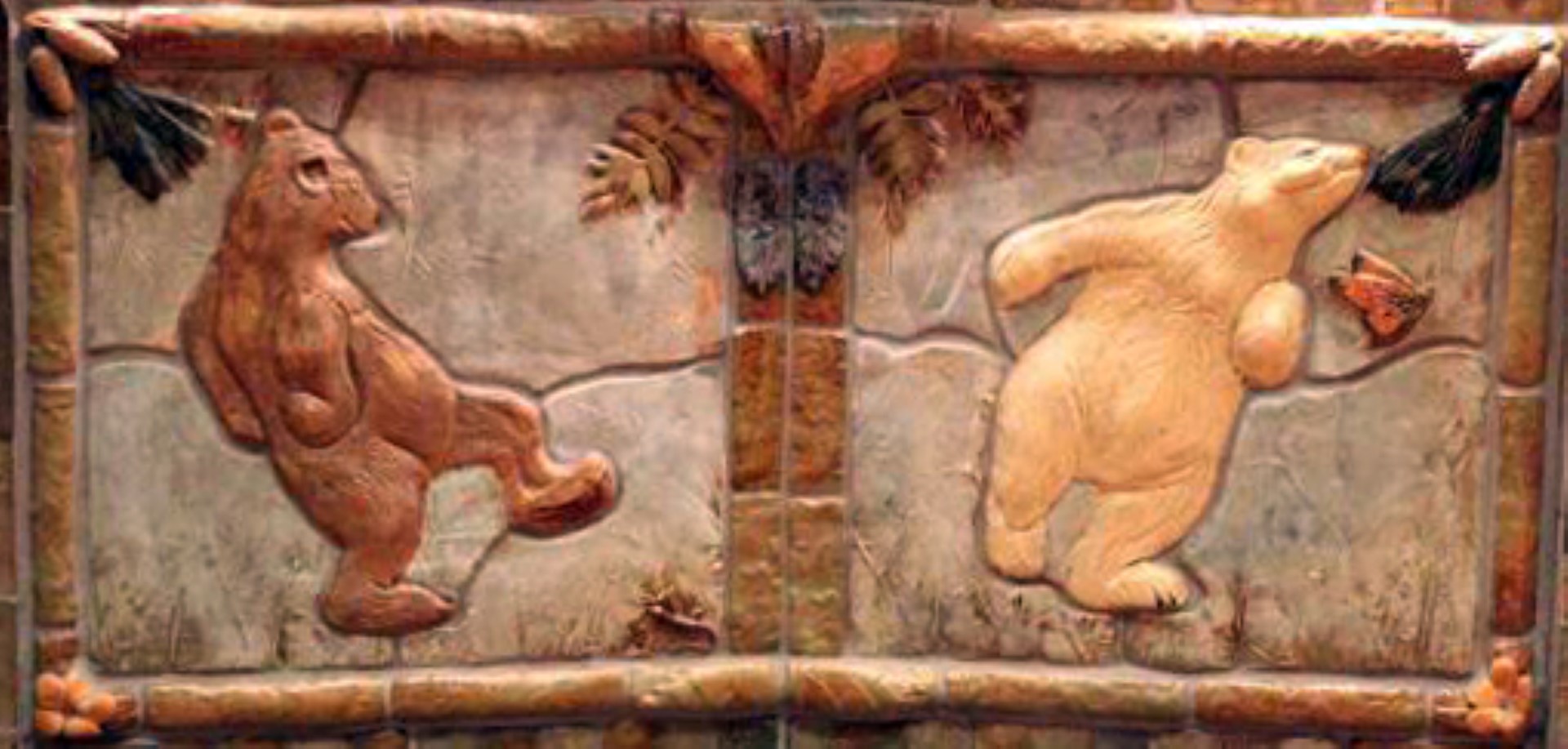
(Not my picture)
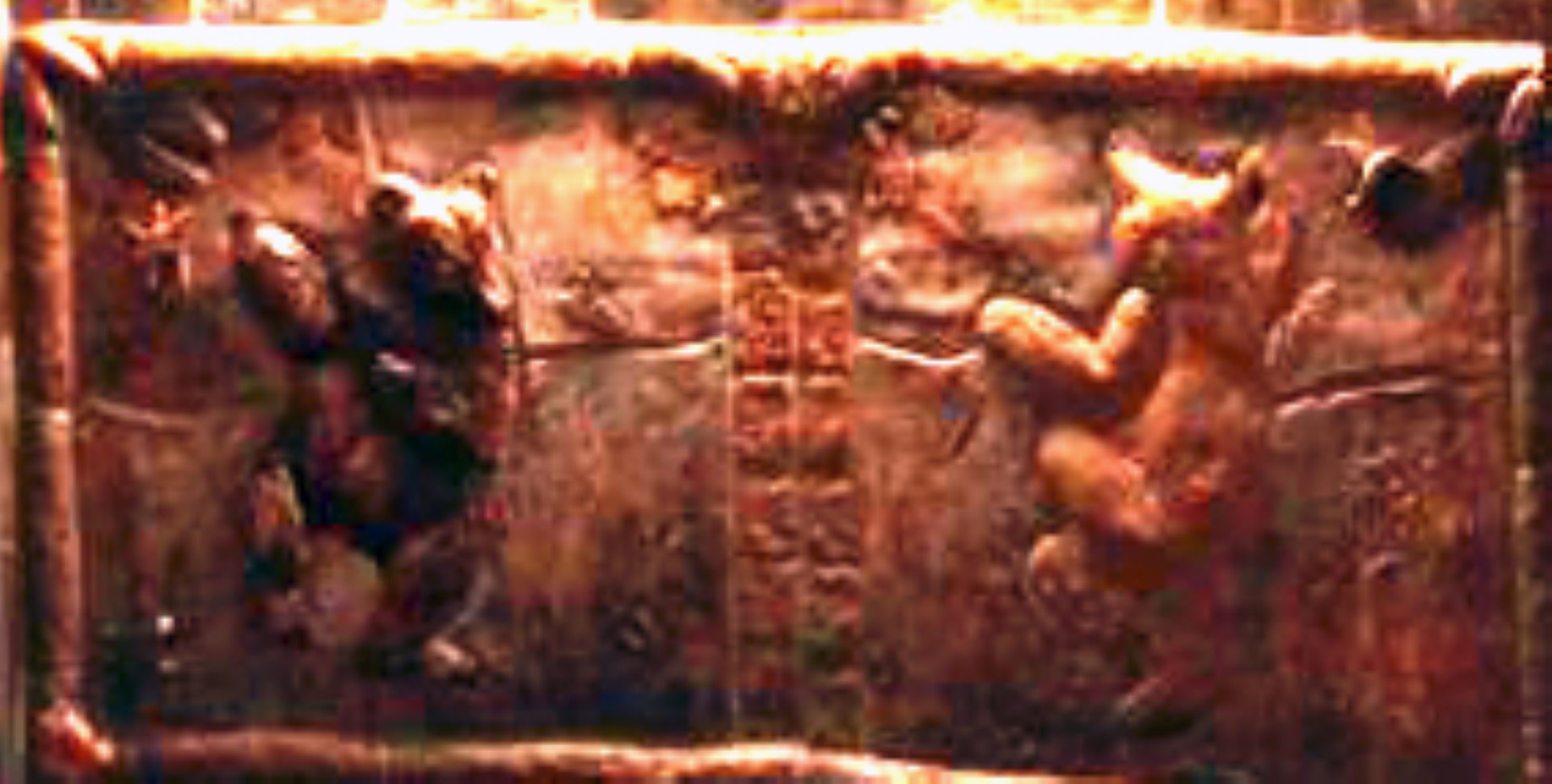
(Not my picture)
While we are in the reception area, she wanted to point out the ceiling. We wanted a welcoming, open, yet comforting feeling when you first walked in. This particular section of the lobby is modeled after First Unitarian church built by Albert C. Schweinfurth and Bernard Maybeck and was one of the first structures he built and built in 1894 and is still standing today. The fun part about it, in the worship area, they actually shipped down Madrones trees from Santa Barbara and steamed them so they would bend over all the pews. Luckily enough ours is made out of Disney wood, so it was easy to bend. They are still standing today, so if you look them up or go up to visit it up in Berkeley, the tree trunks are still bent over the worship area today. It is supposed to symbolize spiritual growth in life and the church, but here it is just a welcoming feeling.
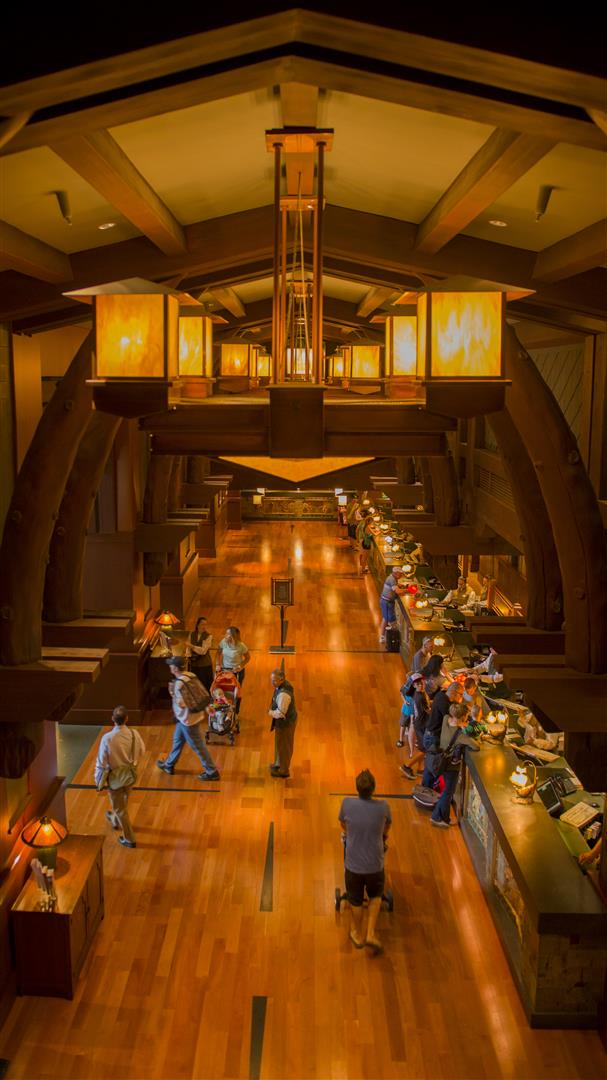
So far as I can tell, this is the Church in question, however I've been unable to locate any interior pictures..
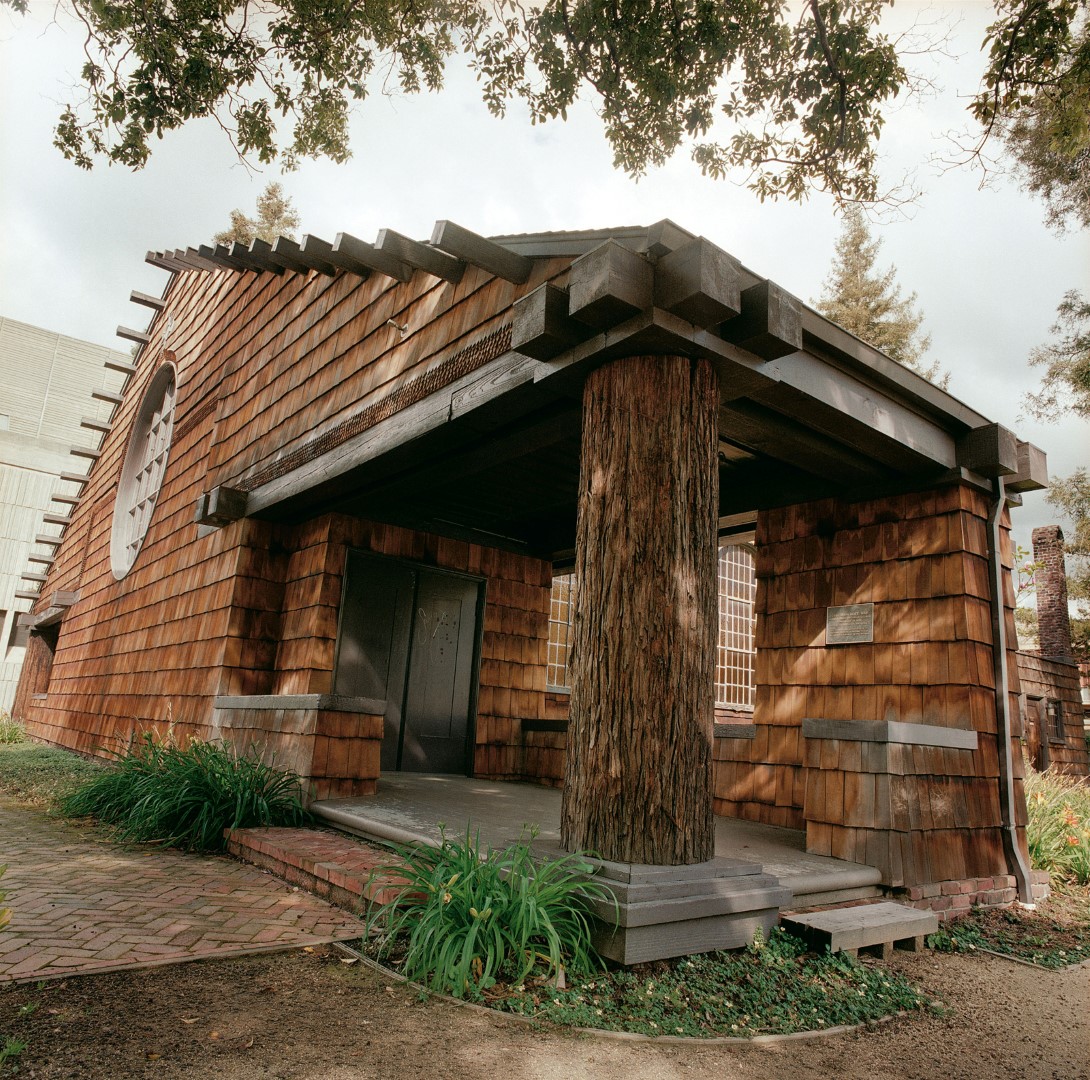
(Not my picture)
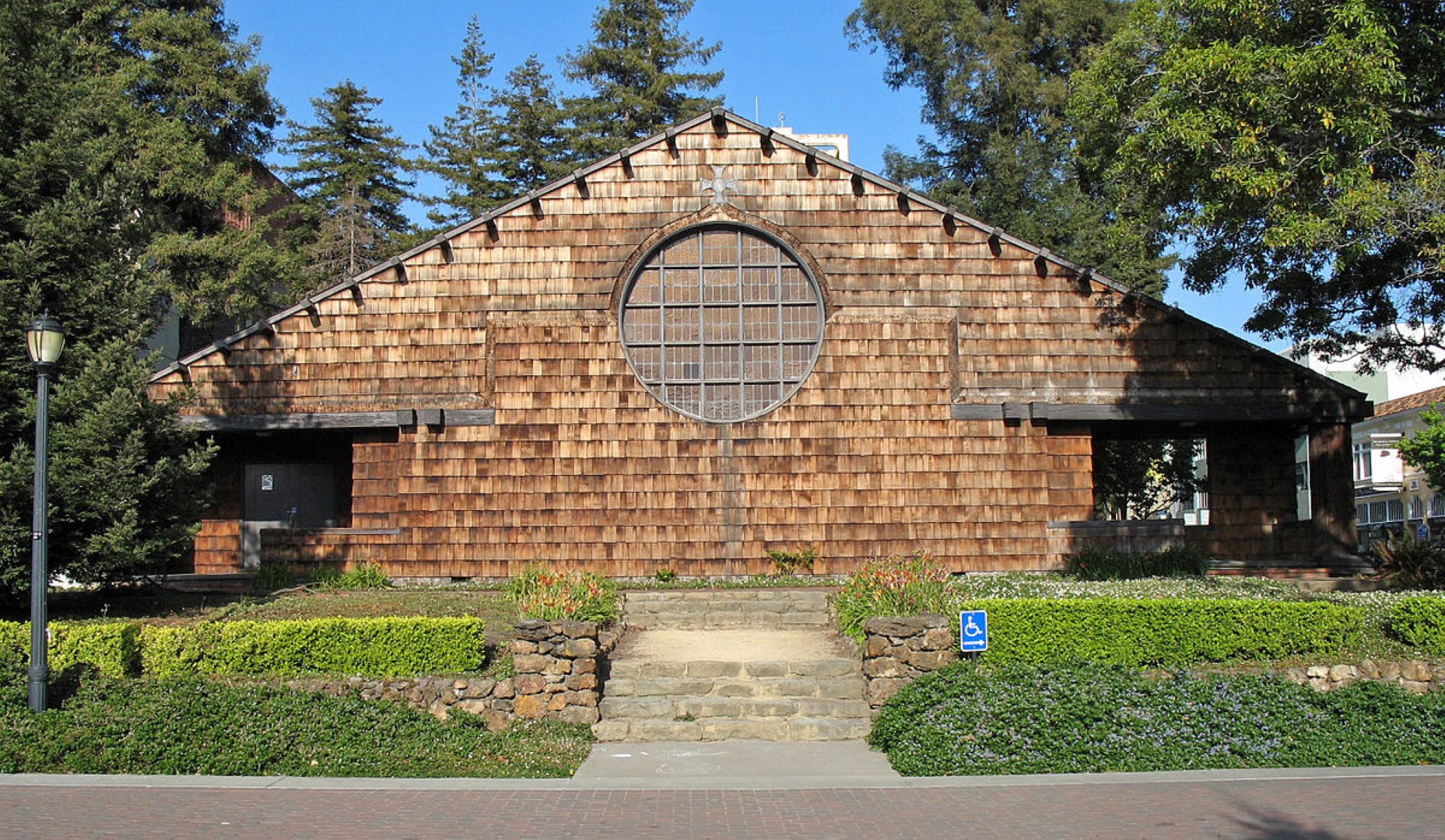
(Not my picture)
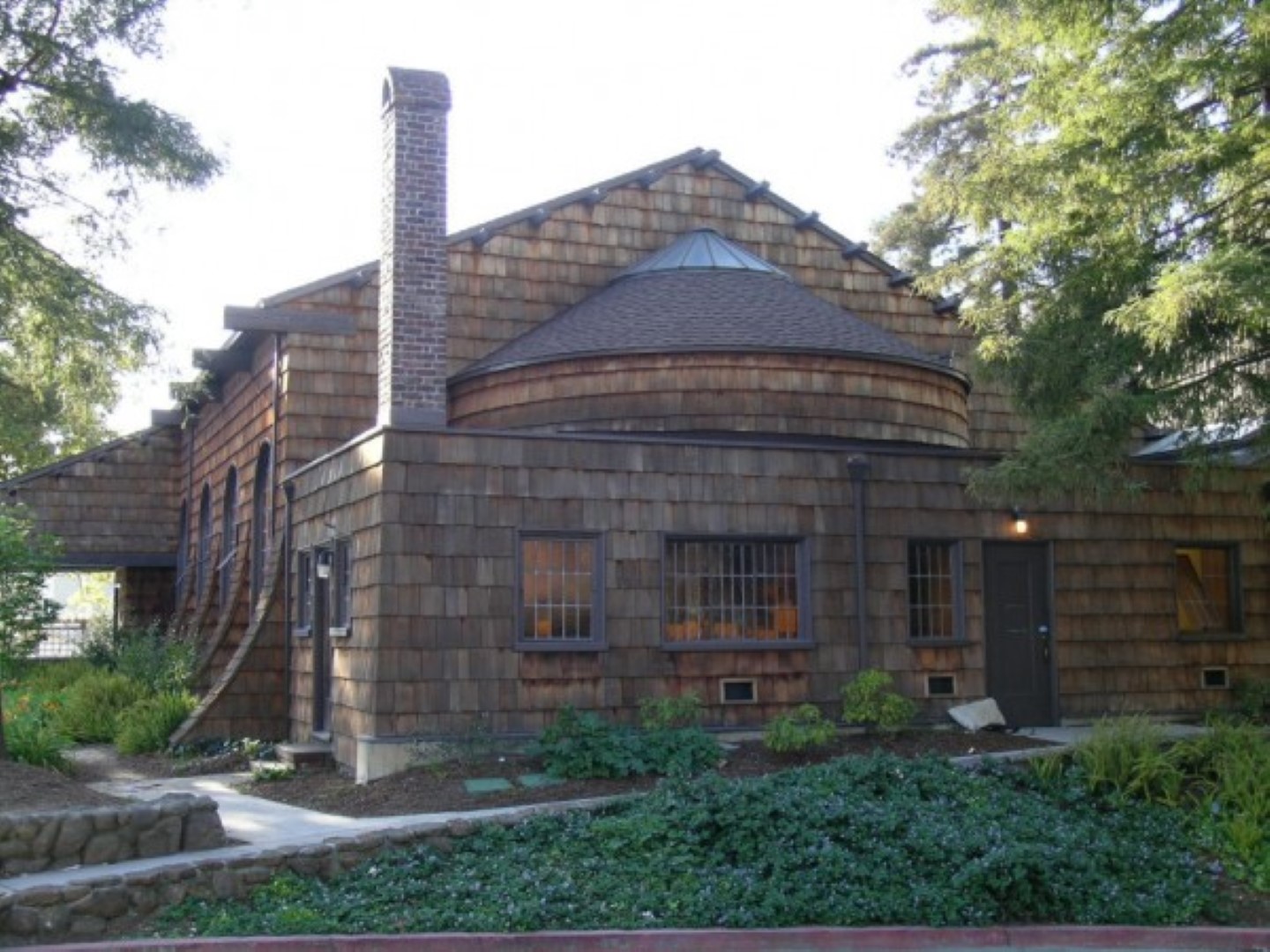
(Not my picture)
After that, we ventured outside to view some more of the bears. We headed out to the porte cochere. When they first opened the hotel, the column which greets you by the valet was completely blank. They went back to Susan Dannenfelser and Kirk Beck, the husband and wife team to ask if they could do more work for the hotel because it would much nicer if they could have a nice art piece to look at vs. the blank column. When they got the bears they thought they were kind of funny and asked what dance moves they were doing. It turns out she's a big football fan so one is the quarterback and one is the receiver. She actually dedicated each bear to someone who assisted with the designing and each of the bears has a name inscribed on the back of the tile.
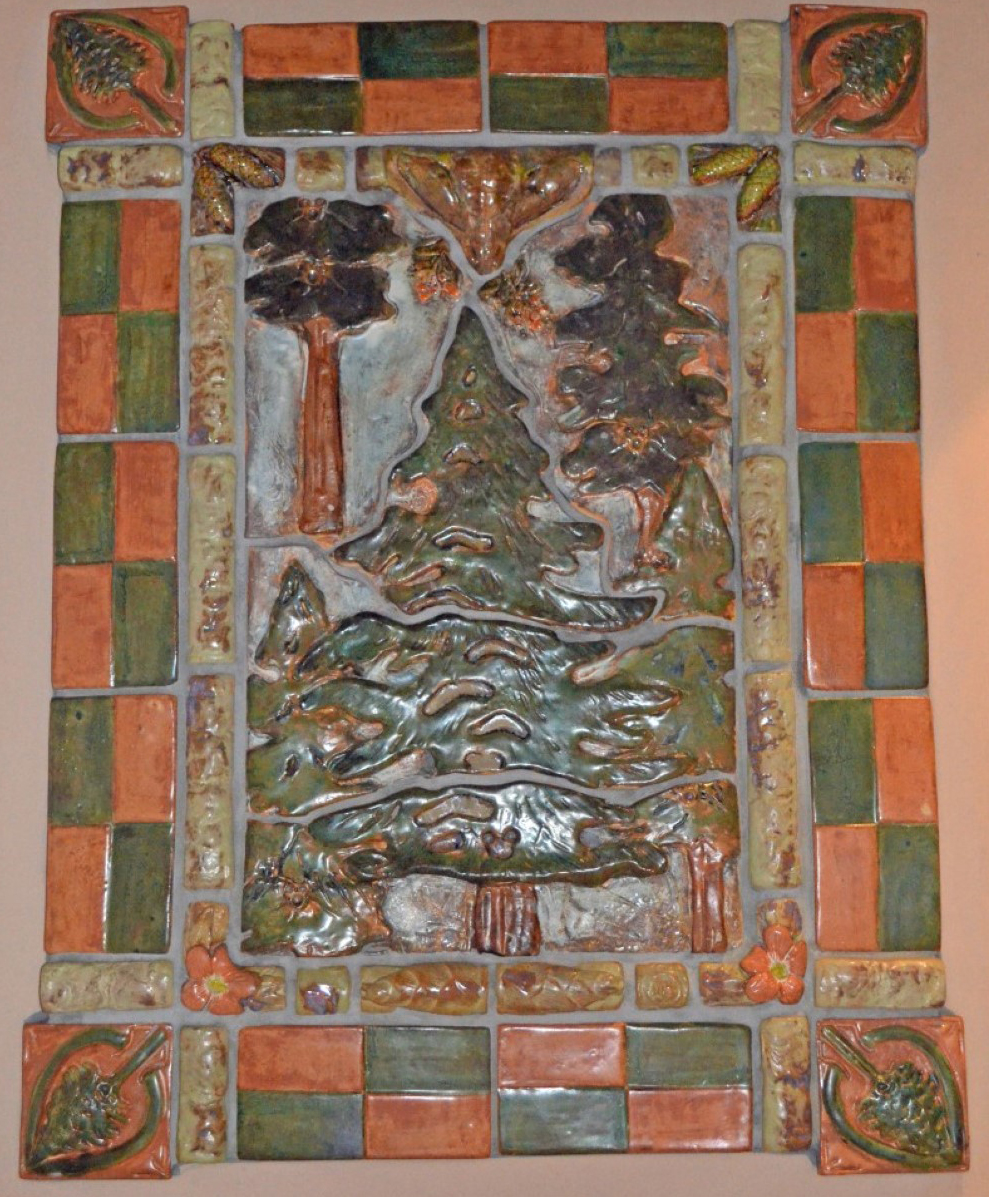
(Not my picture)
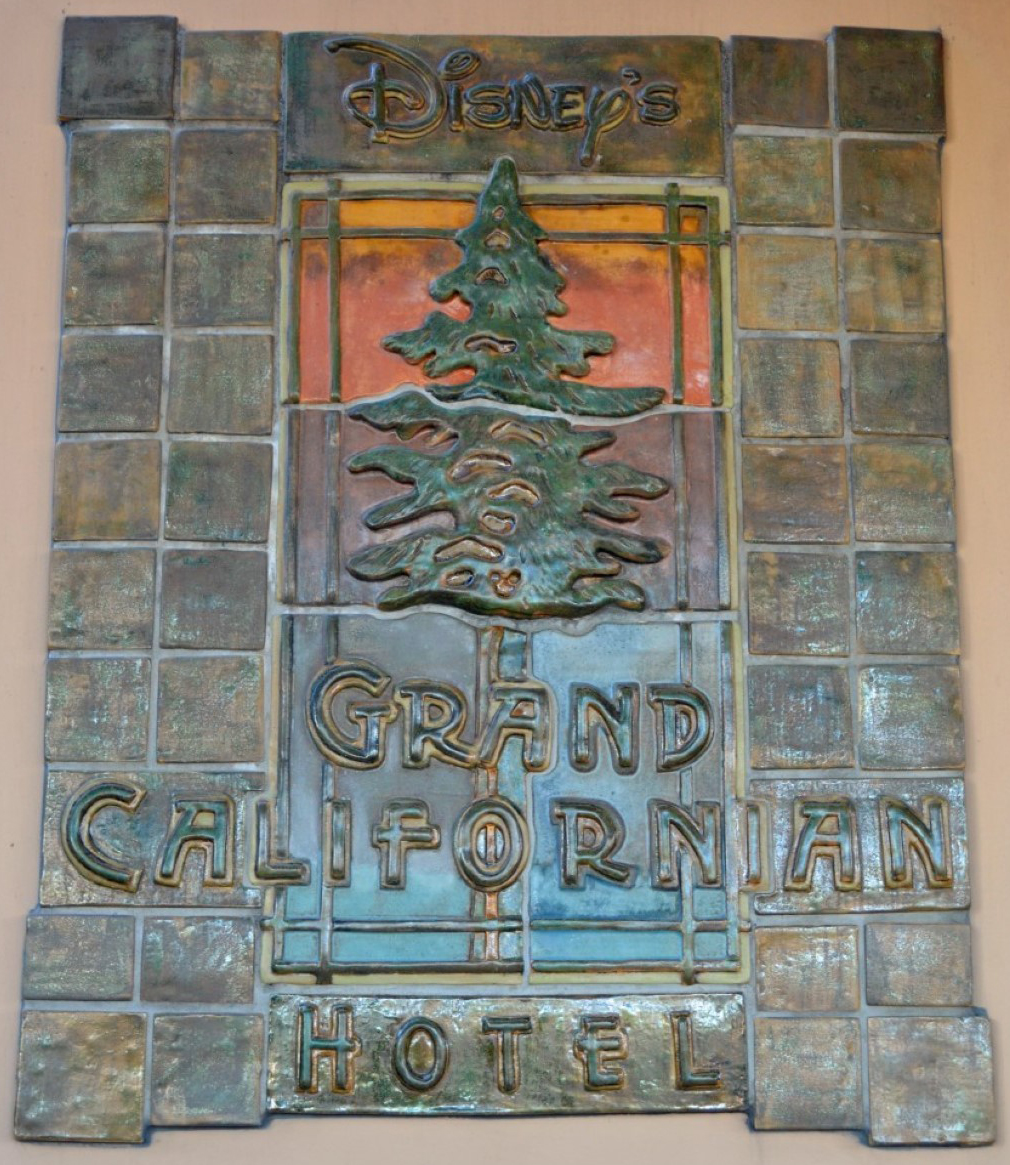
(Not my picture)
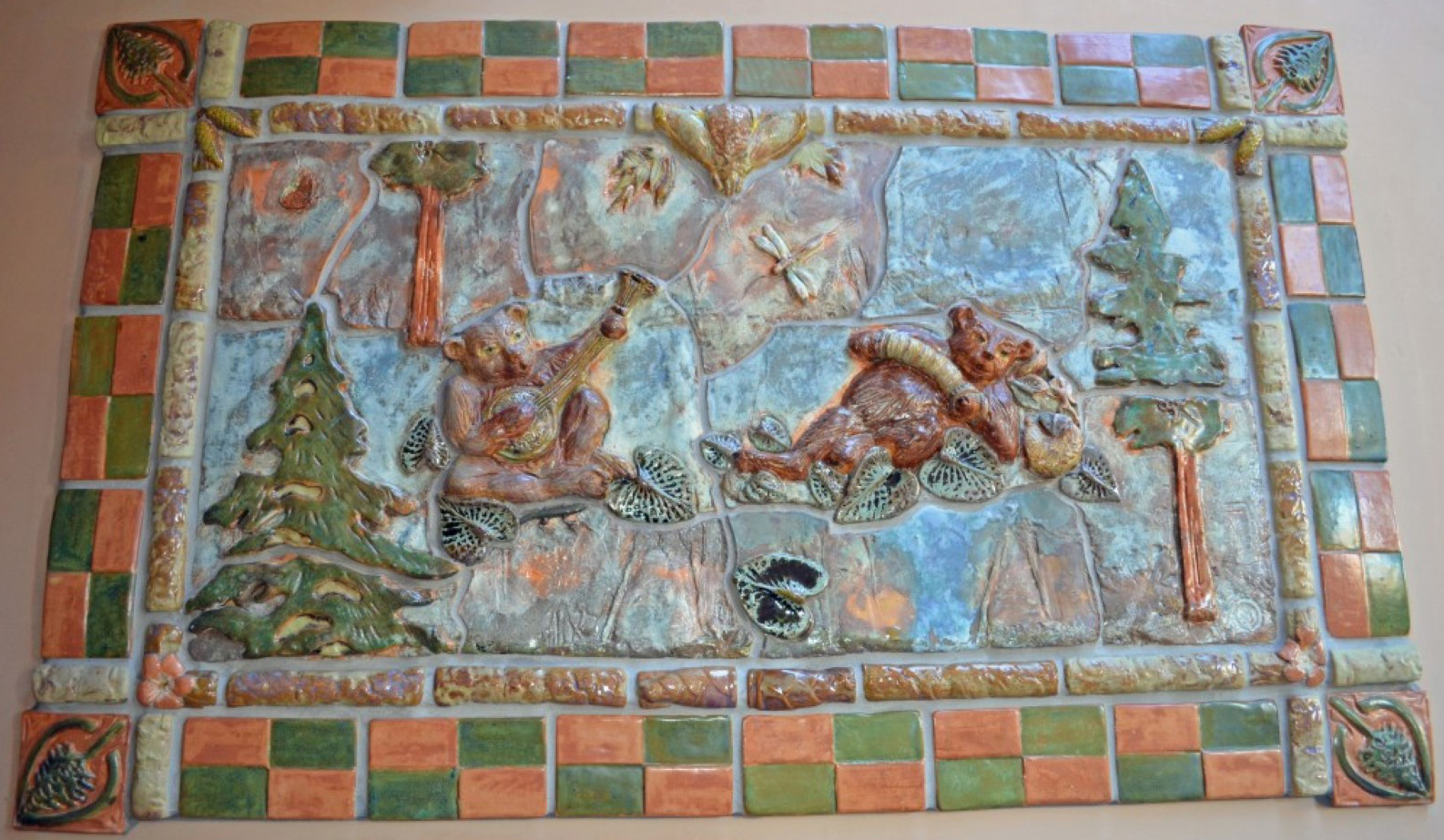
(Not my picture)
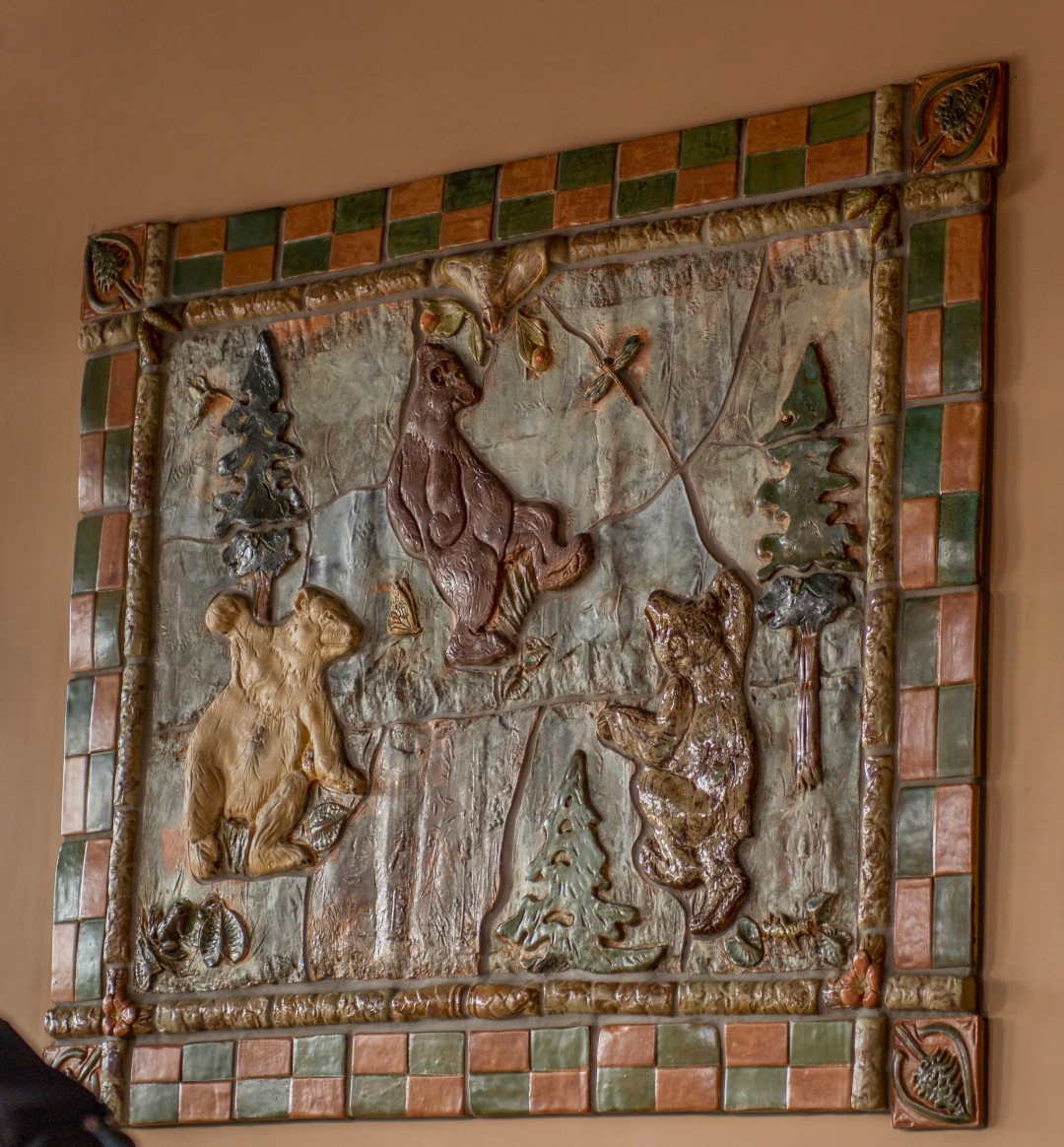
The most important part is the dark brown bear on the bell services desk. It's actually dedicated to all of you so thank you for coming and visiting.
Turning around, we looked and waited and waited and waited for the stained glass doors to close. This stained glass stems from the Gamble House in Pasadena. The Gamble house has a beautiful stained glass door with a Japanese Oak tree on it. The gamble house was actually built in 1908 and during that time period electricity was just brand new and they didn't have very bright burning lightbulbs like we have now. Back then if you could get a 35 watt lightbulb you were lucky. That's why the lamps are very dim. The idea was a solid wood door would hinder a lot of light and they wanted that natural light. Stained glass gave a nice artistic feel and also let light in without allowing people to see in through clear glass. On one side you have Grizzly peak which is the symbol of California Adventure. On the other side you have a redwood tree which symbolizes the hotel. When they come together it shows you how close they truly are. The hotel was actually supposed to be part of the theme park, but when they started building CA, they didn't know where they would put all the people who would come to visit the park so they took a chunk off and made the hotel. She likes to call it the free part of the theme park unless you stay here and then it's not so free. We headed around the corner and looked at the logo and she asked about the hidden mickey which everybody instantly pointed out at the top fo the tree trunk. We then headed down the walk way towards the conference center.
The Grand's doors..
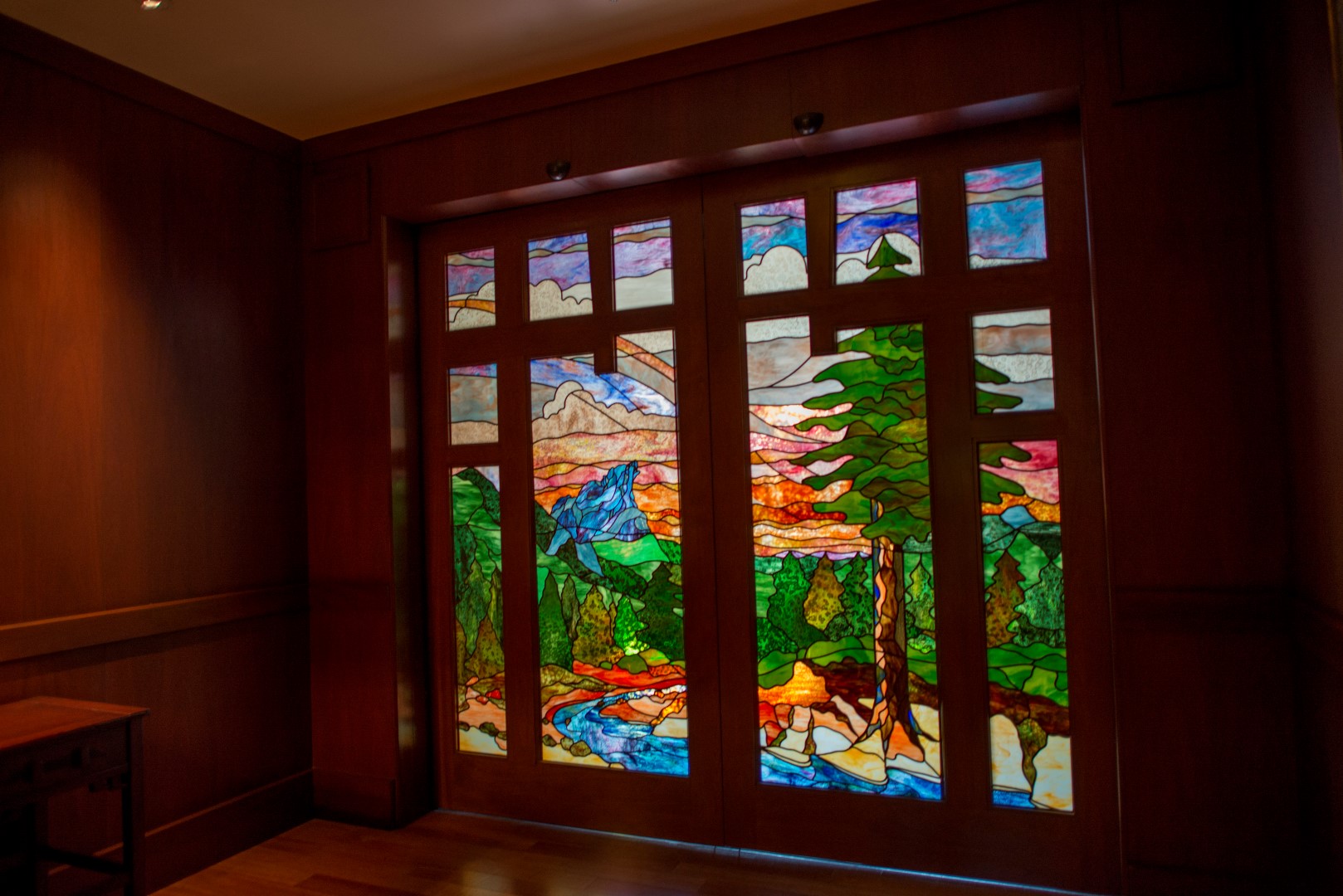
And the Gamble House's doors for reference:
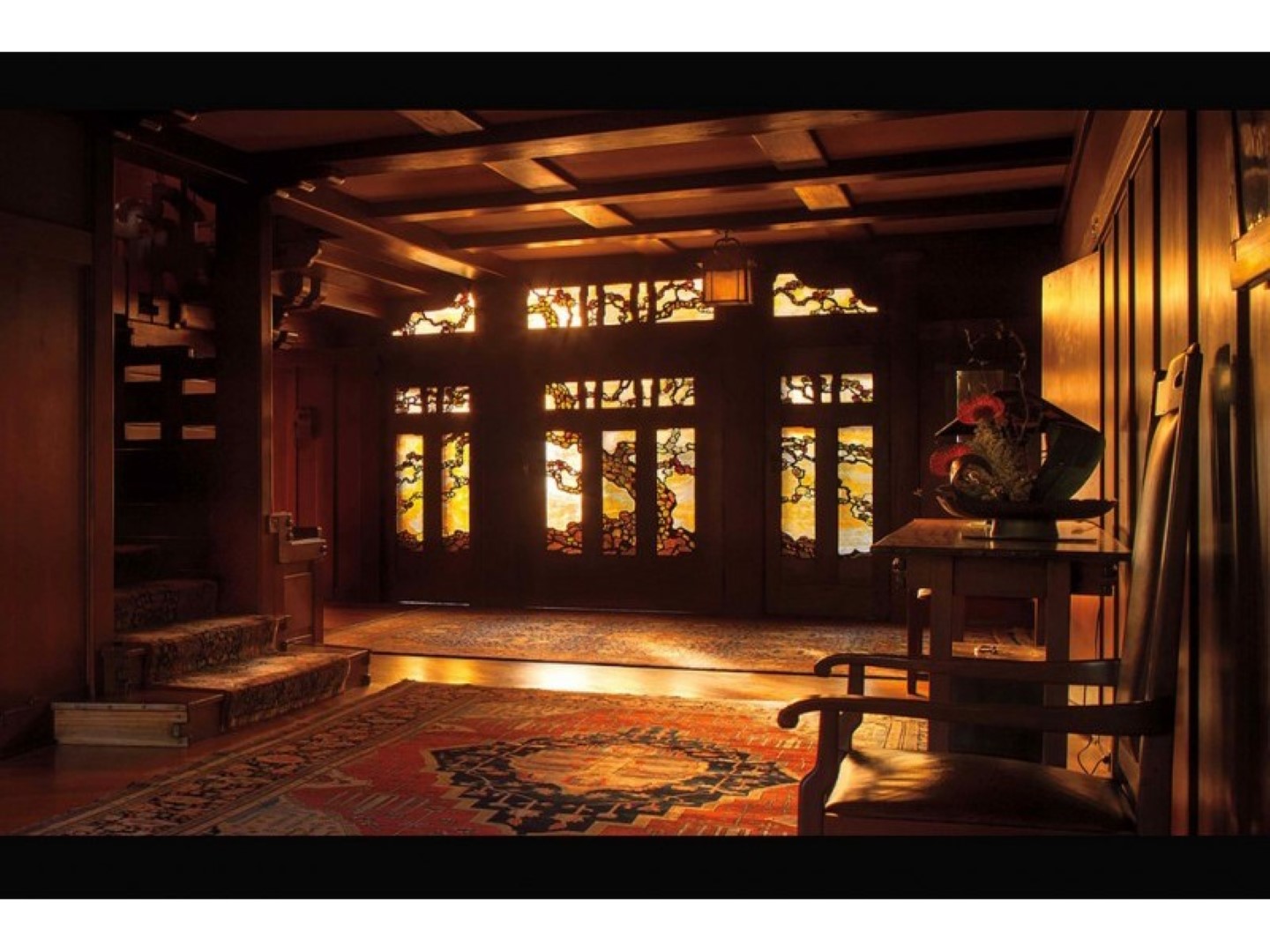
(Not my picture)
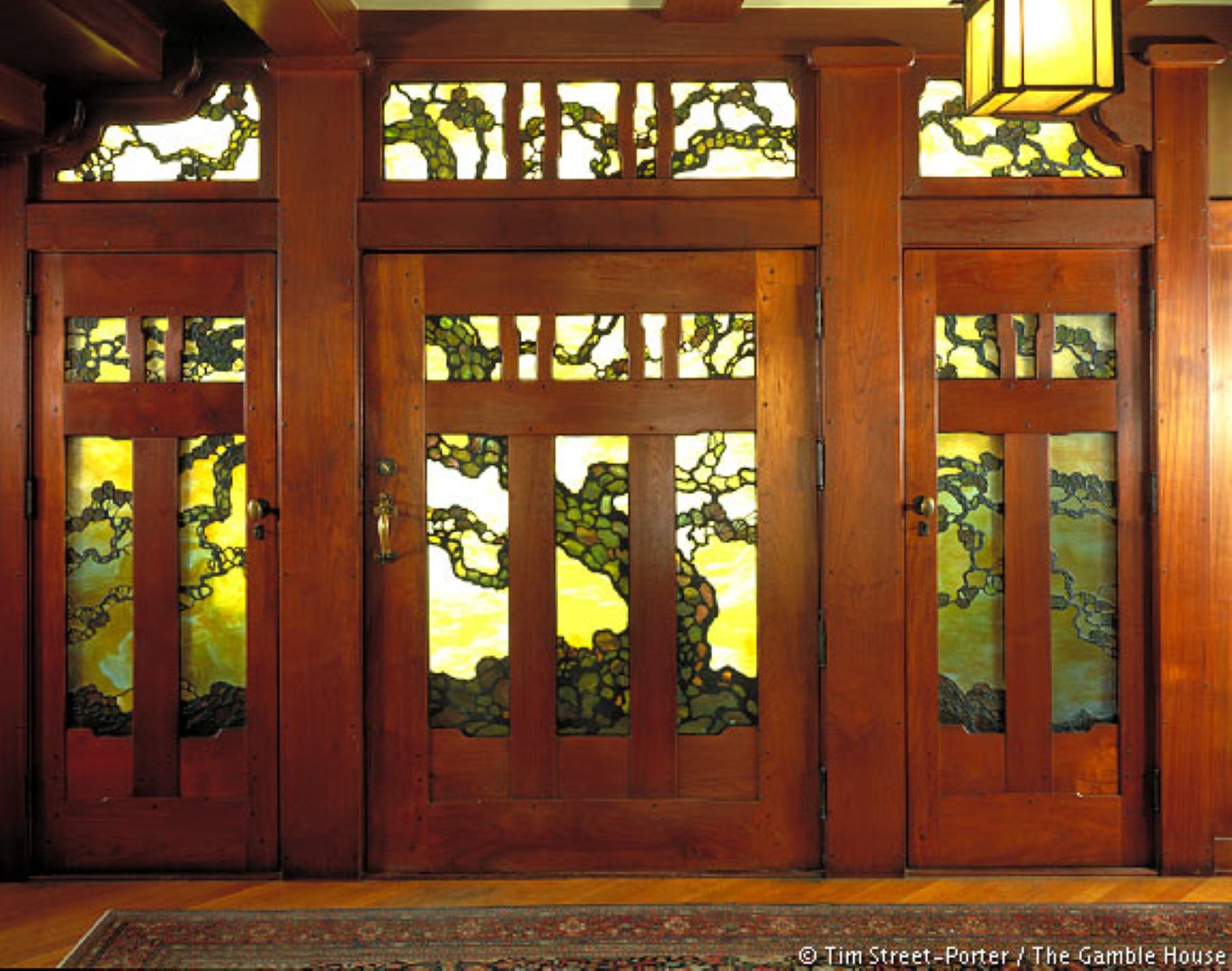
(Not my picture)
She then went into a brief synopsis of the front of the hotel. The shingling made it look more like a redwood tree but if you look at the front of the hotel you'll notice there isn't a lot of shingling. In 1906 there was a huge fire in Northern CA. As you know in CA, wood and fire get a long great. Unfortunately a lot of Bernard Maybeck's houses burnt to the ground and he was very very upset about it and he ended up creating one of the first concrete houses and it was called the Lawson house which is still around today. The fun part about it was he did beautiful etch work in the concrete and used art tile as well to make it more artistically pleasing. He couldn't get away from the redwood too much as you can see the trellis work on the top was missing from his house as he did keep the redwood for the roof. Luckily enough for him it has survived earthquakes and other fires that have gone through over the past century.
Here is a picture of the Lawson House in it's current state:
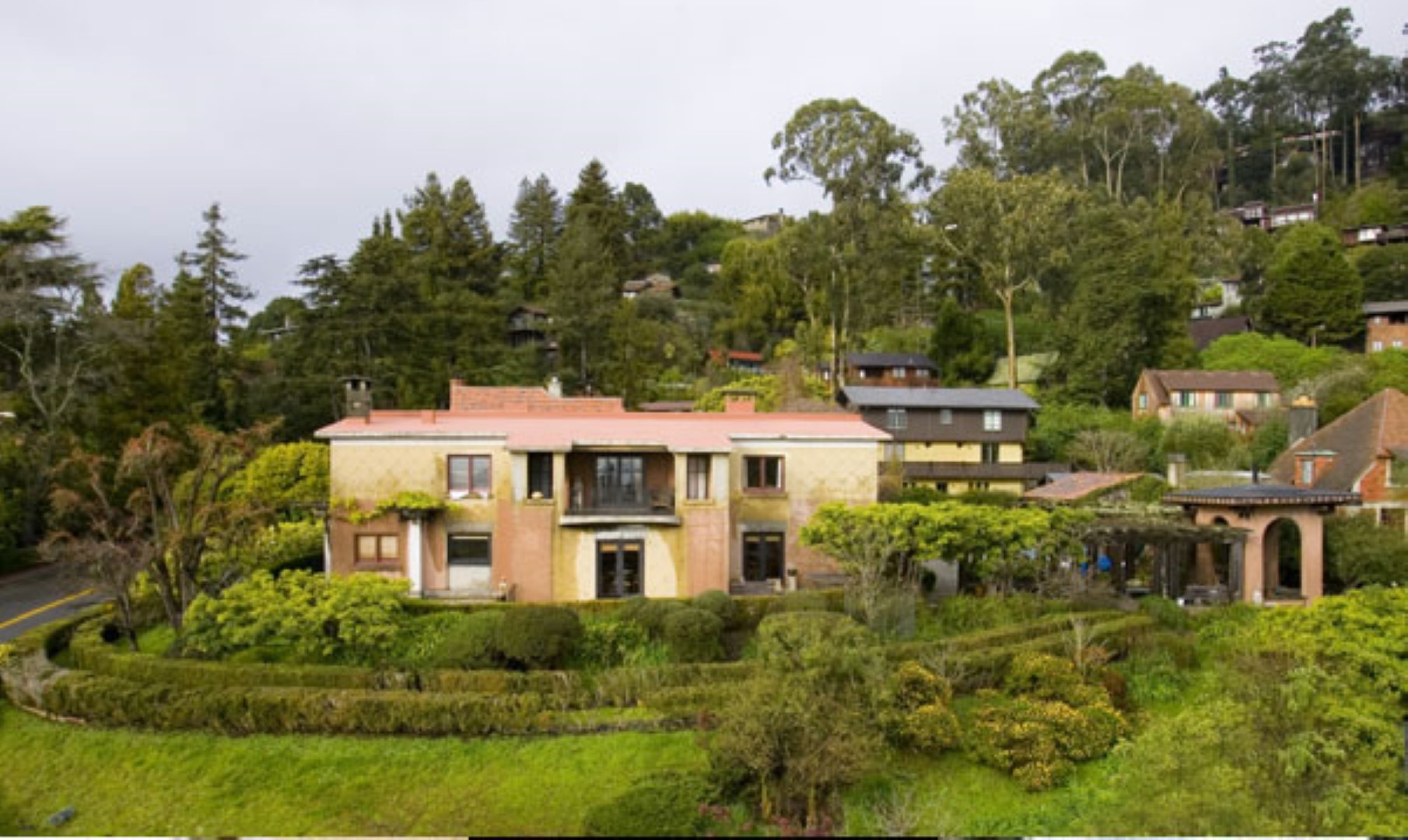
We were then ushered back in with the promise of some Frank Lloyd Wright. Welcome to the convention space. It was a little different from the main hotel. There were lighter colors and more natural lighting. Those are key patterns of FLW. He loved to utilize nature whether it be the lighting or trees. One of his houses he didn't want to cut the tree down so it's now in the center of his living room. (Robert's house). He really loved the natural look.
And the Elm tree in the Robert's House
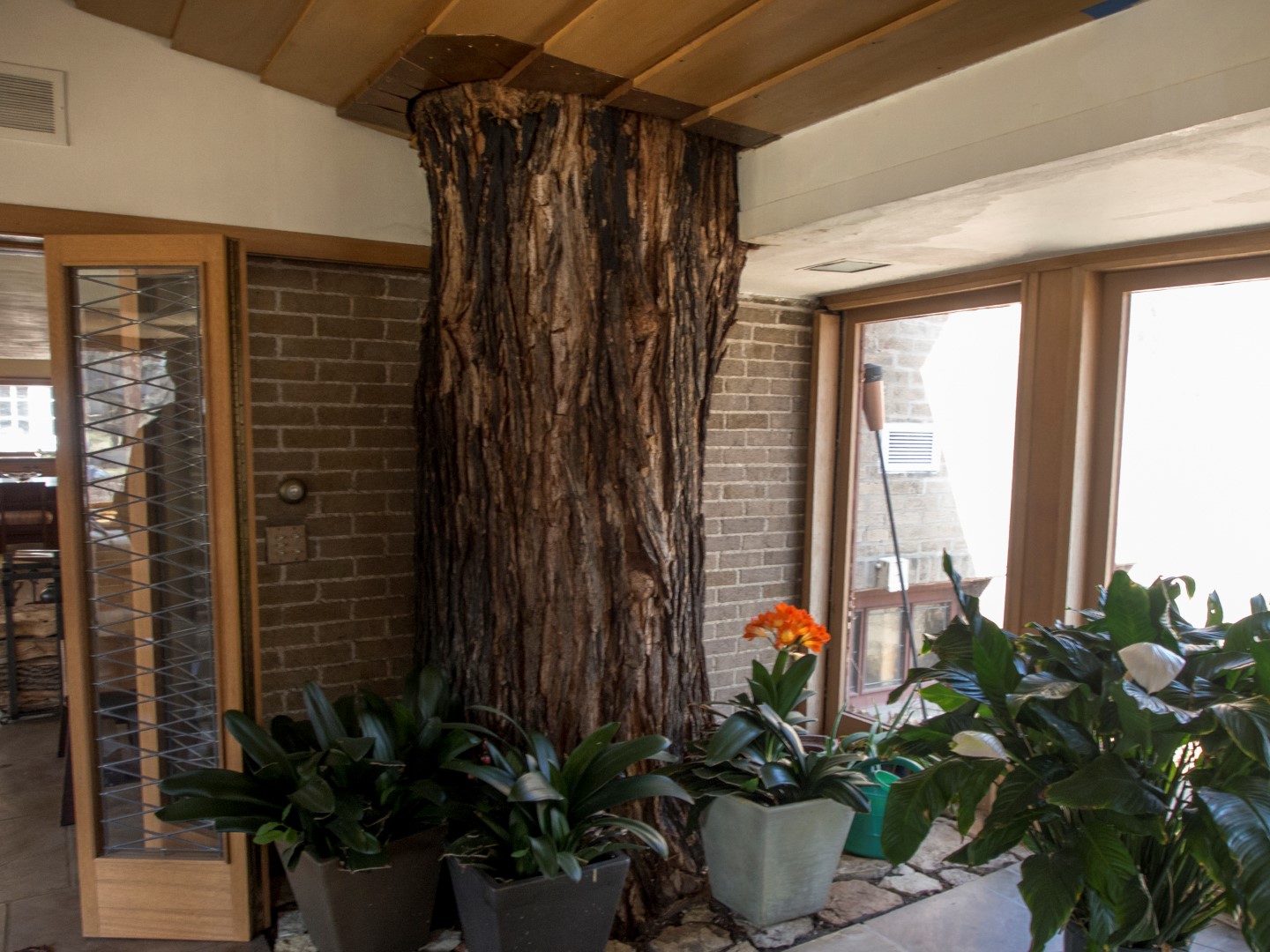
(Not my picture)
They didn't want to get too far away from the main hotel area so there is a darker trim, as well as the patterns are very similar along the walkways. We were taken in to the Board Room. The space is used for parties, weddings, conventions, and expos in the 20,000 square feet of interior event space. .
The California Boardroom had a foyer with two phone booths off each side which formerly had pay phones and its own M&F bathrooms as well. On the wall was a portrait of the Marin County Civic Center, one of FLW's first structures it was done in an En Plein Air Style which means open air. It was usually done by a painter who is painting it in quick 2-3 sittings using traveling artists with a limited palate of colors. It's usually small format around the size of a folio binder because they are traveling and cannot bring large canvases with them. They would sell their art and move on to the next town. If you are ever in San Juan Capistrano, they have a great exhibition of En Plein Air in the mission down there. Some are so small they need to have a magnifier on it so you can see all the details.
We were ushered in to the board room which is modeled after the Oak Park Playroom in PA. It has the same barreled ceiling, but this does not have the natural light the original has. The original playroom has a piano in an alcove inset in the wall at the far end and the mindset was when you played the piano, the entire room would act as the sounding board of the piano with the acoustics. As you can hear in the boardroom, the acoustics are also great which lead to them having to pad the walls. We were then instructed to try out the chairs, which are supremely soft, and it was mused about how anything can possibly get done by people sitting in such chairs. Instead of a piano, the board room just had a TV.. kind of a bummer.
The Canfornia Boardroom:
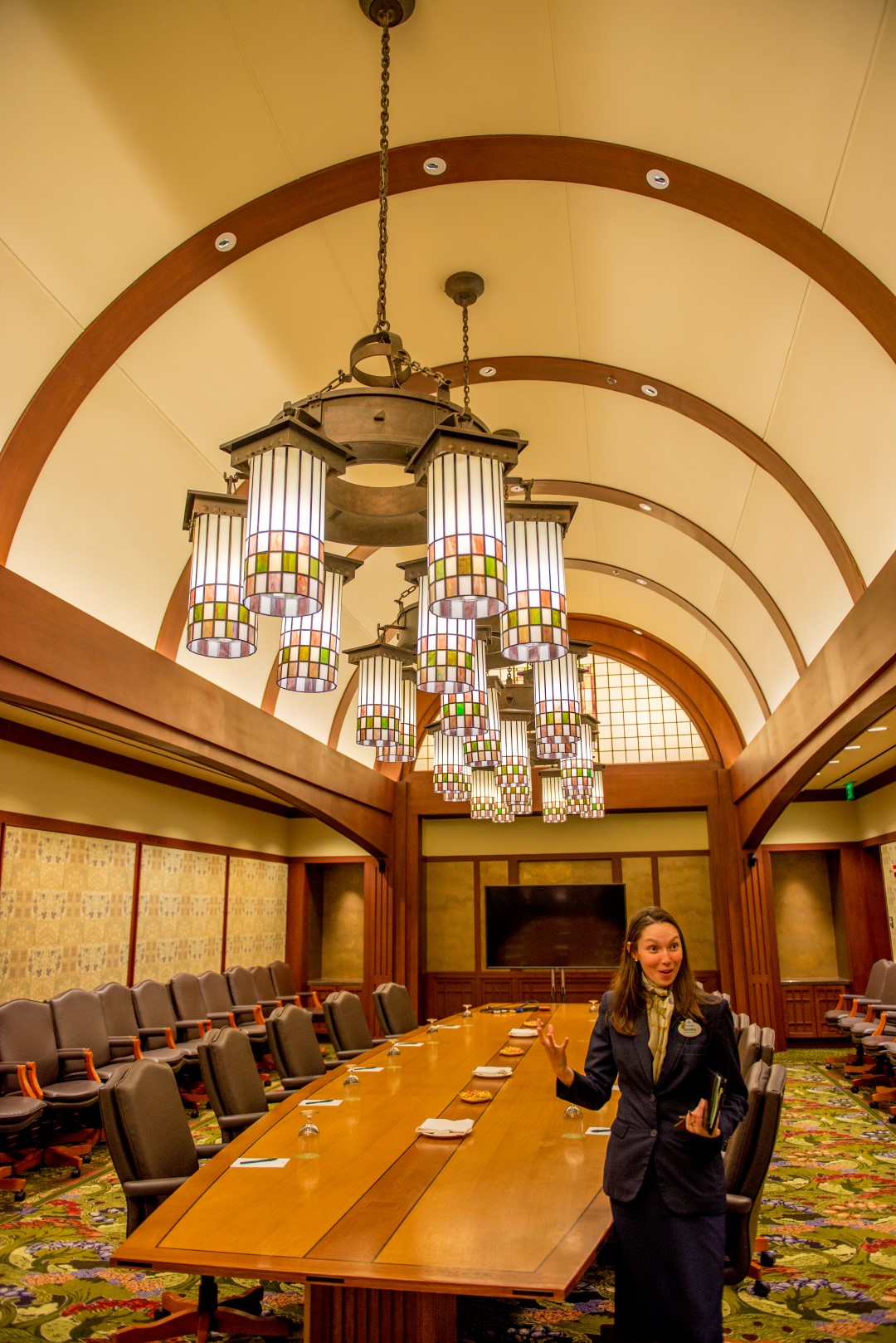
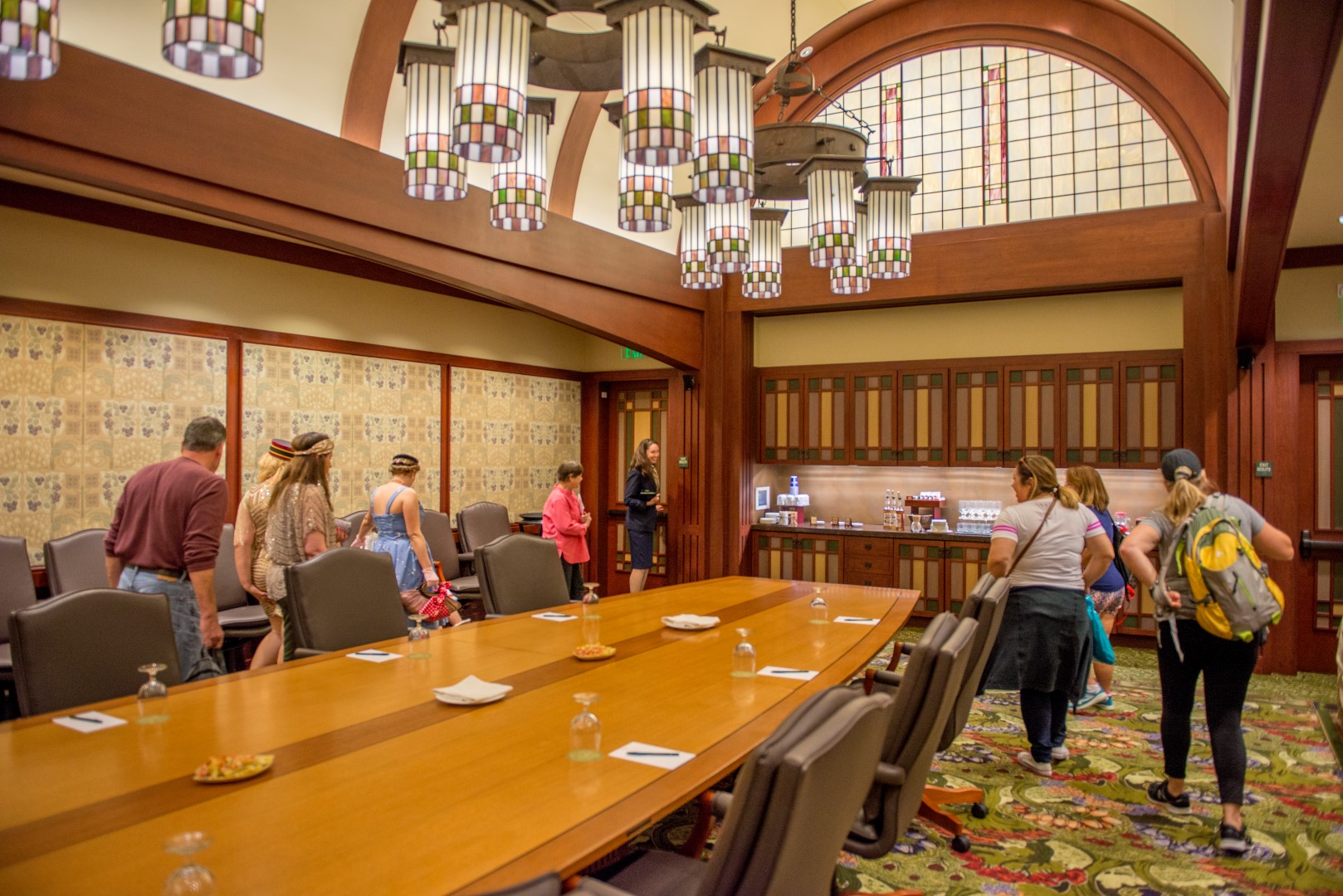
And the Oak Park Playroom for reference:
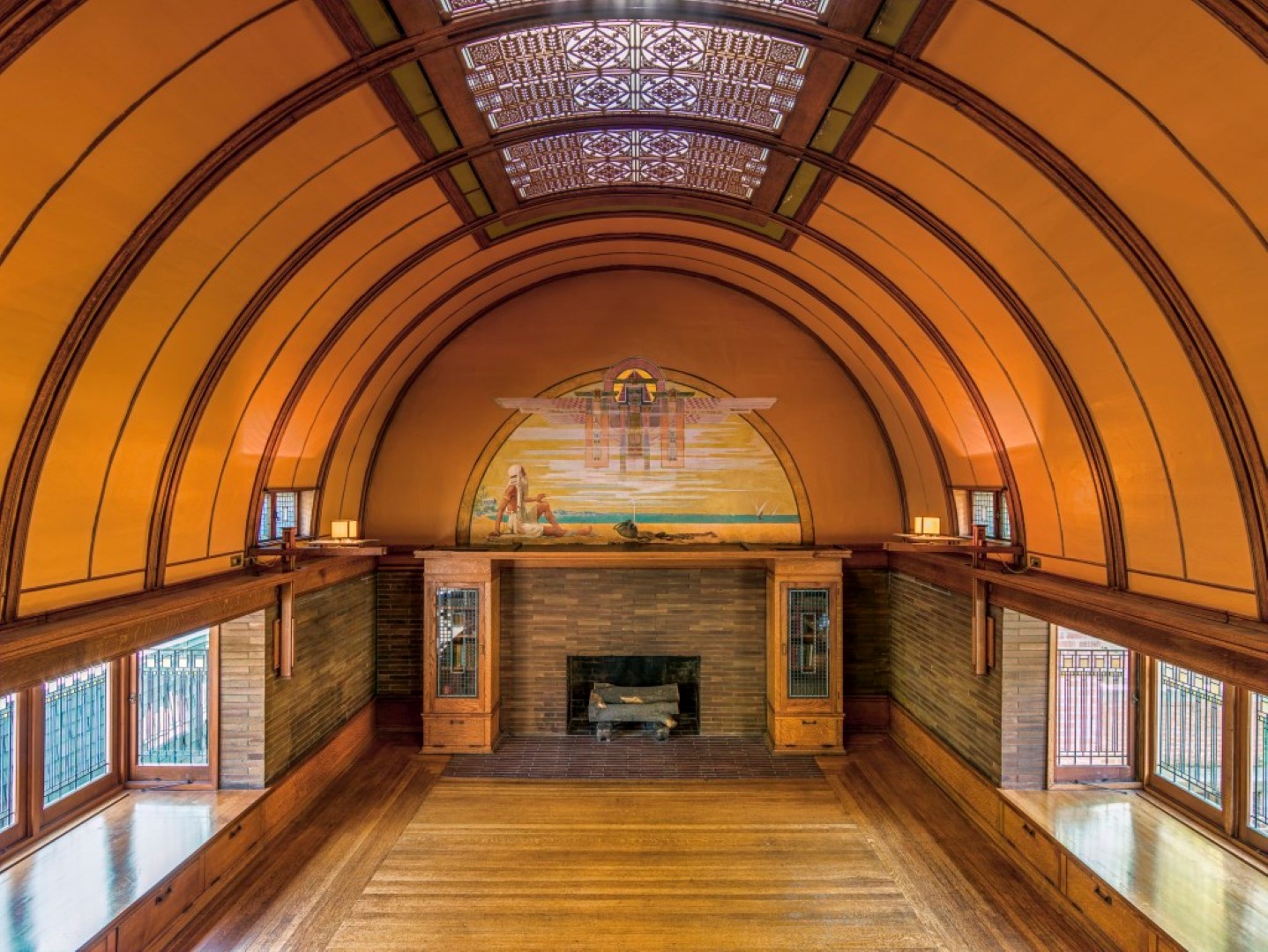
(Not my picture)
You can see the piano here:
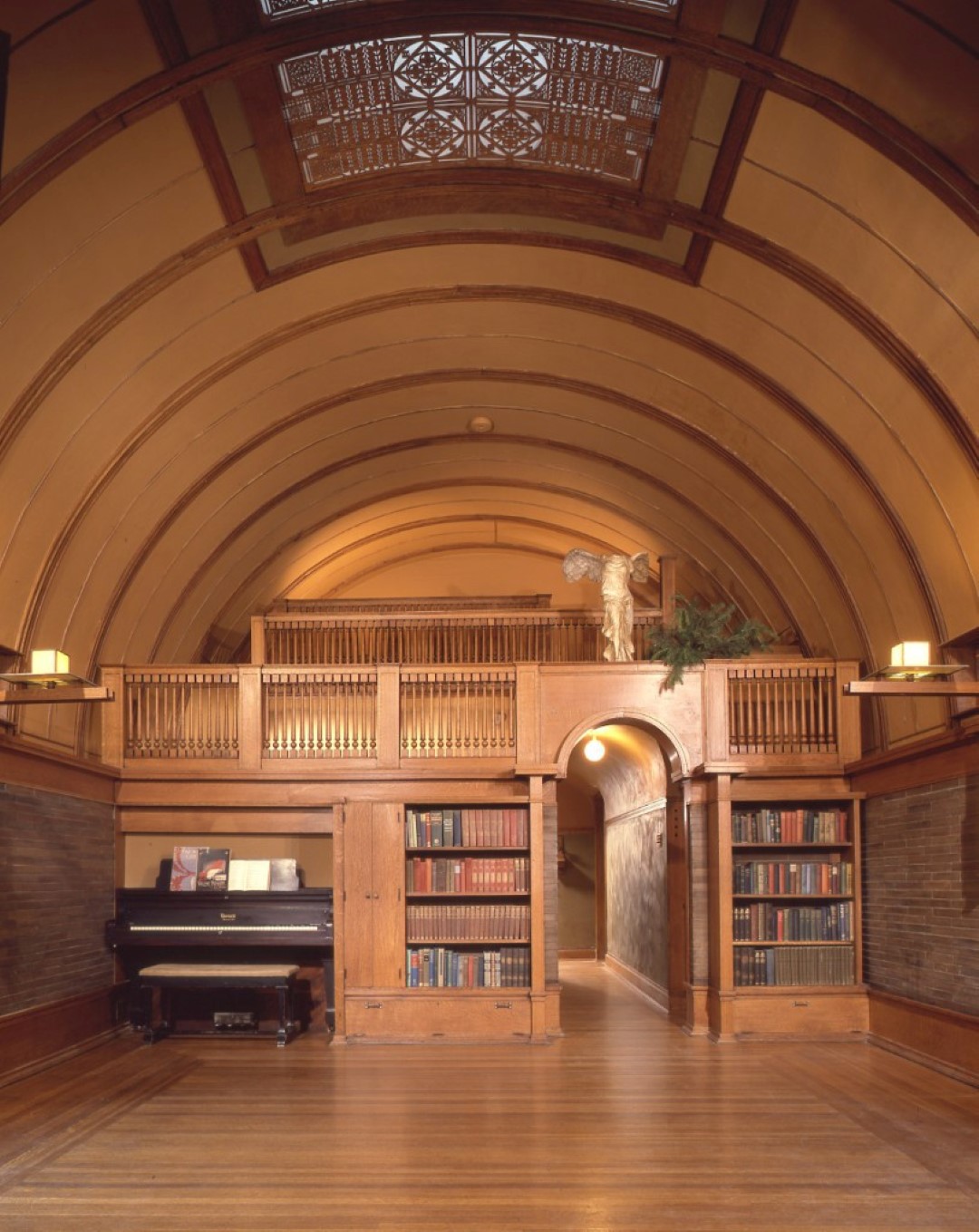
(Not my picture)
And finally Katherine... getting used to her future seat of power at the Disney company...
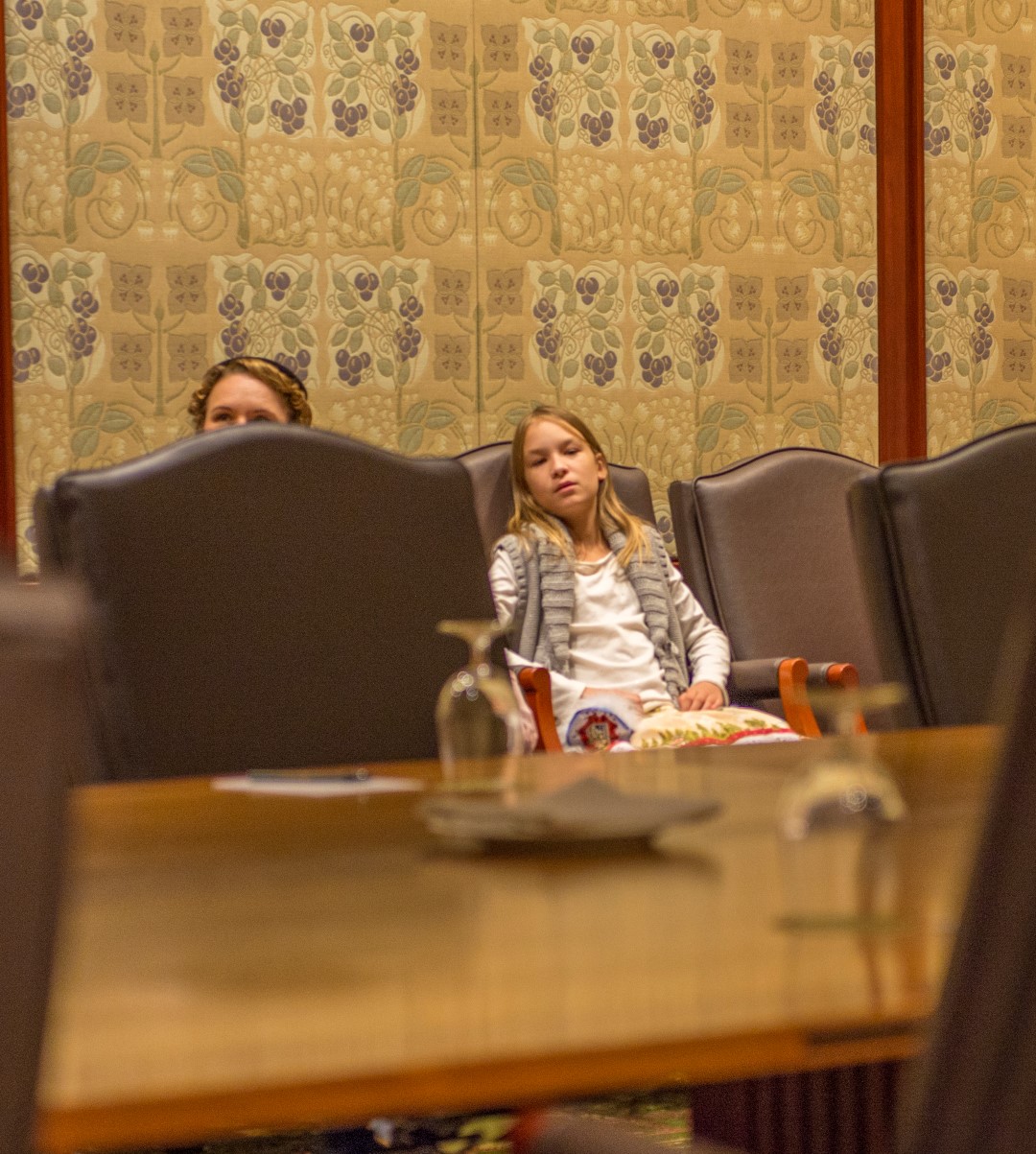
We exited the convention center and headed straight across to the Brisa Courtyard. Brisa means North wind, and as you can see from the Brick work, it's sort of like a tornado which is blowing you out to the North, which lead us North towards the DTD entrance..
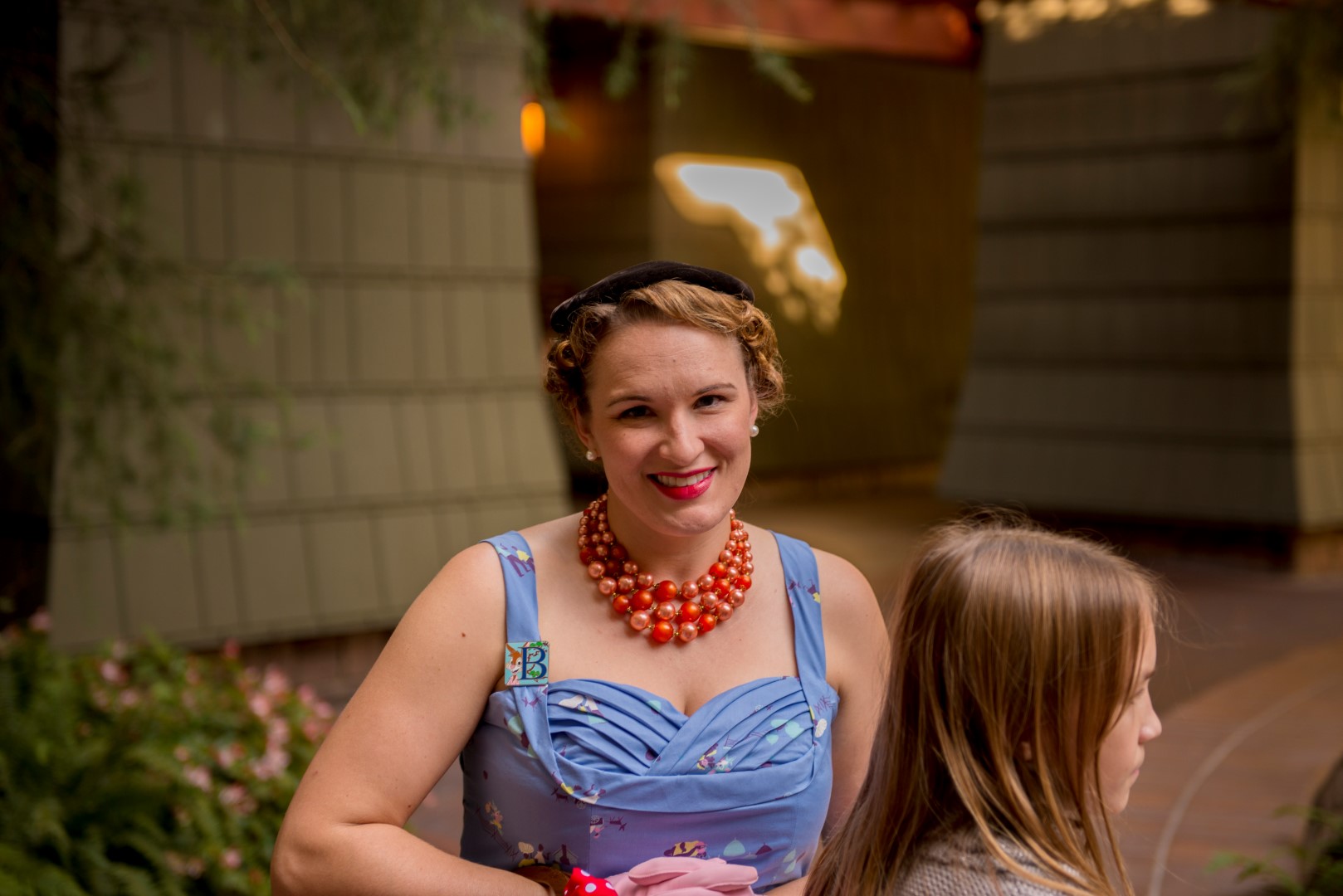
The idea continues with the lanterns going out to DTD with the wind blowing you that direction. The Brisa is the outdoor event area. They used to have more, but the DVC wing currently sits where those spaces were. As she mentioned at the beginning of the tour back out front, they had the shingling on the front of the hotel to make it look like a redwood tree. In the courtyard, it is a different color, green. If this was a redwood tree, this would be the North-facing part of the tree, or the mossy side. The Artisan Program was mentioned again as well as the multiple art pieces. Two were rather large. One, the flooring in the lobby which we would get to in a bit and secondly, beautiful gates going into DTD. She ran up to close one side of the gates while we waited. The gates were created by a gentleman by the name of Tim Burrows from MI. https://www.facebook.com/TimBurrowsMetalArtandDesign/
He did two other gates at The Grand. This one was named for the Blue moon inset into it, and yes, that is Tiffany glass. The theme is you are in a forest and walking out into a clearing known as DTD. Not many people can see that because it's always open. In the ten years our guide had worked there, it has only been closed twice. She asked if anybody had seen it before and I had to chime in about having seen it many moons ago on the cover of American Bungalow.
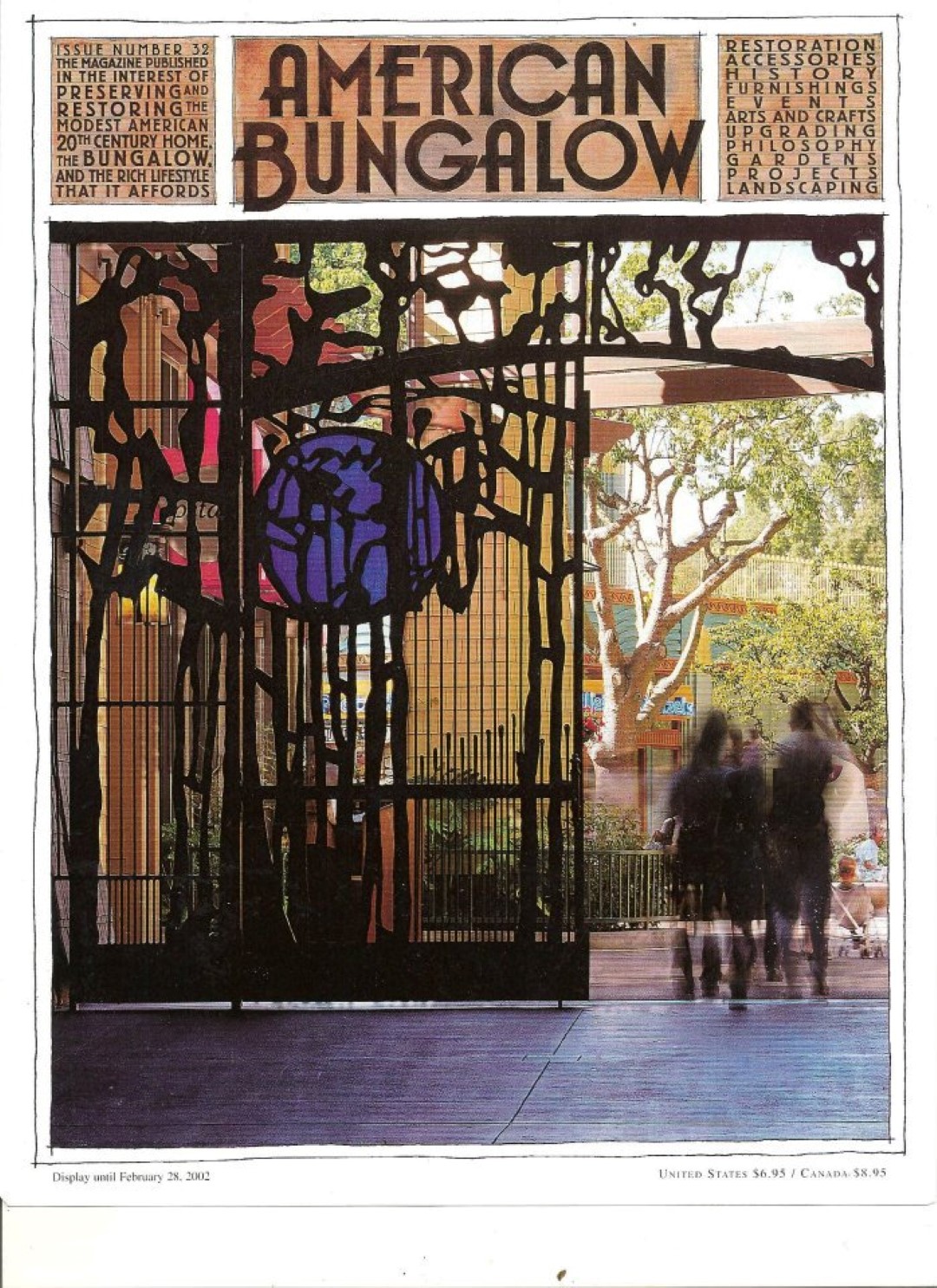
Yes, I have that issue amongst my extensive collection of Arts & Crafts periodicals.
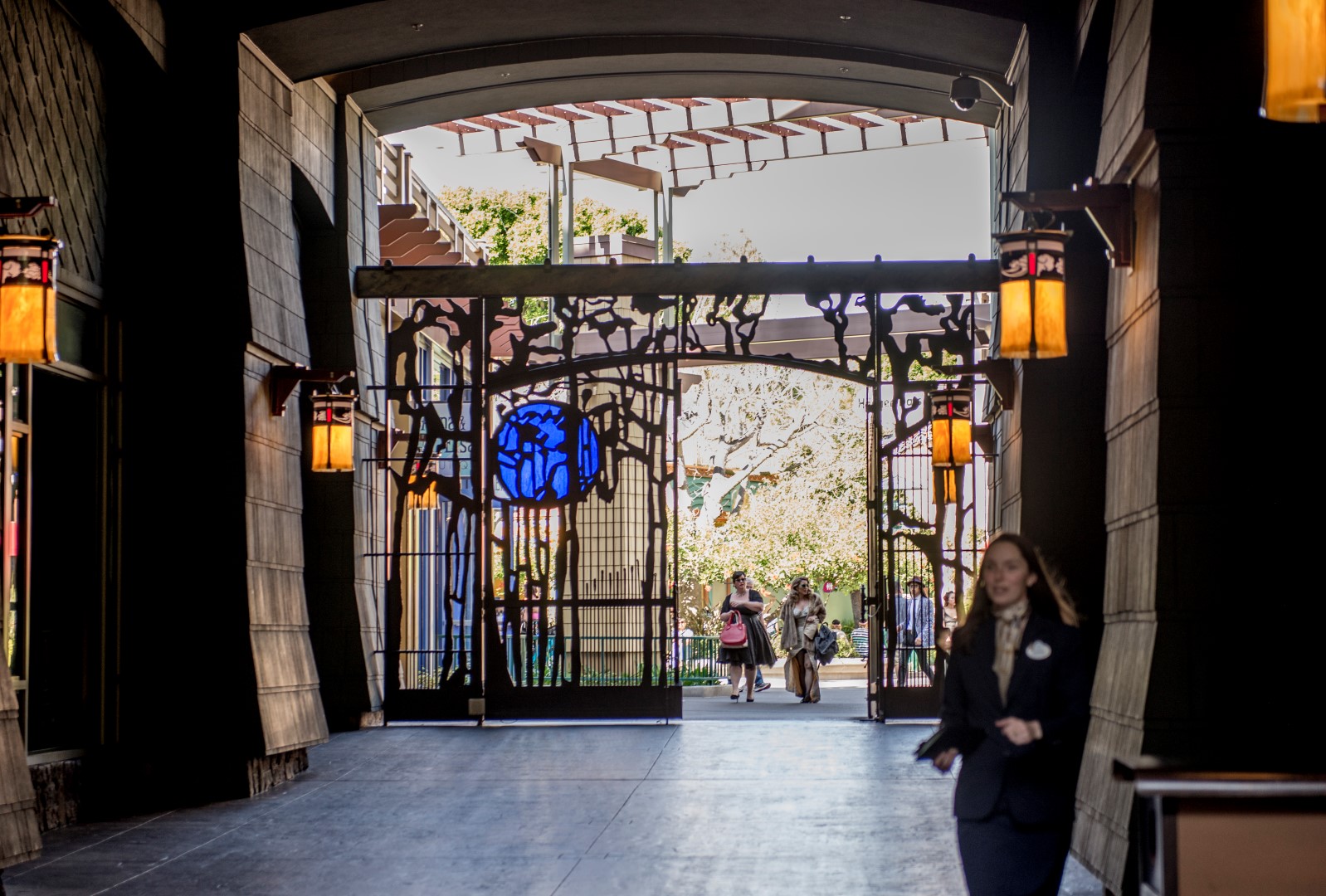
As we walked, I struck up a conversation with our guide. She asked about my interest in CARTS AND CRAFTS. Asked if I had been to the Gamble house, which regrettably, I have not. She mentioned the Grand's lead facilitator has close contacts with them and they send updates about what they discover during their restoration activities.
She talked about the refurbishment pictures hanging up and the materials as we passed into the lobby. When we first walked in, the cabinets were prevalent. There are four cabinets, and all are different. 4 different artisans created them. The one we were positioned in front of had the bears which mimicked those of the front desk. This one was her particular favorite because of what was inside it.. Roycrofters... There was a gentleman by the name of Elbert Hubbard. He was the leading Larkin soap salesman in Buffalo New York and he loved to write, but without a college degree, nobody would publish him. So he got frustrated by this and traveled to Europe. Remember when she said the founding father was William Morris.. well they happened to meet up, just by chance. William Morris also published some of his own books with the Kelmscott Press.
In 1891 Morris rented a cottage near Kelmscott House in England and set up three printing presses. He had long been interested in the printing and the binding of fine books, and there, influenced by mediaeval illuminated manuscripts and the work of early printers, he would design and manufacture beautiful editions of over fifty books written by himself as well as others. The books issued by the Kelmscott Press were expensive as Morris designed his own typefaces, made his own paper, and printed completely by hand. They were worth it though, and ever so beautiful. They were designed to be read slowly, to be appreciated, to be treasured, and thus made an implicit statement about the ideal relationships which ought to exist between the reader, the text, and the author — a statement which we have, by and large, continued to ignore. Elbert Hubbard thought that was brilliant, came back to NY, built his own press named the Roycrofter press and said "if you won't print me, I'll print myself". The most popular book of his was "A thousand and one Epigrams"
https://www.disboards.com/threads/katherines-10th-birthday-trip-for-dapper-day-and-club-33.3560733/
And here we go......
We started in the far end of the Lobby. There were several pictures of people building Arts & Crafts resorts.

Our tour started with our guide reminding us that the ARTS AND CRAFTS movement started in the late 1800s, early 1900s and started over in Great Britain. It started in the time period where industrialization was coming about and machines were replacing entire shops... This upset the craftsmen because their jobs were being lost. That started John Ruskin to start writing about the movement featuring nature in design and the importance of craftsmanship. A fan of his writings, a gentleman by the name of William Morris. The Tapestries you see in the hotel were inspired by William Morris. The children's sized rocking chairs in front of the TV are Morris Chairs... He took John Ruskin's writing and put it to life. He had Morris & Company and hired a lot of those craftsman to build anything from tapestries to furniture. Here we fast forward to the United States...and talk about a gentleman named Bernard Maybeck who was considered the founding father of ARTS AND CRAFTS in California. She points to Maybeck in a picture hanging in the lobby...which is picturing Burbank California and playhouse he designed.

In another picture he was modeling one of the main ideas of the ARTS AND CRAFTS movement. Which was whoever designs it also builds it. The structure pictured was built in 1918. Unfortunately due to the fact that nobody did upkeep or maintenance, it was torn down in 1974. Frank Lloyd Wright - Falling Water in Bear Run, PA. The fun thing about the house is not only does it institute all the natural resources from the area, the sandstone was quarried from there, all the wood he utilized, but he also did a cantilevered design so half the house is hoisted over the river to show that merge between nature and design itself.
Pictured is this print of Falling Water Under Construction

Inside our main hotel area they do not have very much FLW in it. Some of the lamps are in his style. This photo is the hosts all-time favorite ARTS AND CRAFTS structure... this hotel. Most of this hotel is modeled after the Charles and Henry Greene brother's structures. She asked if anybody was aware of the Gamble House. Charles and Henry were well known for that house and structure in their buffalo style and craftsman style. One of the main ideas of a craftsman home was called an ingelnook: you'd have a huge room with nooks and crannies you could sit in and enjoy the hustle and bustle of the main portion of the house and still be away. For example, the lobby is a huge room, but there are nooks and the fireplace area where you can still see what's going on but be out of the way.
The aforementioned picture of the Grand's Fireplace nook under construction..

Peter Dominick was the designer for this hotel. Our guide asked if anybody had been to WDW. A few hands went up. She then inquired if we had seen the animal kingdom lodge or the wilderness lodge. Peter Dominick was also the designer of those as well. If it has Lodge in the name, he probably helped in some way, shape, or form. PD had the biggest challenge, which was taking a bungalow style home which is quaint and making it into a 745 room hotel. She asked who would want that challenge, to which only I raised my hand. She then proceeded to tell us how he did it and turned us around looking back down the reception area.
Before we proceed, let me apologize for the next few images. I didn't have any readily available, so these are the best I could source on short notice.. I promise to come back and rectify these shots after the next trip and any I did not shoot myself will be noted under them.
Behind the front desk you see three tapestries. On the far end you have one which looks like a garden.

(Not my picture)
As she had previously mentioned, bungalow style homes are usually modeled after the gardens which surround them. What would be like a garden, just bigger? A forest and this is where this next tapestry comes in.

(Not my picture)
The entire hotel is modeled after forests and has a forest surrounding it. In the middle was a tapestry of the hotel itself.

(Not my picture)
Down in front you have the lovely lamps which were made for the hotel by Dale Tiffany and feature four California critters. Quail, Salamander, Butterfly, and a Snail. Down below you have for the four seasons.
They have something called the artisan program. The artisan program is made up of 30 different individuals/companies who contributed to the bungalow-style craftsman-style hotel. These are three of them, the dancing bears through the four seasons is her personal favorite. They were done by a husband and wife team from the Berkeley area. The wife hand molds the tiles out of terracotta and the husband does the installation. They also did several other pieces of art for the hotel.

(Not my picture)

(Not my picture)
While we are in the reception area, she wanted to point out the ceiling. We wanted a welcoming, open, yet comforting feeling when you first walked in. This particular section of the lobby is modeled after First Unitarian church built by Albert C. Schweinfurth and Bernard Maybeck and was one of the first structures he built and built in 1894 and is still standing today. The fun part about it, in the worship area, they actually shipped down Madrones trees from Santa Barbara and steamed them so they would bend over all the pews. Luckily enough ours is made out of Disney wood, so it was easy to bend. They are still standing today, so if you look them up or go up to visit it up in Berkeley, the tree trunks are still bent over the worship area today. It is supposed to symbolize spiritual growth in life and the church, but here it is just a welcoming feeling.

So far as I can tell, this is the Church in question, however I've been unable to locate any interior pictures..

(Not my picture)

(Not my picture)

(Not my picture)
After that, we ventured outside to view some more of the bears. We headed out to the porte cochere. When they first opened the hotel, the column which greets you by the valet was completely blank. They went back to Susan Dannenfelser and Kirk Beck, the husband and wife team to ask if they could do more work for the hotel because it would much nicer if they could have a nice art piece to look at vs. the blank column. When they got the bears they thought they were kind of funny and asked what dance moves they were doing. It turns out she's a big football fan so one is the quarterback and one is the receiver. She actually dedicated each bear to someone who assisted with the designing and each of the bears has a name inscribed on the back of the tile.

(Not my picture)

(Not my picture)

(Not my picture)

The most important part is the dark brown bear on the bell services desk. It's actually dedicated to all of you so thank you for coming and visiting.
Turning around, we looked and waited and waited and waited for the stained glass doors to close. This stained glass stems from the Gamble House in Pasadena. The Gamble house has a beautiful stained glass door with a Japanese Oak tree on it. The gamble house was actually built in 1908 and during that time period electricity was just brand new and they didn't have very bright burning lightbulbs like we have now. Back then if you could get a 35 watt lightbulb you were lucky. That's why the lamps are very dim. The idea was a solid wood door would hinder a lot of light and they wanted that natural light. Stained glass gave a nice artistic feel and also let light in without allowing people to see in through clear glass. On one side you have Grizzly peak which is the symbol of California Adventure. On the other side you have a redwood tree which symbolizes the hotel. When they come together it shows you how close they truly are. The hotel was actually supposed to be part of the theme park, but when they started building CA, they didn't know where they would put all the people who would come to visit the park so they took a chunk off and made the hotel. She likes to call it the free part of the theme park unless you stay here and then it's not so free. We headed around the corner and looked at the logo and she asked about the hidden mickey which everybody instantly pointed out at the top fo the tree trunk. We then headed down the walk way towards the conference center.
The Grand's doors..

And the Gamble House's doors for reference:

(Not my picture)

(Not my picture)
She then went into a brief synopsis of the front of the hotel. The shingling made it look more like a redwood tree but if you look at the front of the hotel you'll notice there isn't a lot of shingling. In 1906 there was a huge fire in Northern CA. As you know in CA, wood and fire get a long great. Unfortunately a lot of Bernard Maybeck's houses burnt to the ground and he was very very upset about it and he ended up creating one of the first concrete houses and it was called the Lawson house which is still around today. The fun part about it was he did beautiful etch work in the concrete and used art tile as well to make it more artistically pleasing. He couldn't get away from the redwood too much as you can see the trellis work on the top was missing from his house as he did keep the redwood for the roof. Luckily enough for him it has survived earthquakes and other fires that have gone through over the past century.
Here is a picture of the Lawson House in it's current state:

We were then ushered back in with the promise of some Frank Lloyd Wright. Welcome to the convention space. It was a little different from the main hotel. There were lighter colors and more natural lighting. Those are key patterns of FLW. He loved to utilize nature whether it be the lighting or trees. One of his houses he didn't want to cut the tree down so it's now in the center of his living room. (Robert's house). He really loved the natural look.
And the Elm tree in the Robert's House

(Not my picture)
They didn't want to get too far away from the main hotel area so there is a darker trim, as well as the patterns are very similar along the walkways. We were taken in to the Board Room. The space is used for parties, weddings, conventions, and expos in the 20,000 square feet of interior event space. .
The California Boardroom had a foyer with two phone booths off each side which formerly had pay phones and its own M&F bathrooms as well. On the wall was a portrait of the Marin County Civic Center, one of FLW's first structures it was done in an En Plein Air Style which means open air. It was usually done by a painter who is painting it in quick 2-3 sittings using traveling artists with a limited palate of colors. It's usually small format around the size of a folio binder because they are traveling and cannot bring large canvases with them. They would sell their art and move on to the next town. If you are ever in San Juan Capistrano, they have a great exhibition of En Plein Air in the mission down there. Some are so small they need to have a magnifier on it so you can see all the details.
We were ushered in to the board room which is modeled after the Oak Park Playroom in PA. It has the same barreled ceiling, but this does not have the natural light the original has. The original playroom has a piano in an alcove inset in the wall at the far end and the mindset was when you played the piano, the entire room would act as the sounding board of the piano with the acoustics. As you can hear in the boardroom, the acoustics are also great which lead to them having to pad the walls. We were then instructed to try out the chairs, which are supremely soft, and it was mused about how anything can possibly get done by people sitting in such chairs. Instead of a piano, the board room just had a TV.. kind of a bummer.
The Canfornia Boardroom:


And the Oak Park Playroom for reference:

(Not my picture)
You can see the piano here:

(Not my picture)
And finally Katherine... getting used to her future seat of power at the Disney company...

We exited the convention center and headed straight across to the Brisa Courtyard. Brisa means North wind, and as you can see from the Brick work, it's sort of like a tornado which is blowing you out to the North, which lead us North towards the DTD entrance..

The idea continues with the lanterns going out to DTD with the wind blowing you that direction. The Brisa is the outdoor event area. They used to have more, but the DVC wing currently sits where those spaces were. As she mentioned at the beginning of the tour back out front, they had the shingling on the front of the hotel to make it look like a redwood tree. In the courtyard, it is a different color, green. If this was a redwood tree, this would be the North-facing part of the tree, or the mossy side. The Artisan Program was mentioned again as well as the multiple art pieces. Two were rather large. One, the flooring in the lobby which we would get to in a bit and secondly, beautiful gates going into DTD. She ran up to close one side of the gates while we waited. The gates were created by a gentleman by the name of Tim Burrows from MI. https://www.facebook.com/TimBurrowsMetalArtandDesign/
He did two other gates at The Grand. This one was named for the Blue moon inset into it, and yes, that is Tiffany glass. The theme is you are in a forest and walking out into a clearing known as DTD. Not many people can see that because it's always open. In the ten years our guide had worked there, it has only been closed twice. She asked if anybody had seen it before and I had to chime in about having seen it many moons ago on the cover of American Bungalow.

Yes, I have that issue amongst my extensive collection of Arts & Crafts periodicals.

As we walked, I struck up a conversation with our guide. She asked about my interest in CARTS AND CRAFTS. Asked if I had been to the Gamble house, which regrettably, I have not. She mentioned the Grand's lead facilitator has close contacts with them and they send updates about what they discover during their restoration activities.
She talked about the refurbishment pictures hanging up and the materials as we passed into the lobby. When we first walked in, the cabinets were prevalent. There are four cabinets, and all are different. 4 different artisans created them. The one we were positioned in front of had the bears which mimicked those of the front desk. This one was her particular favorite because of what was inside it.. Roycrofters... There was a gentleman by the name of Elbert Hubbard. He was the leading Larkin soap salesman in Buffalo New York and he loved to write, but without a college degree, nobody would publish him. So he got frustrated by this and traveled to Europe. Remember when she said the founding father was William Morris.. well they happened to meet up, just by chance. William Morris also published some of his own books with the Kelmscott Press.
In 1891 Morris rented a cottage near Kelmscott House in England and set up three printing presses. He had long been interested in the printing and the binding of fine books, and there, influenced by mediaeval illuminated manuscripts and the work of early printers, he would design and manufacture beautiful editions of over fifty books written by himself as well as others. The books issued by the Kelmscott Press were expensive as Morris designed his own typefaces, made his own paper, and printed completely by hand. They were worth it though, and ever so beautiful. They were designed to be read slowly, to be appreciated, to be treasured, and thus made an implicit statement about the ideal relationships which ought to exist between the reader, the text, and the author — a statement which we have, by and large, continued to ignore. Elbert Hubbard thought that was brilliant, came back to NY, built his own press named the Roycrofter press and said "if you won't print me, I'll print myself". The most popular book of his was "A thousand and one Epigrams"
